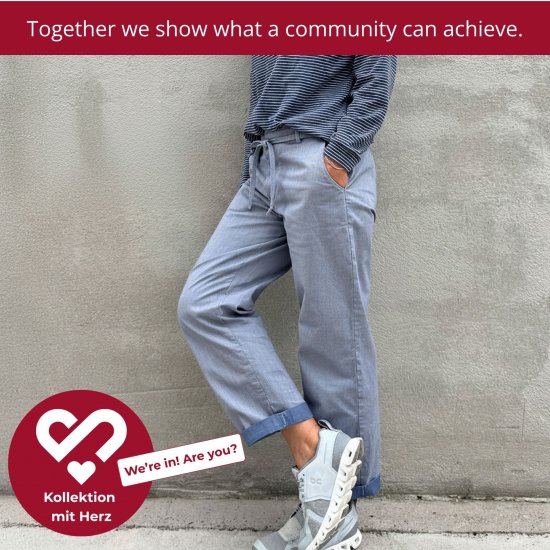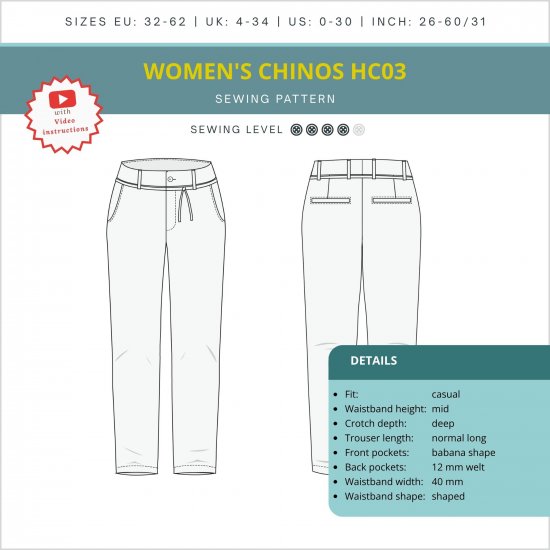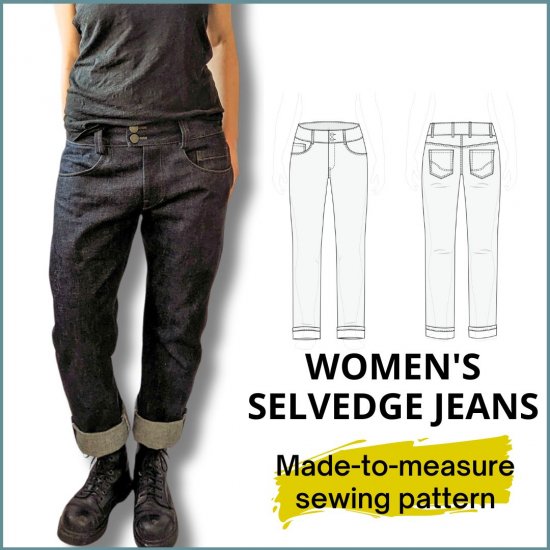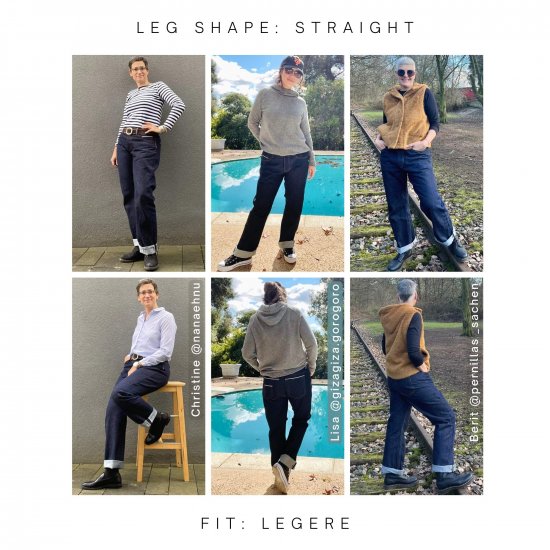Instructions for the pattern “Parka with hood JM02”

We’re delighted that you’re interested in the smartPATTERN parka with hood jm02 pattern or that you’ve perhaps already bought it as a pattern!
The parka is part of the first collection with a heart. A little more about this below…
In this guide, you will find all the information you need to create your new hooded parka step by step.
Take a look at our FAQ – there you will find answers to many questions, tips on buying fabrics and accessories, etc.
If your questions are not answered there or you have feedback for us, please send us an e-mail to hallo@smartpattern.de.
Note for customers outside the EU, GB and CH
For tax reasons, we do not sell the patterns in our online store to all countries outside the EU, Great Britain and Switzerland. You can find a list of which countries are activated in the online store here. We are happy when customers from other countries visit our Etsy store.
The collection with a heart…
… is a joint project by designer Carolin Behrens (formerly Hugo Boss), great pattern labels and the sewing community.
From the 01.11. until 31.12.2025 we are jointly making 12 exclusive women’s patterns available free of charge. We want to show how much creativity and solidarity there is in our community – and do good at the same time.
How you can take part
- Sewing – Realize your project.
- Share – Post your finished garment on social media, blogs or with friends. On the website you will find banners, badges & logos.
- Make it visible – The more people know about it, the greater the impact.
- Donations (voluntary) – 100% of all contributions go to SOS Children’s Villages, securely and transparently via betterplace.org.
Every donation, no matter how small, helps to support disadvantaged children and families.
Why the instructions are only available online
We have deliberately decided to make our instructions available online only. This saves a lot of paper, because not everyone wants to use printed instructions. You can also zoom in if you can’t see something straight away or the font is too small. Of course, you can also print out the individual instructions if you wish. To do this, use the corresponding print options in your internet browser. In many browsers, it is also possible to save the respective page so that it is available offline. This means you don’t always need an internet connection while you’re sewing and you can still save yourself the trouble of printing out on paper.
Sizes and measurements
Size selection
Choose your size based on your chest measurement. If you are between two sizes, you can choose the smaller one. The parka has an oversized fit, so it is cut very generously. Use the finished measurements in the table below as a guide and compare them with the measurements of an existing, well-fitting jacket if necessary.
If you are significantly larger or smaller than indicated in the body measurement chart and/or your arm length differs, you may need to adjust the length of the pattern. The best way to do this is to cut the pattern pieces of the front and back below the bust dart at a right angle (90°) to the grain – in the case of the sleeves, approximately in the middle of the sleeve – and then pull them apart or slide them over each other. Then match up the side seams. You can find numerous instructions on the internet.
Body measurement chart
You will find a body measurement table here that you can compare with your own measurements. Click on the button for instructions on how to take the right measurements.
All measurements are given in cm! If you want to convert to inches, divide the values by 2.54.
| US Size | 0 | 2 | 4 | 6 | 8 | 10 | 12 | 14 | 16 | 18 | 20 | 22 | |||
|---|---|---|---|---|---|---|---|---|---|---|---|---|---|---|---|
| UK Size | 4 | 6 | 8 | 10 | 12 | 14 | 16 | 18 | 20 | 22 | 24 | 26 | |||
| EU Size | 32 | 34 | 36 | 38 | 40 | 42 | 44 | 46 | 48 | 50 | 52 | 54 | |||
| Body height | 167 | 167 | 168 | 168 | 169 | 169 | 170 | 170 | 171 | 171 | 172 | 172 | |||
| Chest circumference | 79 | 82 | 85 | 88 | 92 | 96 | 100 | 106 | 112 | 118 | 124 | 130 | |||
| Waist circumference | 65 | 68 | 71 | 74 | 78 | 82 | 86 | 93 | 99 | 106 | 112 | 119 | |||
| Hip circumference | 88 | 91 | 94 | 97 | 101 | 105 | 109 | 115 | 120 | 126 | 131 | 137 | |||
| shoulder length to C7 | 17,4 | 17,8 | 18,2 | 18,6 | 19,1 | 19,6 | 20,1 | 20,8 | 21,5 | 22,2 | 22,9 | 23,6 | |||
| Arm length | 59,4 | 59,6 | 59,8 | 60 | 60,2 | 60,4 | 60,6 | 60,8 | 61 | 61,2 | 61,4 | 61,6 | |||
| Arm length to C7 | 76,8 | 77,4 | 78 | 78,6 | 79,3 | 80 | 80,7 | 81,6 | 82,5 | 83,4 | 84,3 | 85,2 |
Finished measurement table
We have listed some measurements of the finished jacket with hood in the finished measurements table. So you can easily compare them with the measurements of an existing, well-fitting jacket.
Click on the button to see a sketch showing how the measurements are taken.
All measurements are given in cm! If you want to convert to inches, divide the values by 2.54.
| US Size | 0 | 2 | 4 | 6 | 8 | 10 | 12 | 14 | 16 | 18 | 20 | 22 | |||
|---|---|---|---|---|---|---|---|---|---|---|---|---|---|---|---|
| UK Size | 4 | 6 | 8 | 10 | 12 | 14 | 16 | 18 | 20 | 22 | 24 | 26 | |||
| EU Size | 32 | 34 | 36 | 38 | 40 | 42 | 44 | 46 | 48 | 50 | 52 | 54 | |||
| Back length | 85 | 85 | 86 | 86 | 87 | 87 | 88 | 88 | 89 | 89 | 90 | 90 | |||
| Chest width | 110 | 113 | 116 | 119 | 124 | 128 | 132 | 139 | 145 | 152 | 158 | 164 | |||
| Hem width | 123 | 127 | 130 | 133 | 137 | 141 | 146 | 151 | 157 | 163 | 168 | 174 | |||
| Sleeve length to CB neck | 79,4 | 80 | 80,5 | 81,1 | 81,9 | 82,6 | 83,3 | 84,2 | 85,1 | 86 | 86,9 | 87,8 |
Product description
The parka with hood has a very oversized and modern cut. It combines a modern cut with classic parka details. The parka is fully lined and the lining is open at the hem. It also has an underlap and overlap on the zipper and tabs on the sleeve hems to adjust the width.
The large cape yoke can be gathered using the sewn-in straps, giving the parka a completely different look.
The front pockets are particularly clever – you can reach in from both the top and the side, giving you a total of four pocket bags.
There are separate pattern pieces for the lining.
We recommend firm, not too thick fabrics for the parka, e.g. light denim, twill, oilskin, …
General information
Seam allowances
Our patterns already include all seam allowances. The standard seam width is 10 mm. We use narrower seam allowances at some seams on the parka with hood.
The seam lines are also visible in the paper pattern for the smallest size. You can determine the width of the seam allowances by measuring the distance between the seam line and the cutting line. The seam allowances are the same for all sizes.
If you have bought or would like to buy the pattern as a PDF file, please take a look at these instructions. There we explain how you can show and hide the seam and cutting lines for individual sizes in the PDF file.
Scope of delivery of the PDF pattern
You will receive the following files:
- the pattern as a PDF file in A4 format (2 sheets)
- the pattern as a PDF file in A0 format (2 sheets | The pattern is in A0 format in width, but can be longer – depending on how much space is required for the pattern pieces).
You will receive the pattern in two formats and can decide for yourself whether you want to print out the A4 file at home, glue it together and get started straight away. If you don’t feel like gluing, you can give the A0 file to a copy store or an online print shop and have a large pattern sheet created for you. Please note the additional printing and shipping costs of the respective provider.
You can open the PDF files with the free Adobe Reader.
Abbreviations
We use these abbreviations in our patterns:
VM | CF = center front
HM | CB = center back
RV | Zip = zipper
SN = side seam
Fabrics and materials
You will need the following materials to sew the parka with hood. You can find out how much fabric you need for your size and how long the zipper needs to be in the table below.
- Outer fabric: Wool or woven fabric, preferably without elastane, e.g. cotton, linen, oilskin, light denim, twill
- Lining fabric
- Fusible interfacing, e.g. Vlieseline G 405
- Edge tape 2 cm wide, e.g. Vlieseline T20
- Bias tape 1.2 cm wide, e.g. Vlieseline T12
- if necessary, cord for the hood and cape yoke if you don’t want to sew the ribbons yourself
- Zipper, length see table
- 7 snaps, approx. 15 mm diameter
- 4 buttons for the sleeve tabs
- Yarn matching your materials
![]() We generally recommend that you wash the fabric before sewing to prevent your finished parka with hood from shrinking later on. Therefore, wash the fabric in exactly the same way (temperature, spin cycle, etc.) as you will wash the finished garment later and follow the manufacturer’s instructions.
We generally recommend that you wash the fabric before sewing to prevent your finished parka with hood from shrinking later on. Therefore, wash the fabric in exactly the same way (temperature, spin cycle, etc.) as you will wash the finished garment later and follow the manufacturer’s instructions.
Take any shrinkage into account when purchasing the fabric! Unless otherwise stated for the respective fabric, assume an addition of 10 %, which should normally be sufficient.
To prevent or reduce bleeding on colored fabrics, you can add a dash of vinegar to the washing machine or water.
The following length specifications per size refer to the usable material width specified in the left-hand column, assuming that the fabric is plain-colored. If you choose a patterned fabric, you may need more fabric depending on the size of the pattern.
| US Size | 0 | 2 | 4 | 6 | 8 | 10 | 12 | 14 | 16 | 18 | 20 | 22 | |||
|---|---|---|---|---|---|---|---|---|---|---|---|---|---|---|---|
| UK Size | 4 | 6 | 8 | 10 | 12 | 14 | 16 | 18 | 20 | 22 | 24 | 26 | |||
| EU Size | 32 | 34 | 36 | 38 | 40 | 42 | 44 | 46 | 48 | 50 | 52 | 54 | |||
| Main fabric, 140 cm width | 279 | 288 | 304 | 304 | 310 | 325 | 364 | 369 | 373 | 384 | 393 | 410 | |||
| Pocket lining, 140 cm width | 158 | 158 | 163 | 163 | 169 | 169 | 219 | 219 | 235 | 235 | 239 | 239 | |||
| Interfacing, 90 cm width | 19 | 19 | 20 | 20 | 22 | 22 | 22 | 22 | 22 | 22 | 25 | 25 | |||
| Zipper length | 65 | 65 | 65 | 65 | 65 | 65 | 65 | 65 | 70 | 70 | 70 | 70 | |||
| Number of snap | 7 | 7 | 7 | 7 | 7 | 7 | 7 | 7 | 7 | 7 | 7 | 7 |
Print the pattern and prepare it for cutting
You can find out how to prepare your pattern for cutting in the instructions Preparing patterns in ready-made sizes. The first part explains how layer printing works for A4 and A0 files. If you have already printed out your pattern, you can start directly at point 7. This is about cutting out and sorting the pattern pieces.
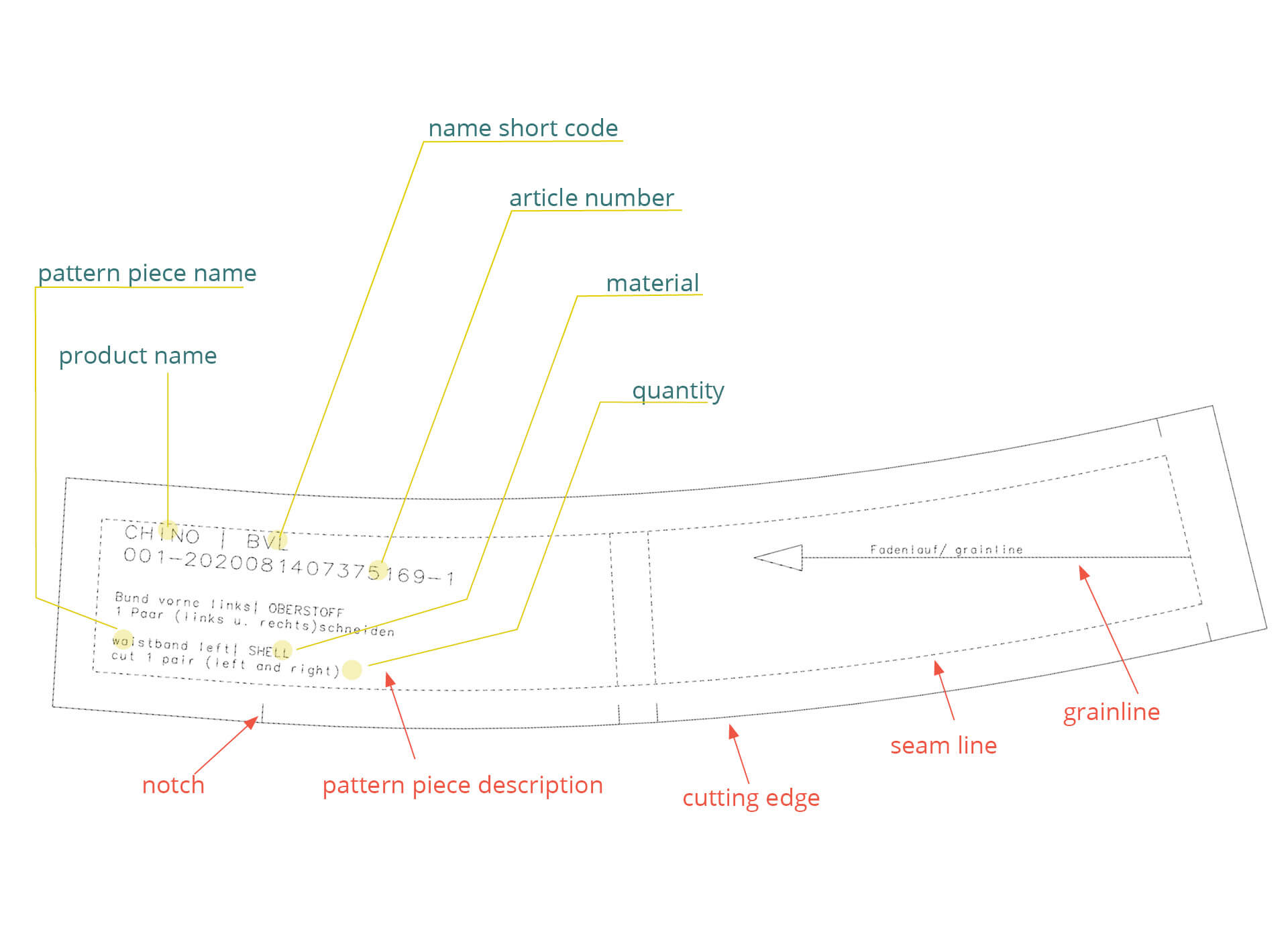
Here you can see an example of the labeling of a smartPATTERN pattern piece.

In the legend of your pattern sheet, you can see which line type (=cutting edge) you have to follow when cutting out your chosen clothing size.
Cutting
Below you will find some example cutting plans based on the fabric widths given in the material consumption table. If you are using a fabric that is narrower, you will most likely need more fabric and will have to arrange the pattern pieces differently. If your fabric is wider, you may need less length.
You can arrange the pattern pieces in advance on a large table or the floor, on which you mark your fabric width, to find out exactly what length of fabric you need. Remember to take into account any shrinkage values of the fabric!
The pattern pieces are placed on the open or folded fabric. The right side of the fabric, or in the case of the iron-on interlining, the side without the adhesive dots, should be facing upwards. You can see from the labeling on the pattern piece whether you need to cut a pattern piece individually or twice (as a pair or in reverse). You can find more information on this in the instructions for cutting fabrics and materials.
Cutting plans
Main fabric – size 38

Main fabric – size 46

Main fabric – size 54

Lining – size 38

Lining – size 46
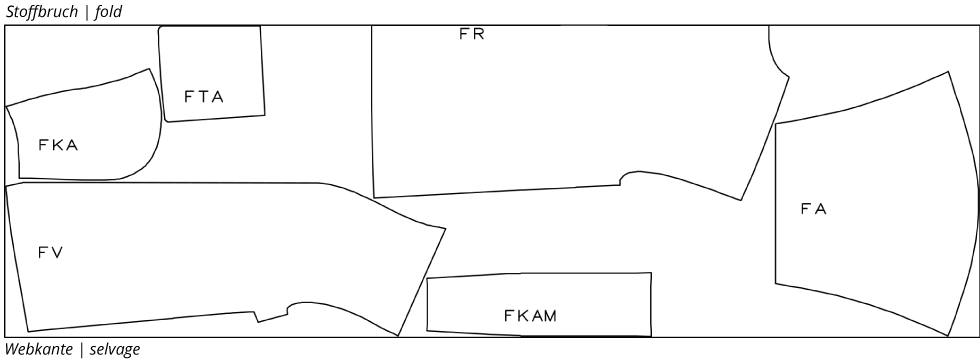
Lining – size 54

Interfacing – size 38

Interfacing – size 46

Interfacing – size 54

Sewing instructions
Once you have gathered all the necessary materials, prepared them, and cut out the hooded parka, you’re ready to get started! For a better overview, I will first show you a sketch of the parka as well as overviews of the necessary pattern pieces and accessories. Then I will explain step by step how to sew the parka.
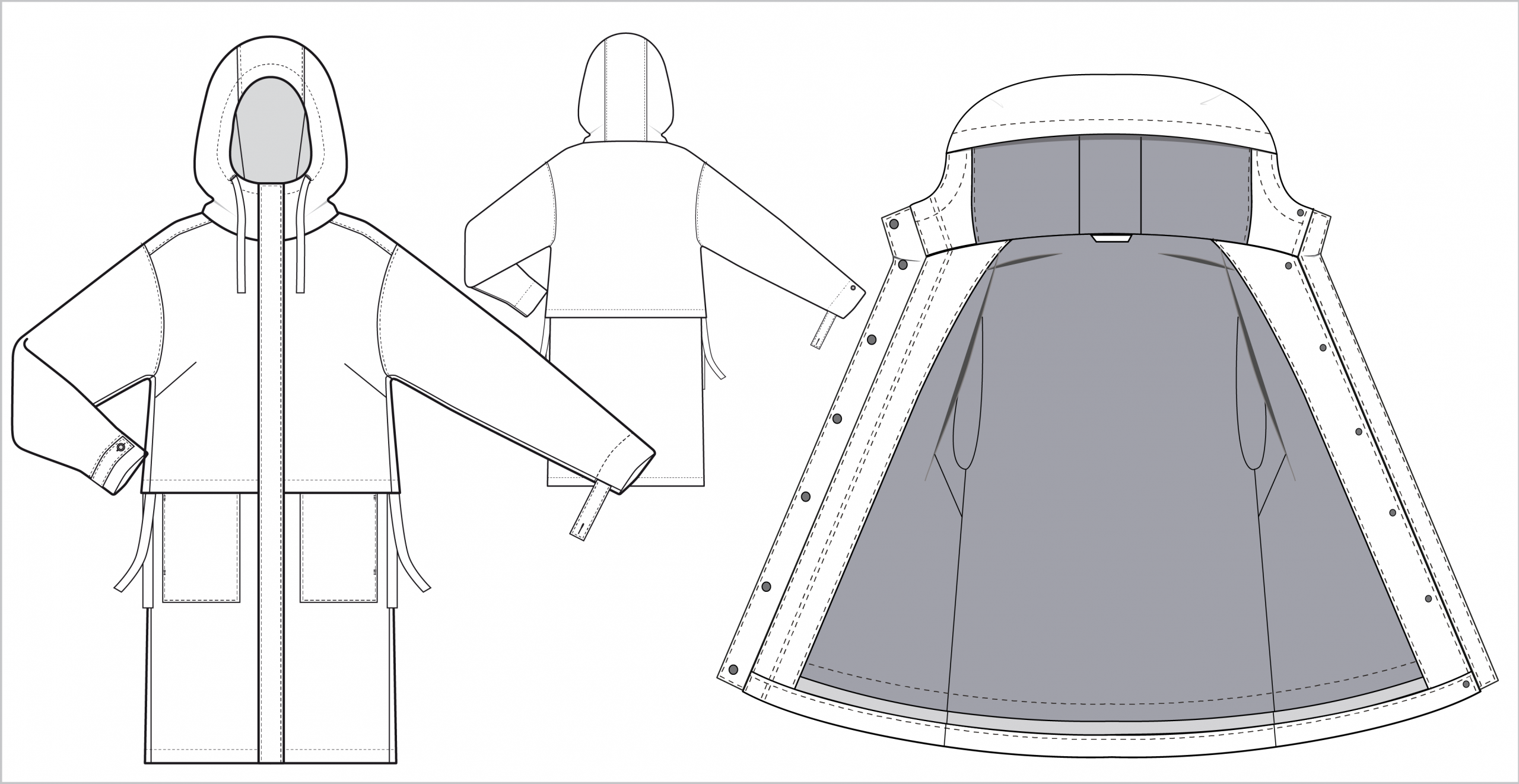
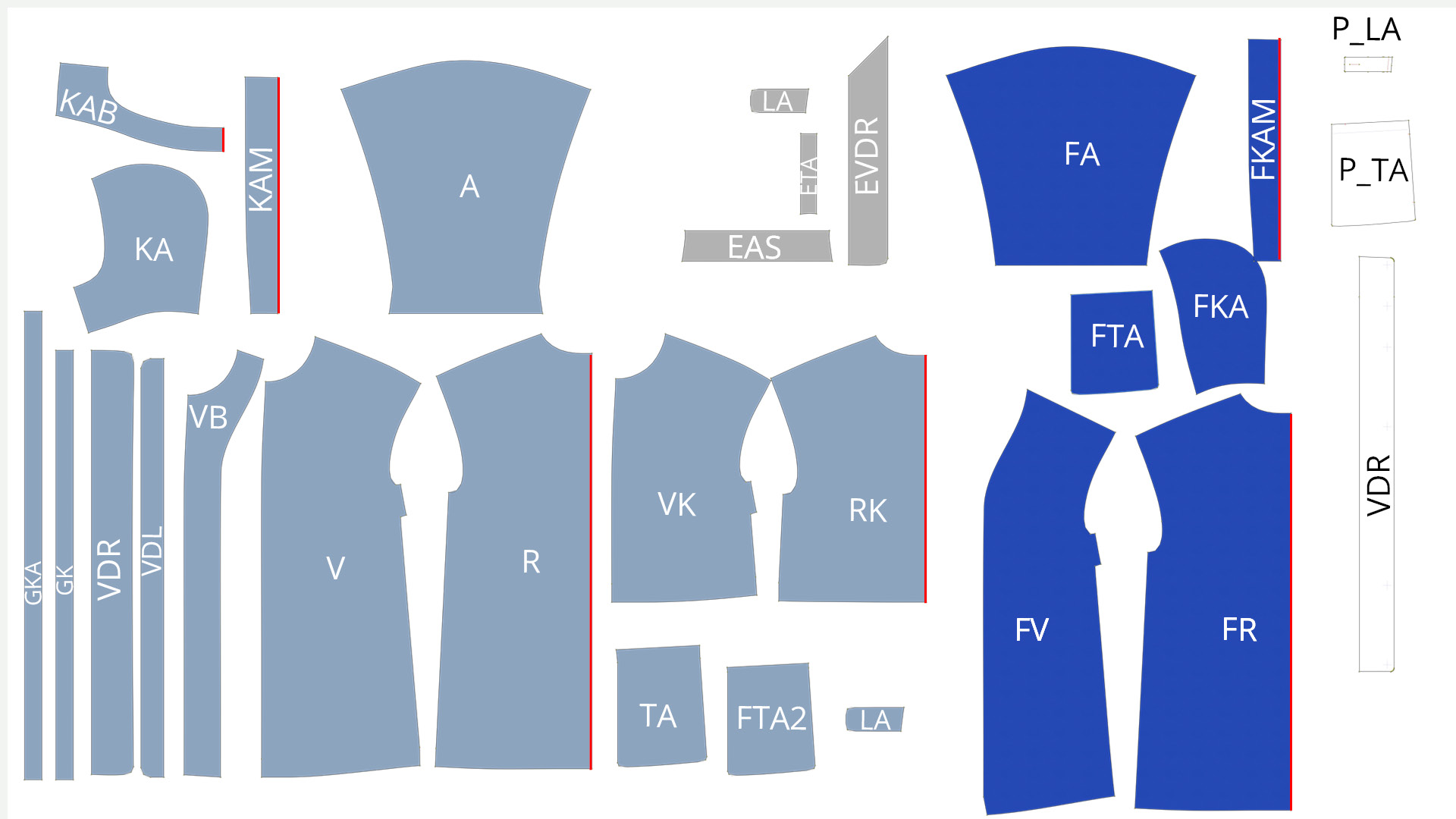
from outer fabric:
hood facing (KAB) – 1 on fold
hood (KA) – 1 pair
hood centre (KAM) – 1 on fold
sleeve (A) – 1 pair
hood strap (GKA) – 1 x
waist strap (GK) – 1 pair
overlap right (VDR) – 1 pair
underlap left (VDL) – 1 pair
front facing (VB) – 1 pair
front (V) – 1 pair
back (R) – 1 on fold
front cape yoke (VK) – 1 pair
back cape yoke (RK) – 1 on fold
patch pocket (TA) – 1 pair
inner layer patch pocket (FTA2) – 1 pair
sleeve tab (LA) – 2 pairs
made of paper:
ready sleeve tab (P_LA)
ready patch pocket (P_TA)
overlap right (VDR)
made from lining fabric:
sleeves (FA) – 1 pair
hood center (FKAM) – 1 on fold
patch pocket (FTA) – 1 pair
hood (FKA) – 1 pair
front (FV) – 1 pair
back (FR) – 1 on fold
from interfacing:
sleeve tab (LA) – 1 pair
patch pocket (ETA) – 1 pair
sleeve hem (EAS) – 1 pair
overlap right (EVDR) – 1 x
Additionally, if you have chosen a light or very stretchy fabric:
front facing (VT) – 1 pair
hood facing (KAB) – 1 on fold
underlap left (VDL) – 1 x

Tools and accessories:
bias tape, 12 mm wide, e.g. Vlieseline T12
edge tape, 20 mm wide, e.g. Vlieseline T20
safety pin
4 buttons for the sleeve tabs
7 snaps for overlap, approx. 15 mm diameter
zipper, length see measurement chart
hand measure or ruler
scissors
pins or clips
sewing thread and hand sewing needle if necessary
General information
The parka is fully lined. I chose the open hem finish because it gives the parka a nicer fit and a better drape. With this method, the lining can hang freely and is not sewn in too tightly or too loosely, which can lead to an unattractive appearance.
Therefore, only the side seams of the cape yoke, body and lining need to be finished. I like to finish seams that are overlocked or ironed in one direction together.
All other seams are between the outer fabric and the lining and will not be visible later. If you are using heavily frayed fabrics, I recommend neatening all raw edges during sewing.
In addition to the pre-cut pattern pieces, you will also need the following:
- 6 diagonal strips of lining, each 7 x 1.5 cm, to join the main fabric and lining; alternatively, you can also use a thin satin ribbon or similar
- 1 strip for the hanger made of main fabric, 3 x 15 cm; alternatively a ready-made ribbon
- 6 circles of main fabric, approx. 3 cm in diameter, to secure the pocket openings
- 6 strips of interlining, 3 x 2 cm, to fix the buttonholes on the hood and cape yoke
I will describe how to iron on the interfacing again in the individual sewing steps. Of course, you can also start by fusing the following parts of your parka with hood:
- upper pocket opening (pattern pieces TA and ETA)
- side pocket opening of pattern piece TA with edge tape
- sleeve hem (pattern pieces A and EAS)
- the lower side of the overlap, as this is where the snaps are worked in (pattern piece VDR + EVDR)
- the places on the cape yoke and hood where the buttonholes are to be worked in (see markings in the pattern)
- the outside of each sleeve tab
- on front pieces made from main fabric (pattern piece V): neckline, shoulders and armhole with bias tape
- on the back made of main fabric (pattern piece R): Neckline and armhole with bias tape
- Optional depending on the fabric used
- the upper side of the underlap (VDL)
- the upper side of the overlap (VDR)
- hood facing (KAB)
- front facing (VB)
Sew the front part and front collar of the parka with hood

If you have not already done so, secure the shoulder seams, neckline and armholes on the front pieces with a bias or edge tape, e.g. with Vlieseline T12. The front cape yoke pieces do not need to be fused unless you are using a fabric that stretches quickly.
Chest darts
Then sew the bust darts on both front pieces and the front cape yoke pieces according to the markings in the pattern. Always start sewing at the side seam and sew over the top of the dart without backstitching. The thread ends are then knotted well and cut off to approx. 2 cm.

The dart content is ironed upwards, i.e. towards the shoulder.
Sew patch pockets
The patch pockets have two openings, one from the top and one from the side. You have three pattern pieces per pocket bag, two from the main fabric and one from the lining fabric.
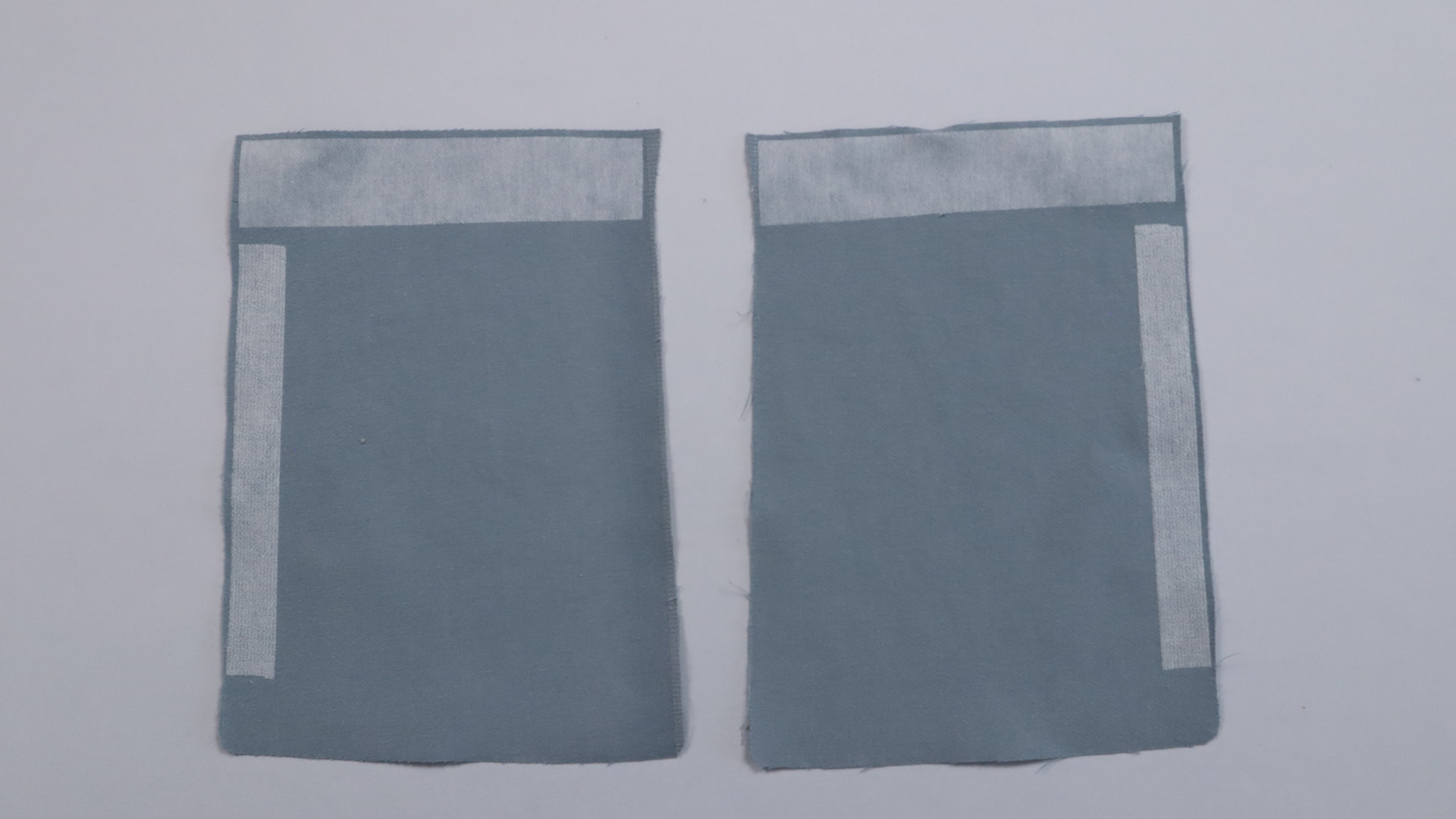
If you have not yet fixed the outer pocket bags (TA), you must do this now. Iron the ETA interfacing onto the top edge of the pockets. An edge band is ironed onto the side opening (on the shorter side). I like to use Vlieseline T20 for this. However, you can also cut a matching strip from the interfacing that you use for the other parts.
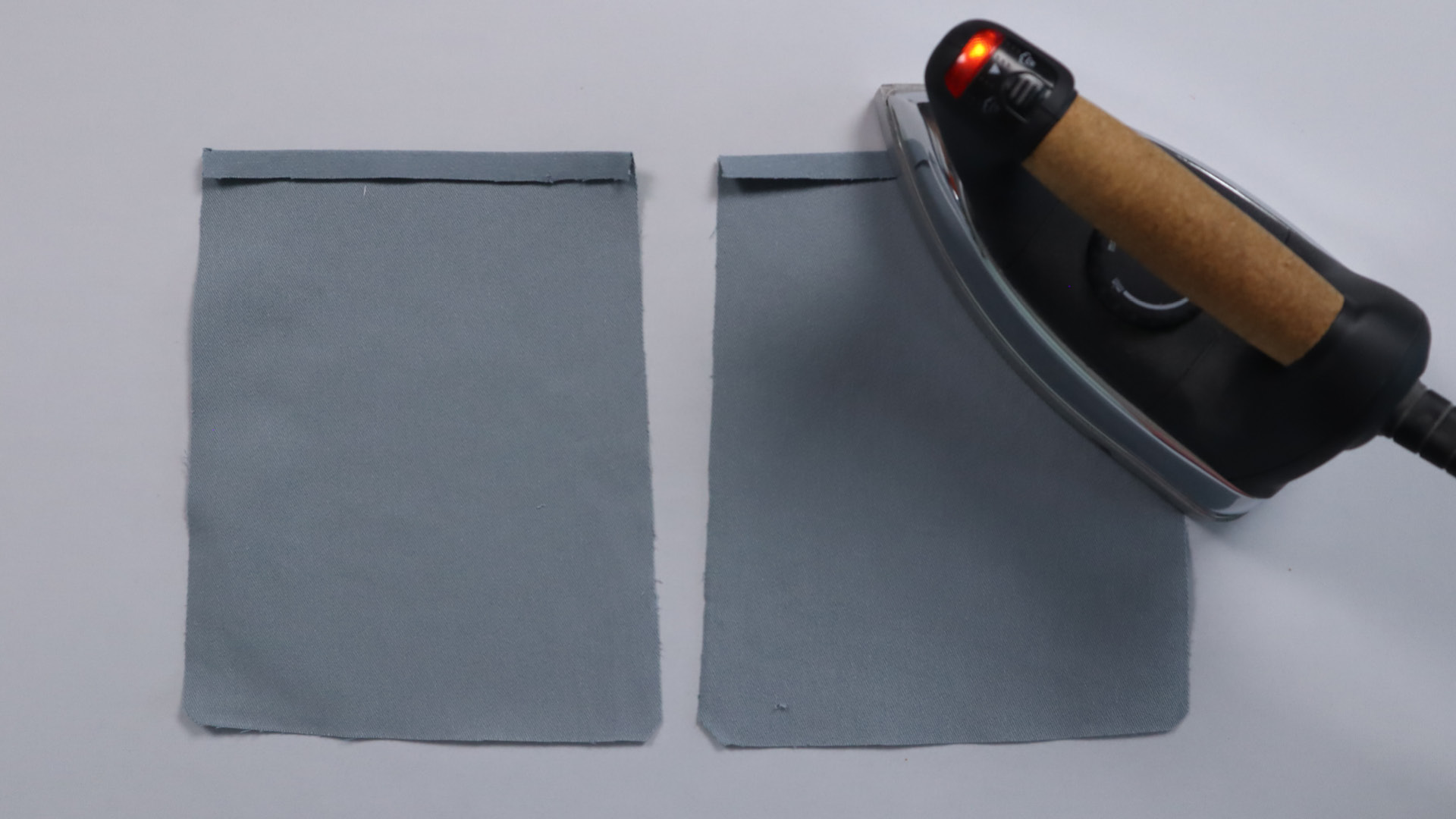
Press the top edge of the lower pocket bag (FTA2) 1 cm outwards, i.e. to the right side or wrong sides together.
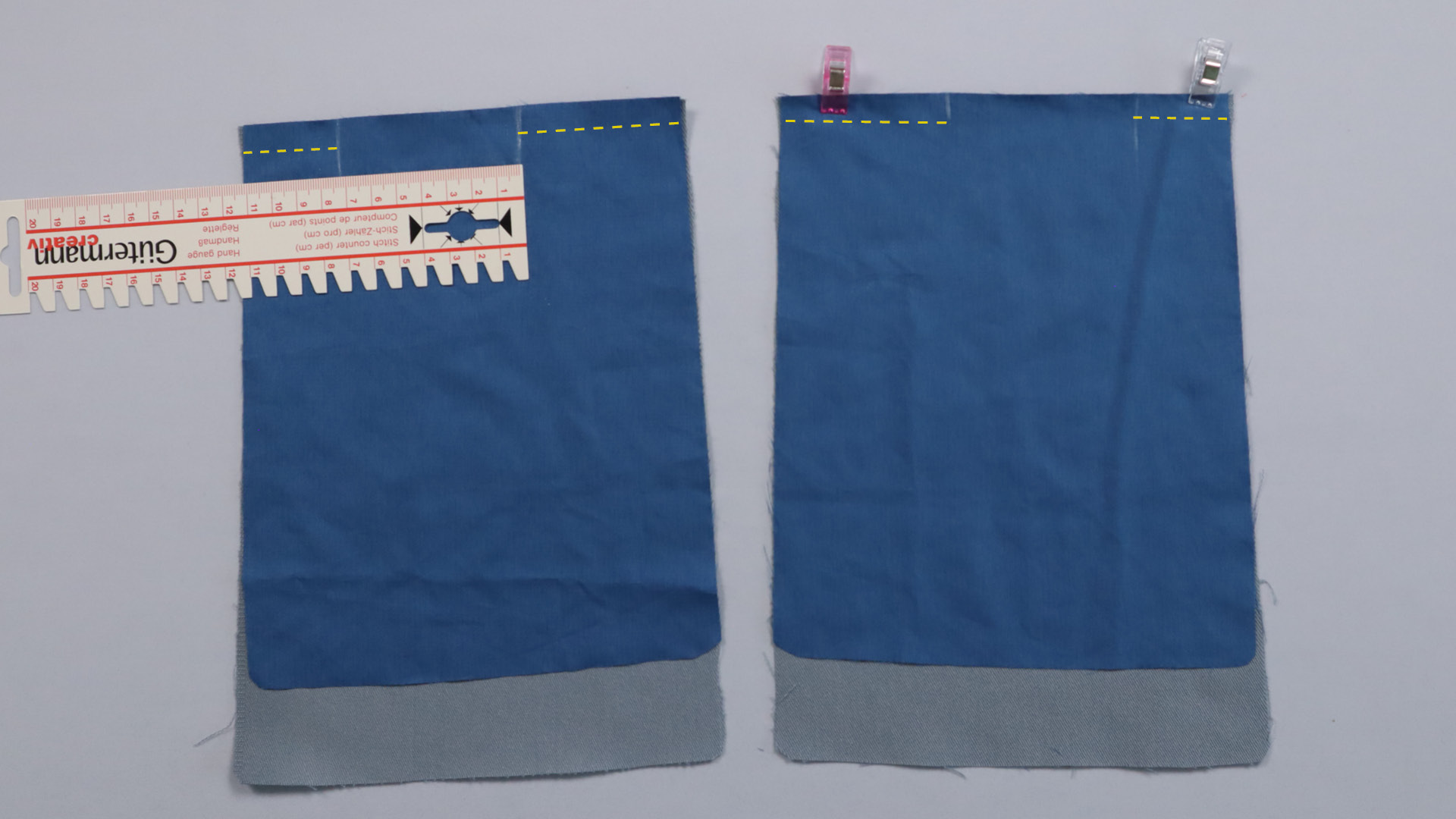
Place the lining pocket bags (FTA) on the upper pocket bag (TA) along the upper edge, right sides facing and sew together. Leave an approx. 6 cm turning opening in the middle.
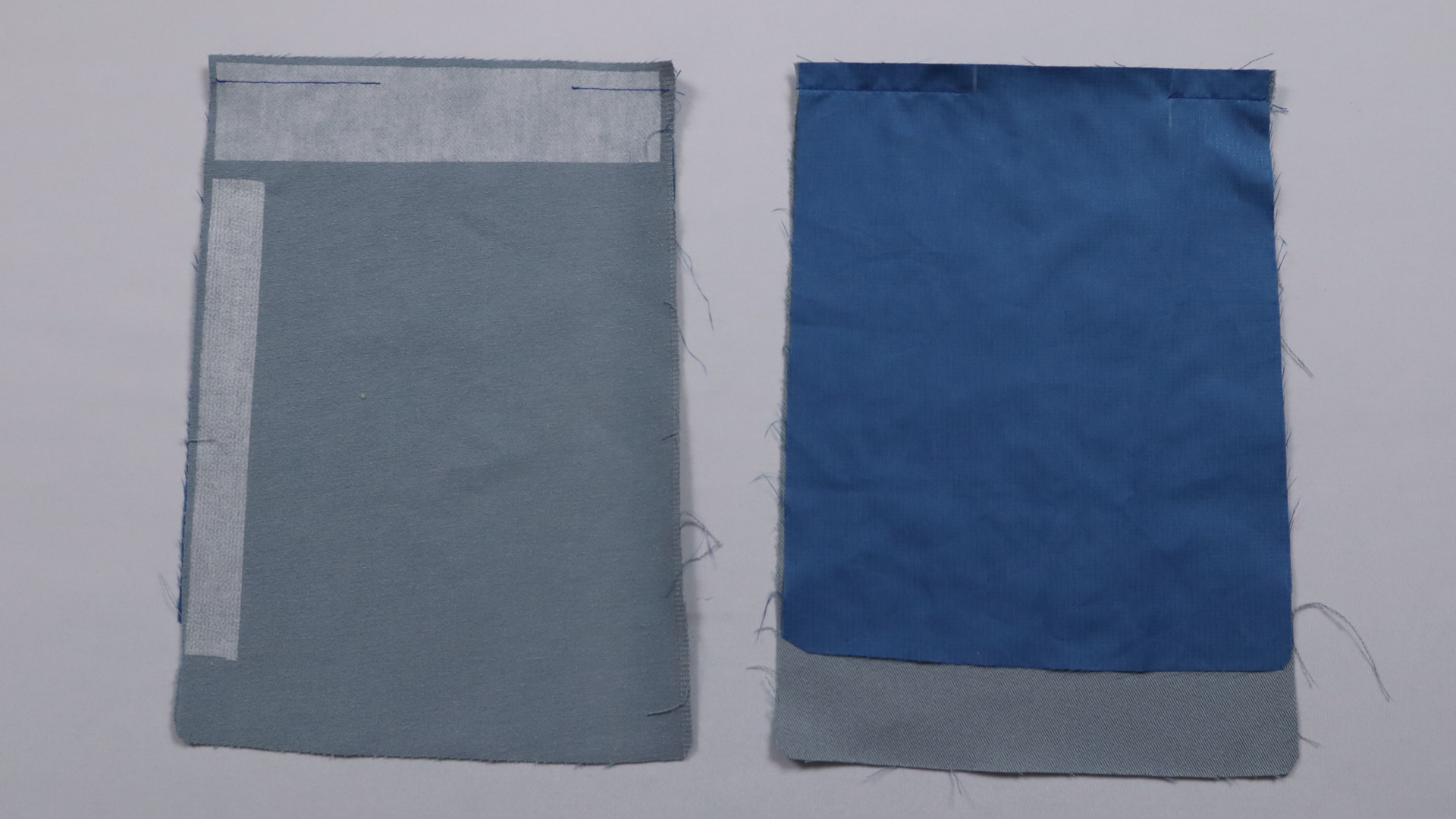
This is what the joined pieces with the turning opening look like. I press the seam allowances towards the lining and the upper pocket opening according to the notches.
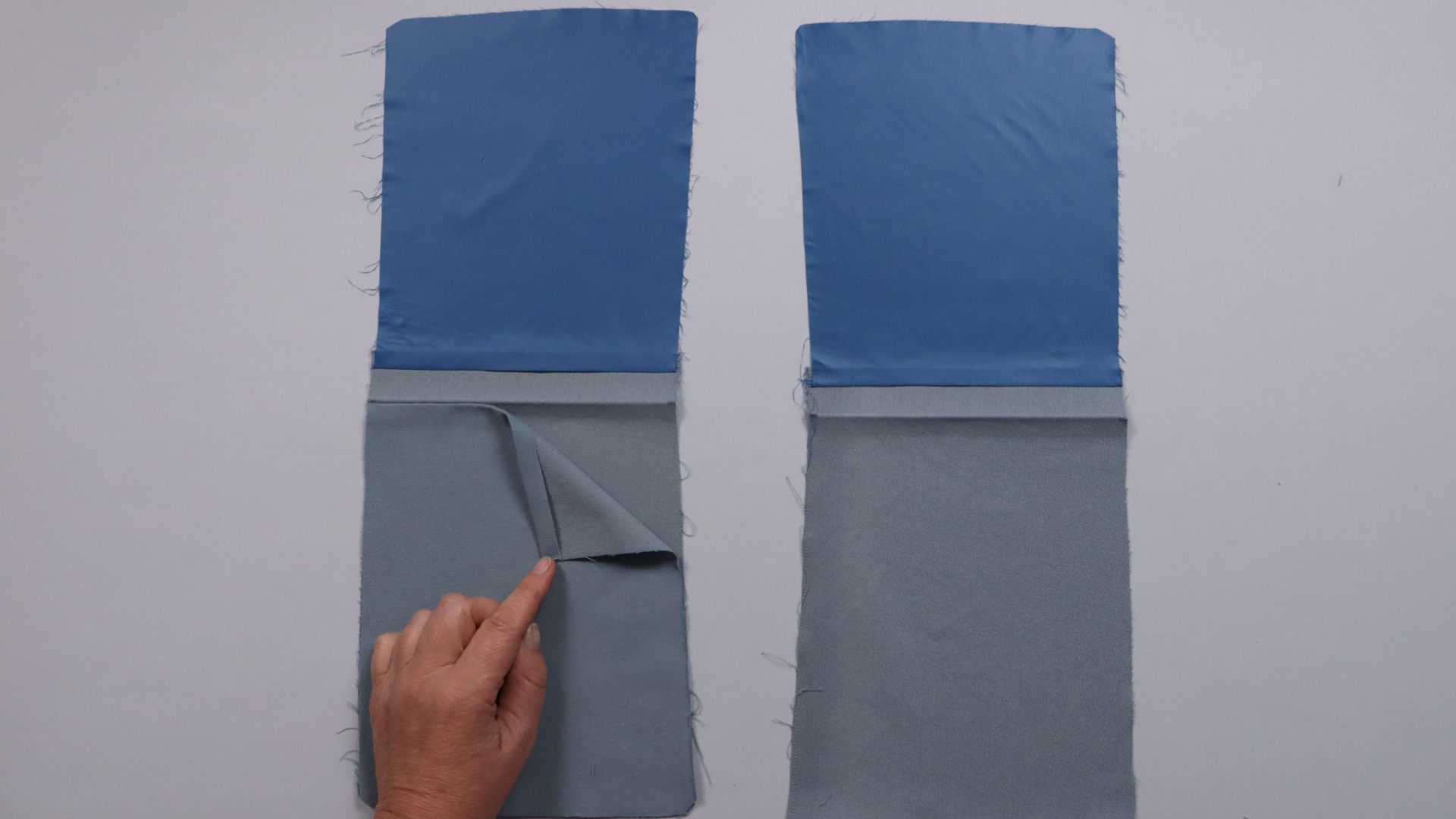
Then place the bottom pocket bag on top of the top pocket bag, right sides facing, so that the bottom edge and side edges are flush. The top edge is slightly below the ironed edge of the top pocket bag.

I fold the middle pocket bag made of lining fabric over the bottom pocket bag and pin all three layers together at the side and bottom edges.
You can already see in the picture that the lining fabric and the inner pocket bag made of outer fabric are slightly shorter at the bottom edge than the outer pocket bag. This is intentional so that the lining fabric is not visible later. When sewing, you must therefore pull the bottom edge slightly so that the corners are on top of each other.
I sew all three layers together with a 6 mm seam allowance.
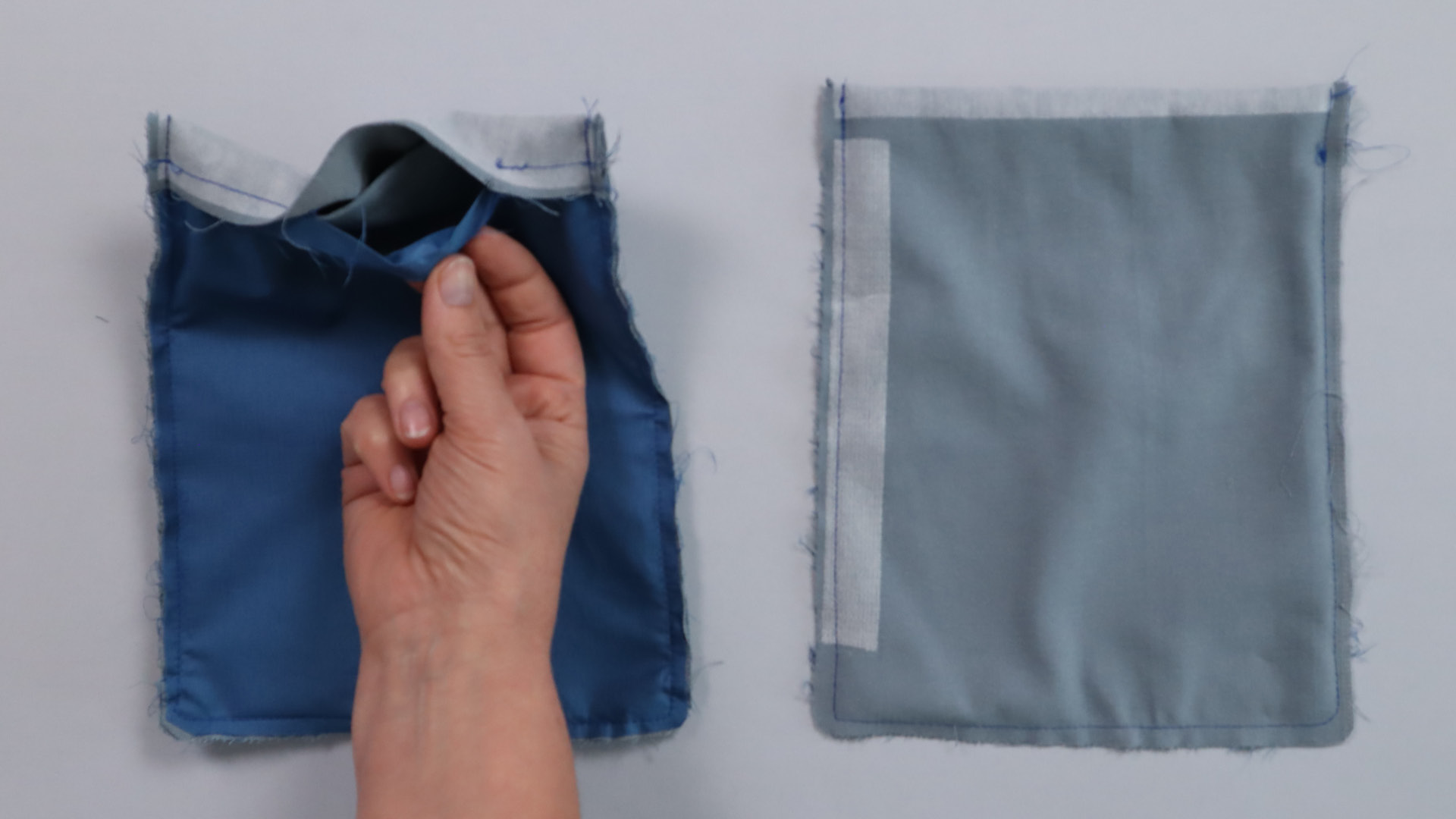
I then turn the pocket bags right side out through the opening.
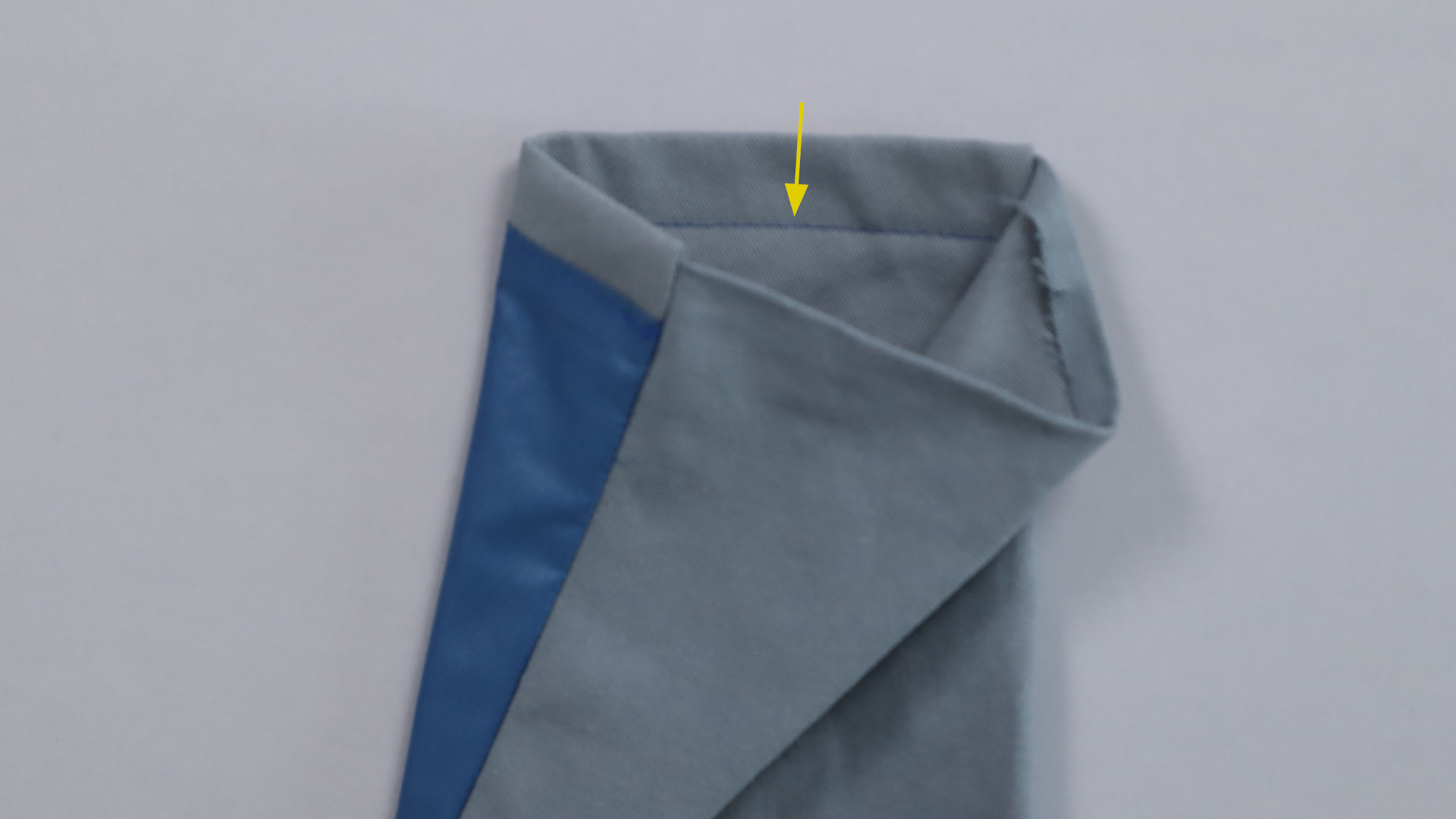
The top edge is topstitched with a 2 cm gap. The best way to do this is to turn the pocket bag as shown in the picture. The turning opening is closed directly.
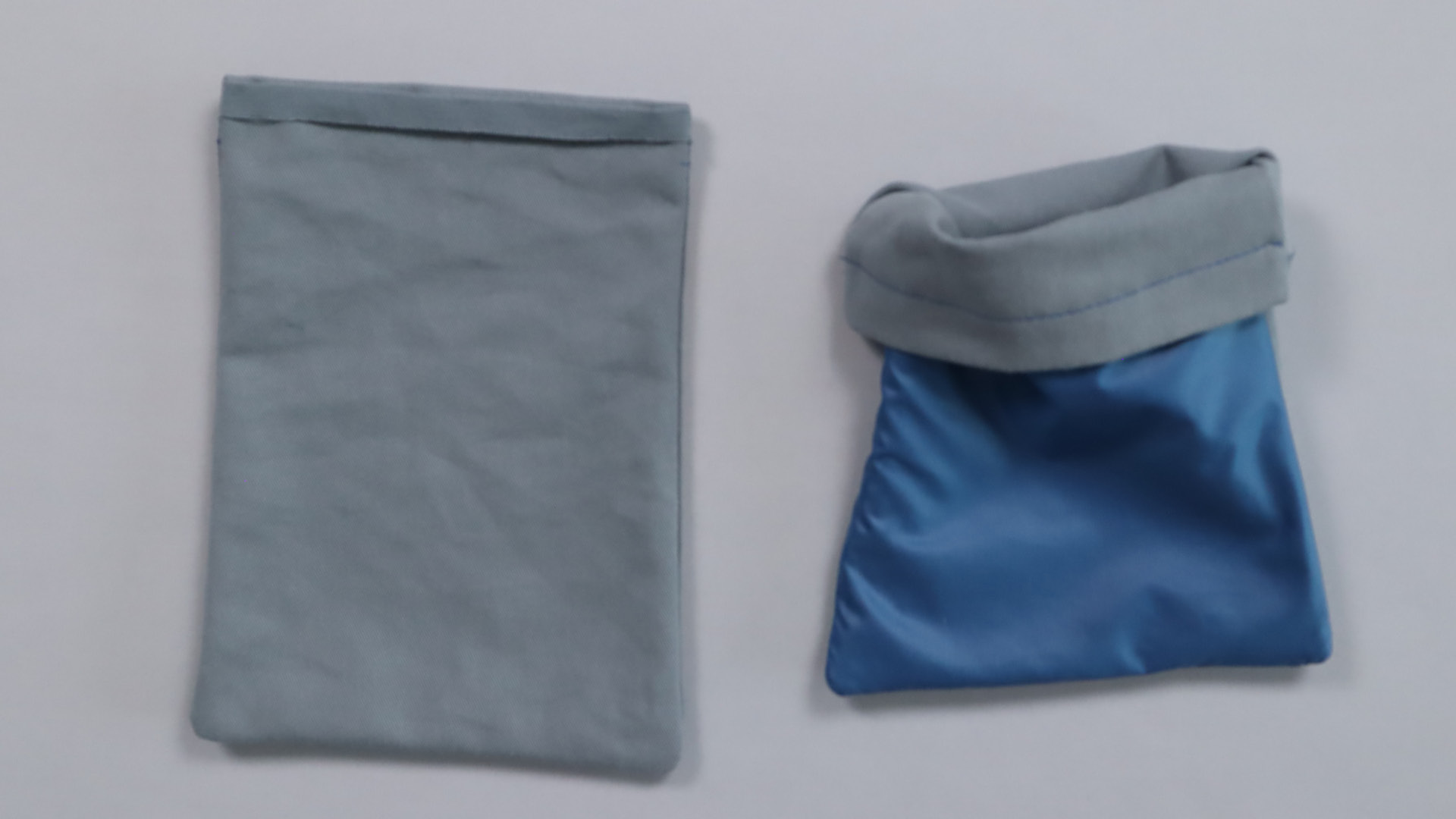
Then turn the pocket bags so that the lining side is on the inside.
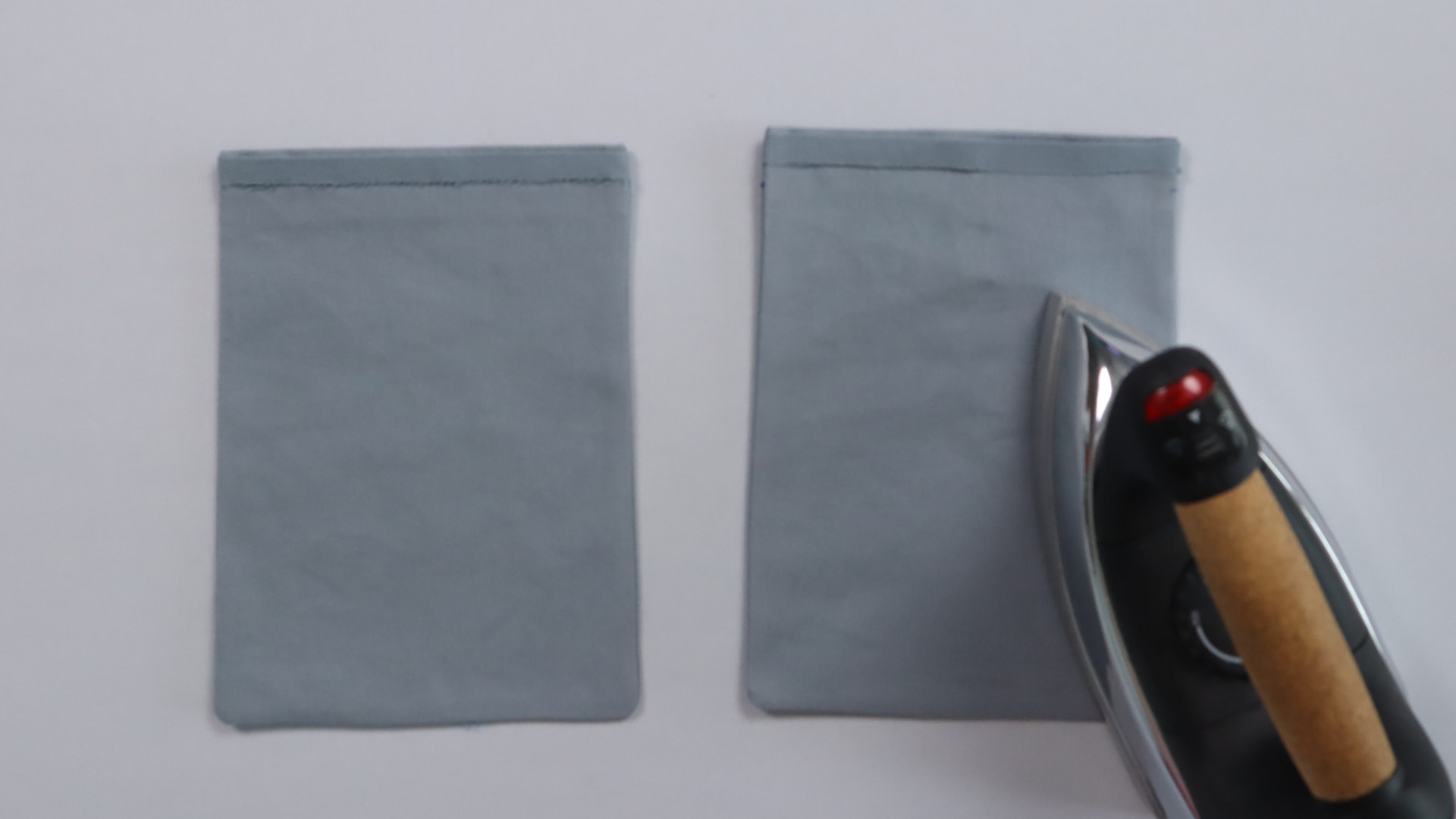
From the reverse side I iron the pockets smooth again.
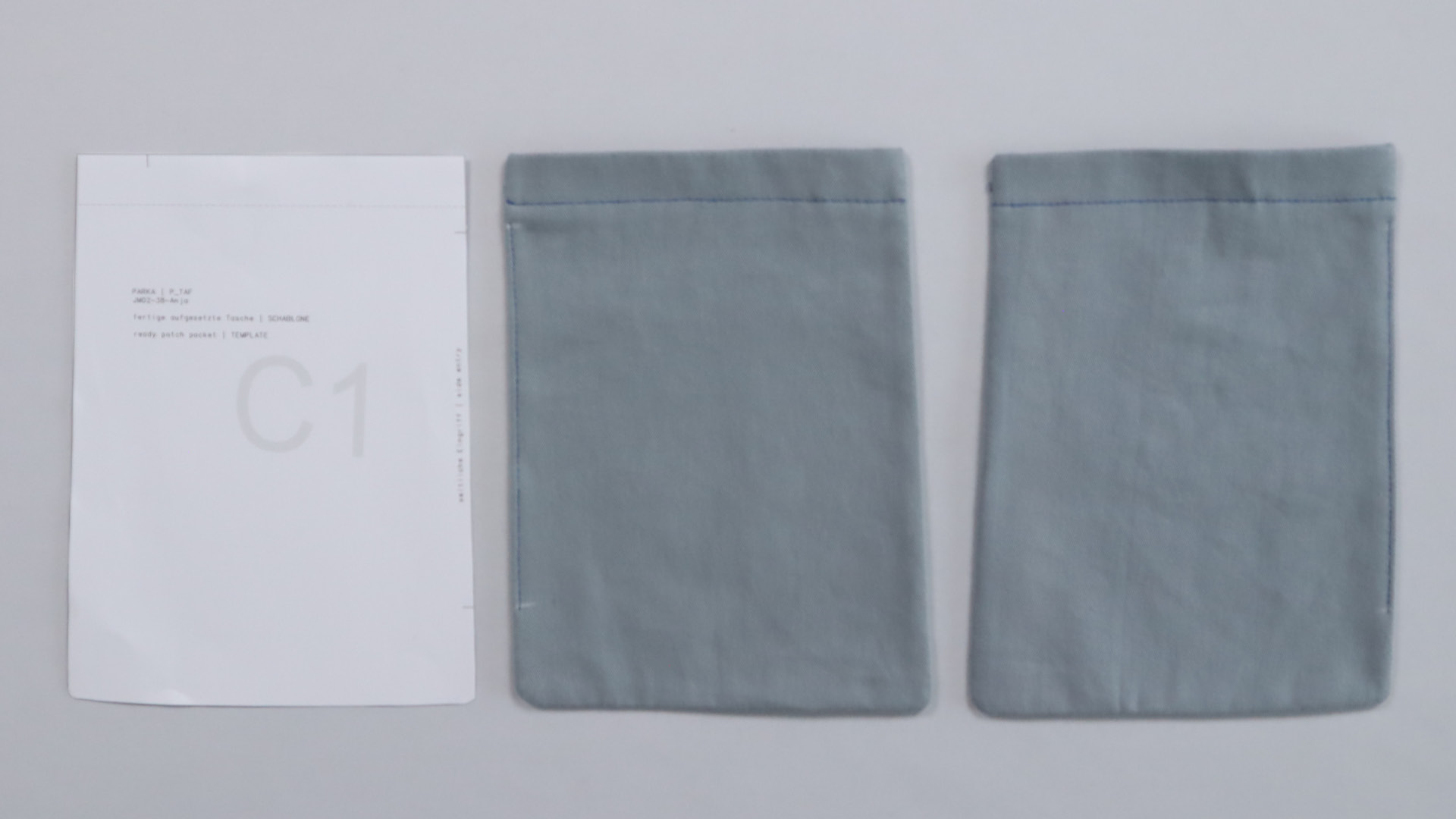
Then the pocket opening is topstitched. I transfer the position from the template and topstitch exactly between the markings.
Sew the pocket bags onto the front pieces

Using the pattern piece, I transfer the position of the pockets to the front pieces.
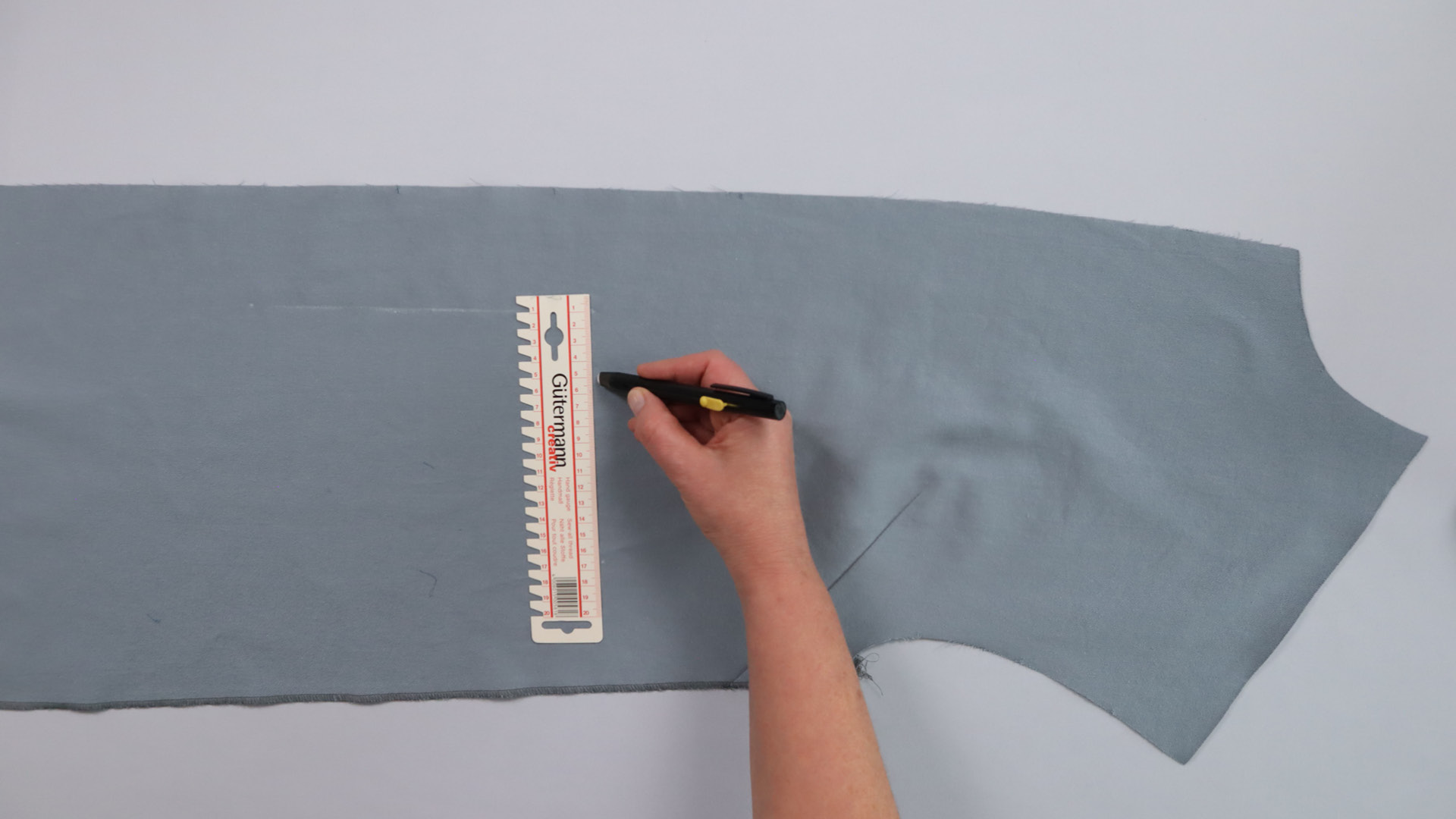
I connect the three marked points so that I can position the pockets straight.
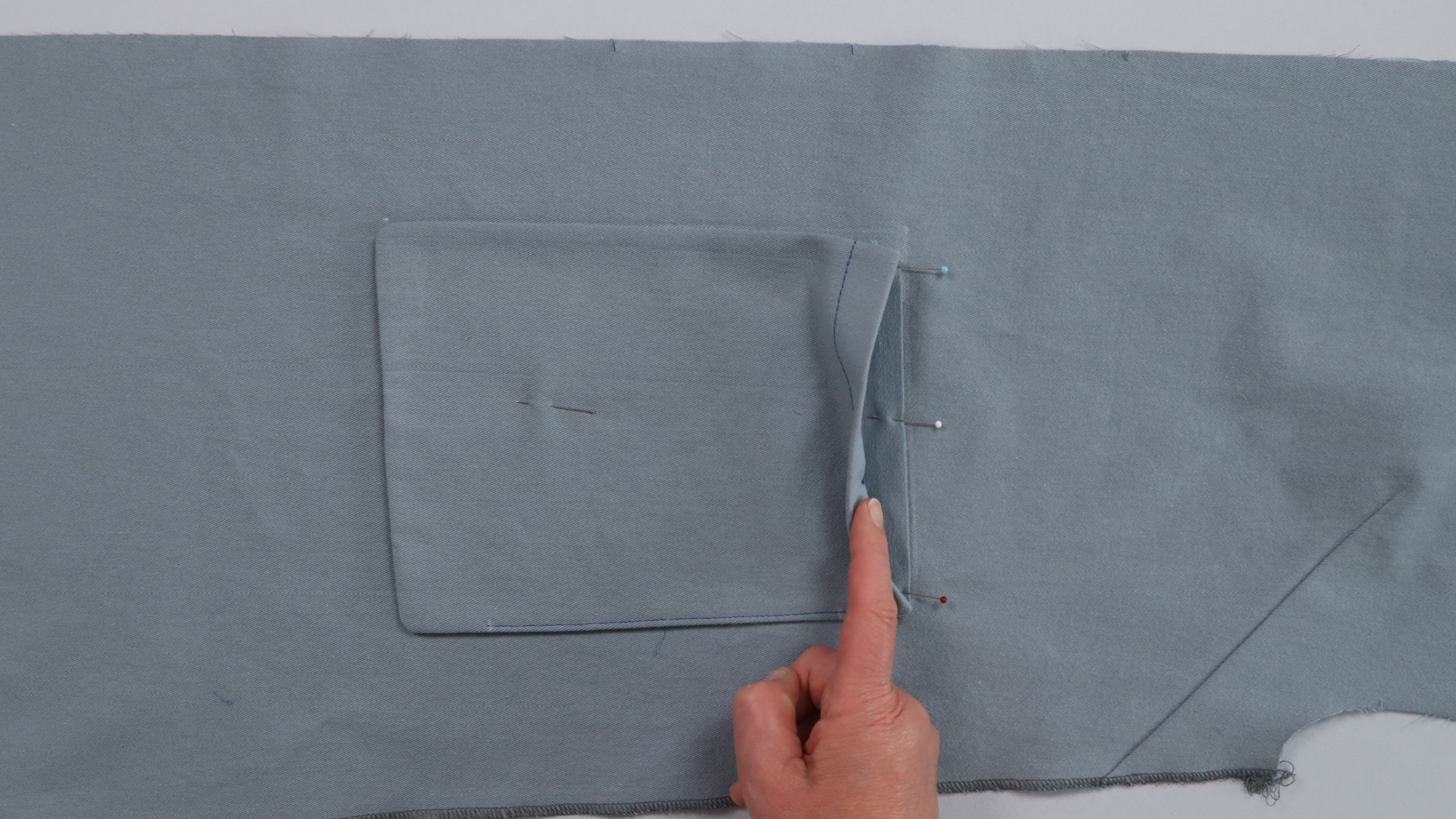
Then I pin the upper edge of the lower pocket bag to the marking. I secure the bottom of the pocket bag with a pin to prevent it from slipping.
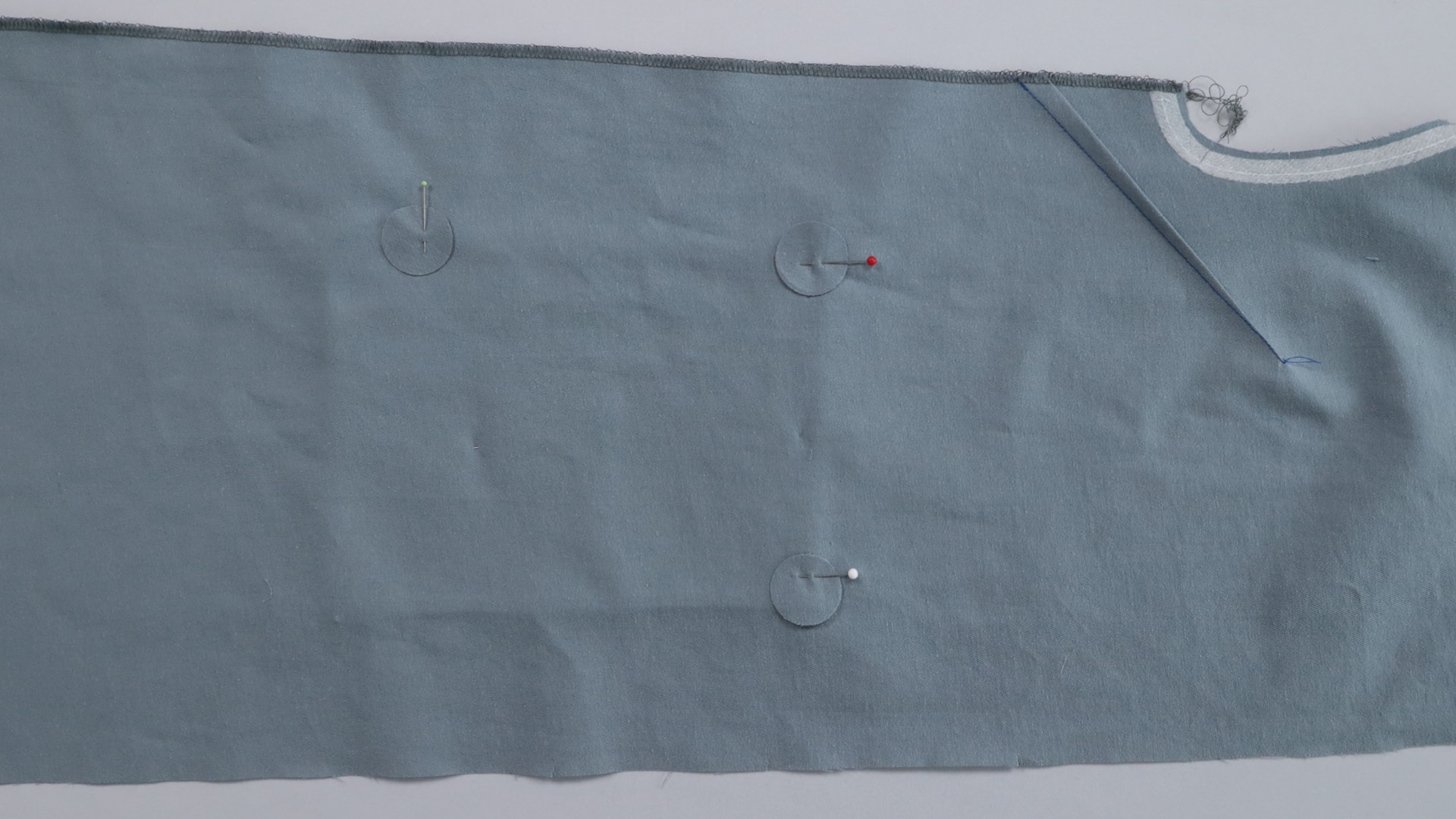
To prevent the pocket bags from tearing at the openings, I pin the prepared circles to the top and outer corners of the pocket bag on the back, as shown in the picture.

The lower pocket bag is then sewn onto the front piece close to the edge. Here you can already see the upper opening in the pocket bag.

Now I pin the pocket bags all the way around and check again that they are positioned the same on both sides. If this is not the case, you may have to undo the last seam and realign the pocket bags.
The pocket bags can then be topstitched to the front pieces from the right side. I leave out the top edge and the side opening, which has already been topstitched. I carefully lock the seams at the beginning and end.
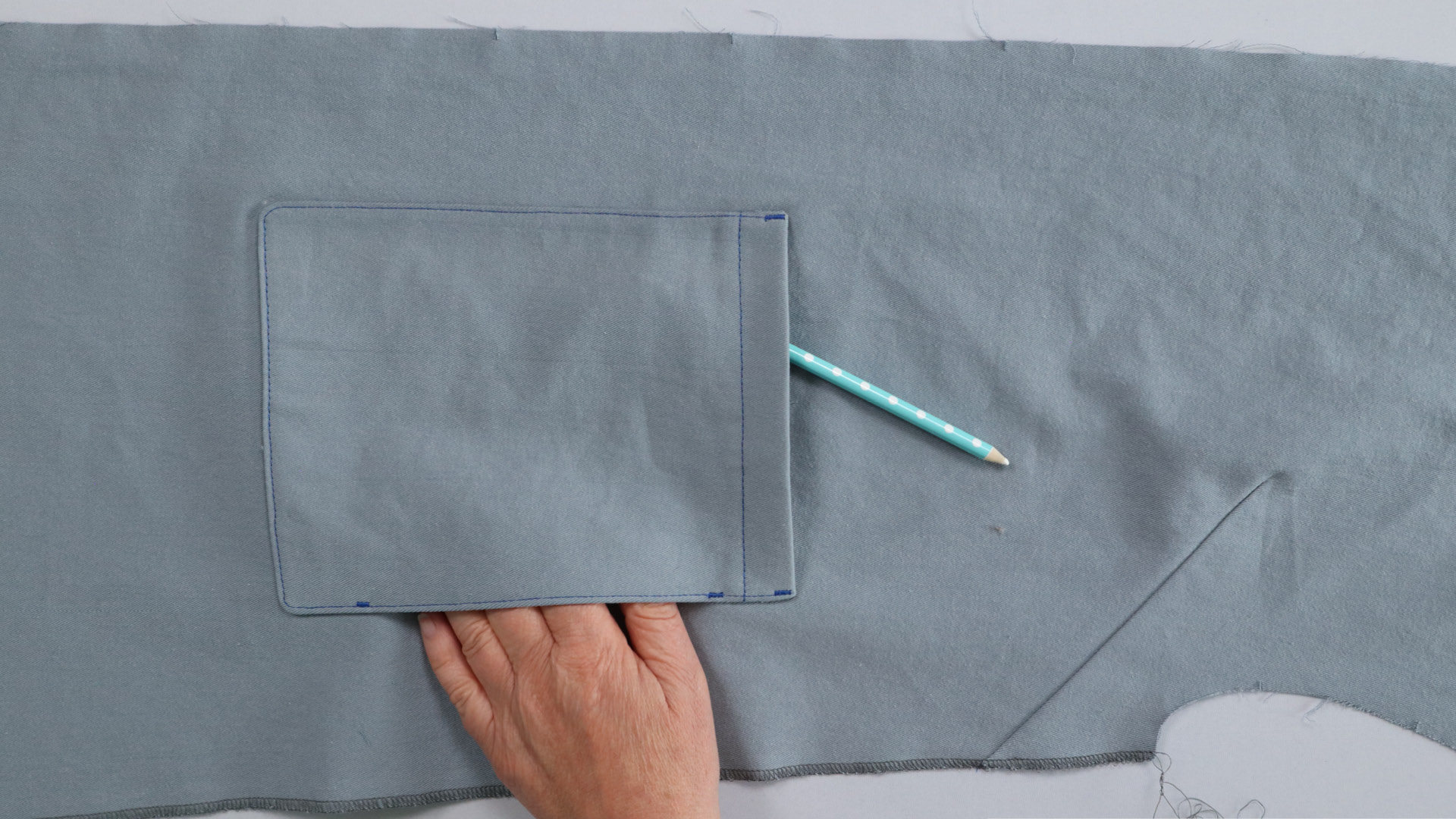
Here you can see the finished pocket, into which you now reach from above and from the side into different bags.
Sew the ribbons for the cape yoke and hood
If you want to use ready-made cords or ribbons, you can cut them to the same length as the pattern pieces. I will now explain how to sew the fabric ribbons yourself.
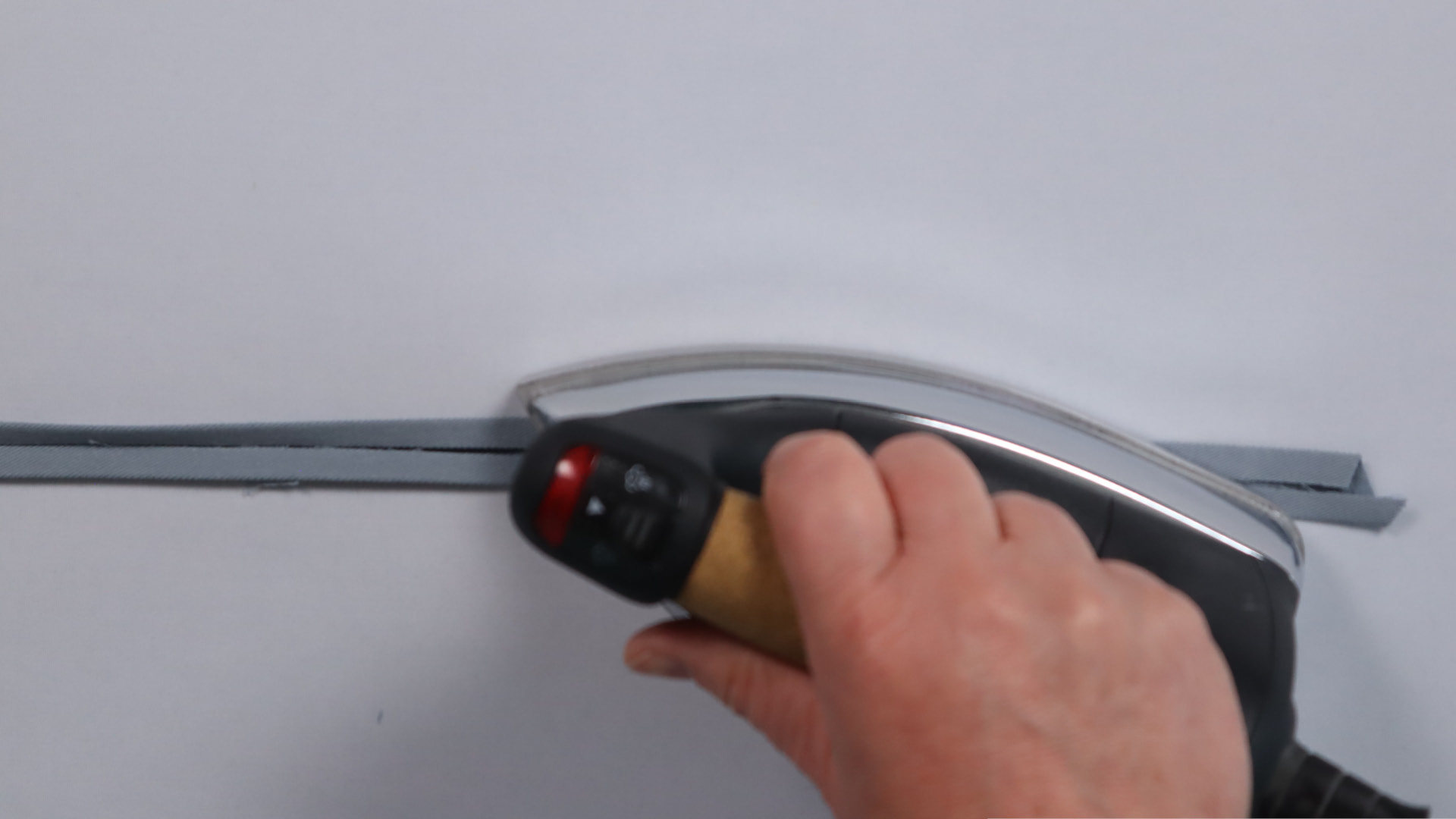
You have two pattern pieces labeled “GK” for the cape yoke bands and one pattern piece labeled “GKA” for the hood band.
The ribbons are ironed in the same way as you are probably familiar with bias tape. First iron the two long edges to the center.
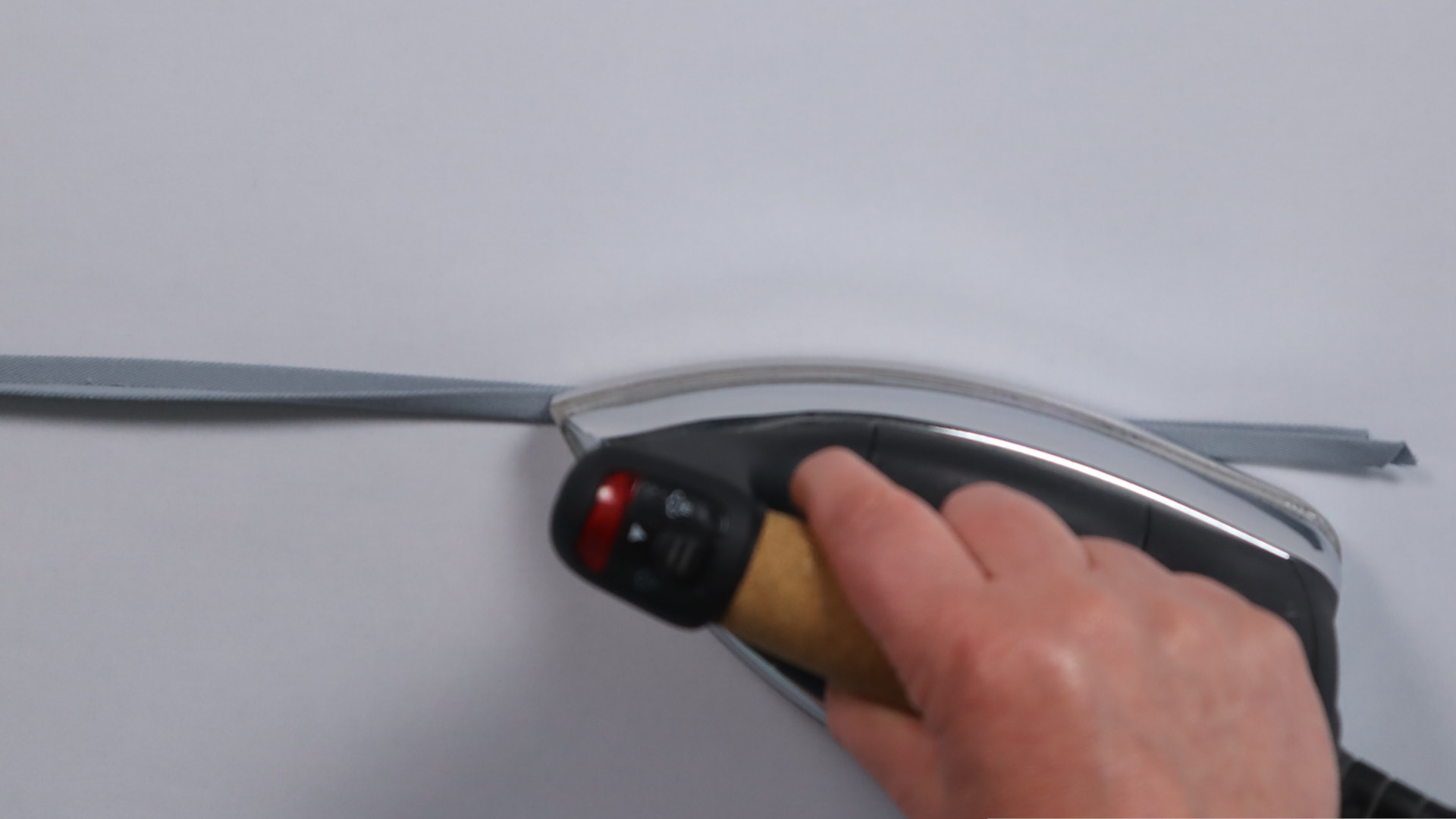
The ribbons are then folded twice and ironed well again.
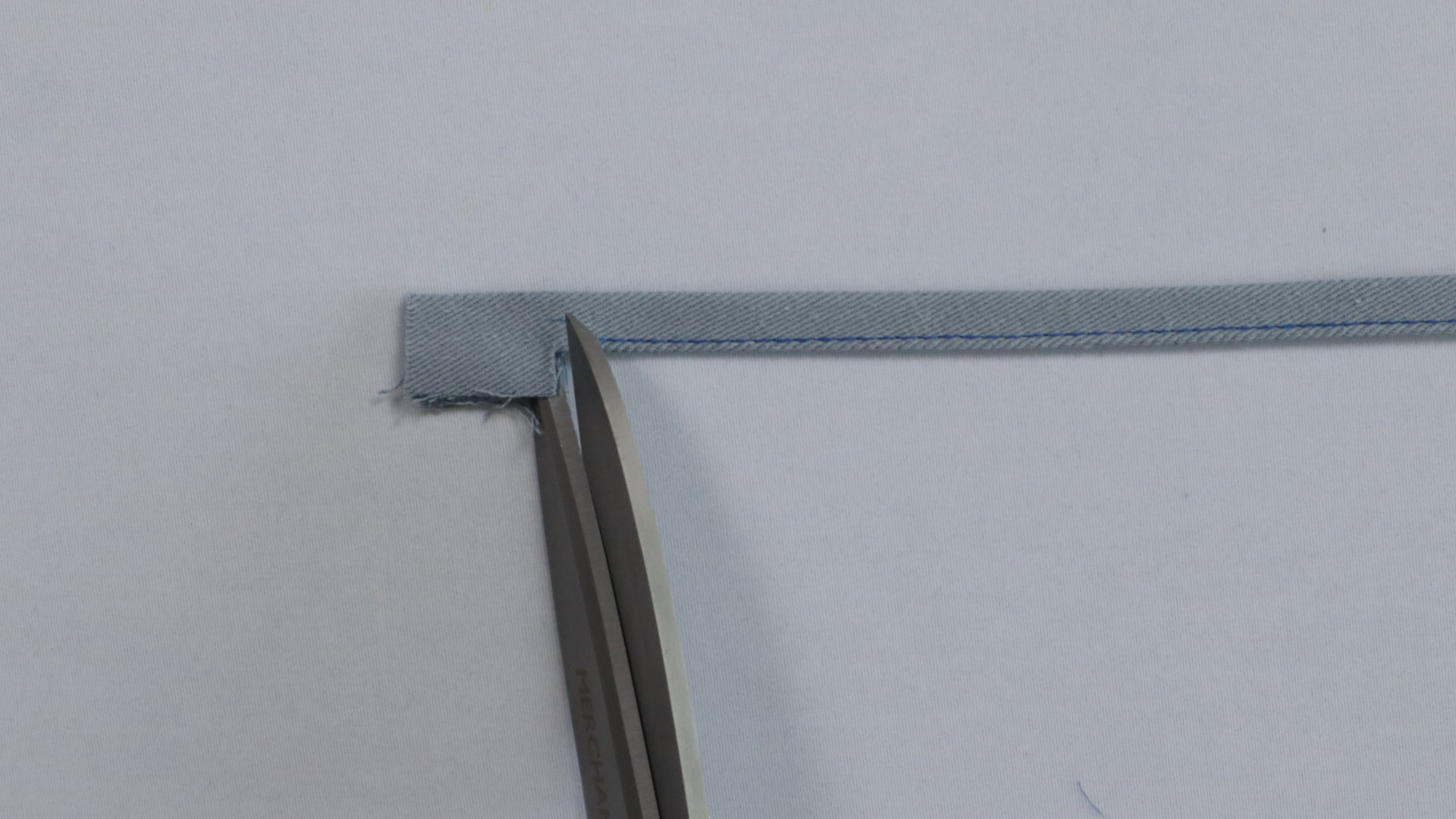
Now the open long edges are stitched close together. I leave approx. 2 cm at both ends of one of the two “GK” tapes. There I cut the folded edges as shown in the two pictures above and below and unfold them.
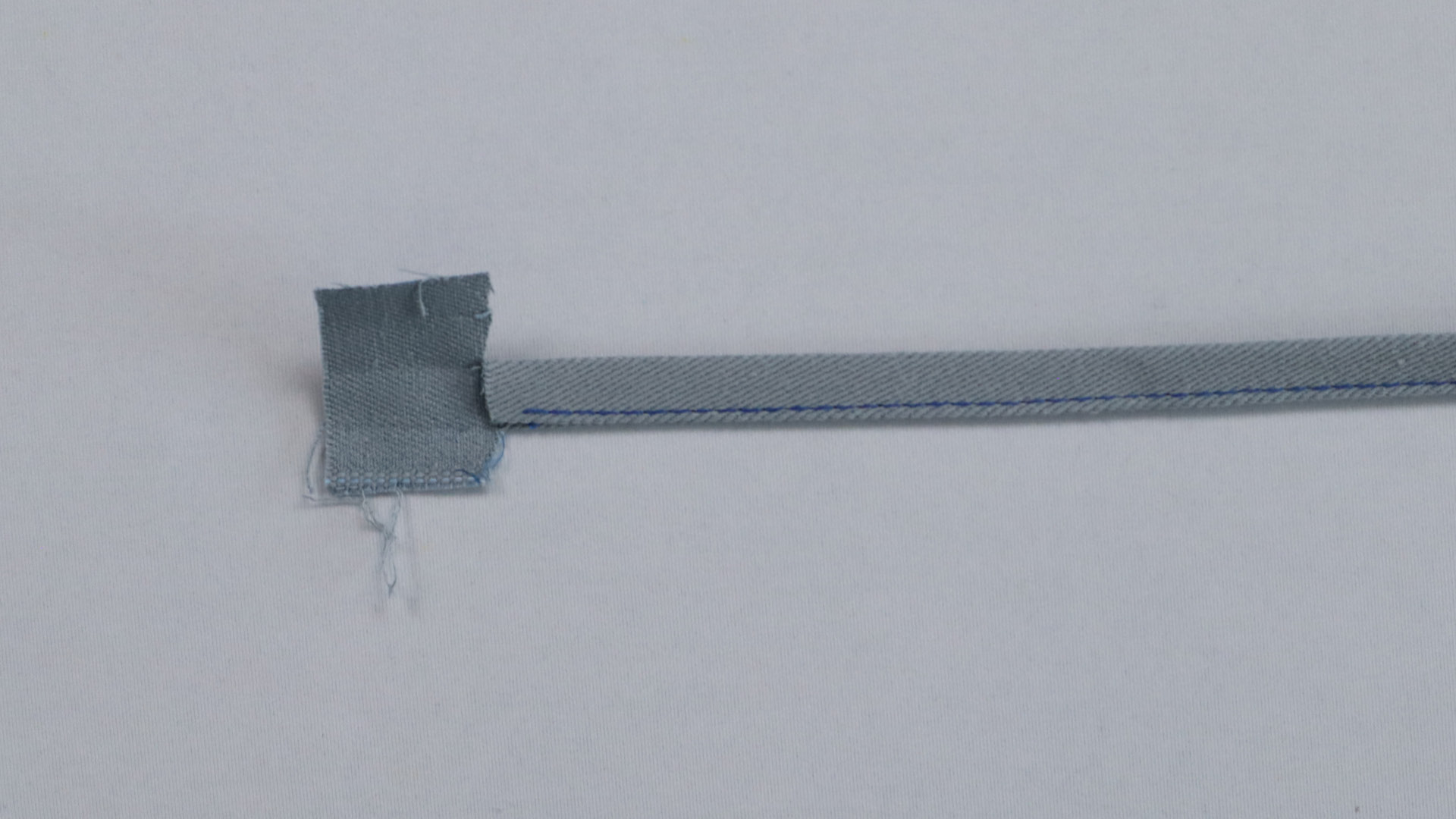
This allows me to sew this part flat in the front cape yoke.
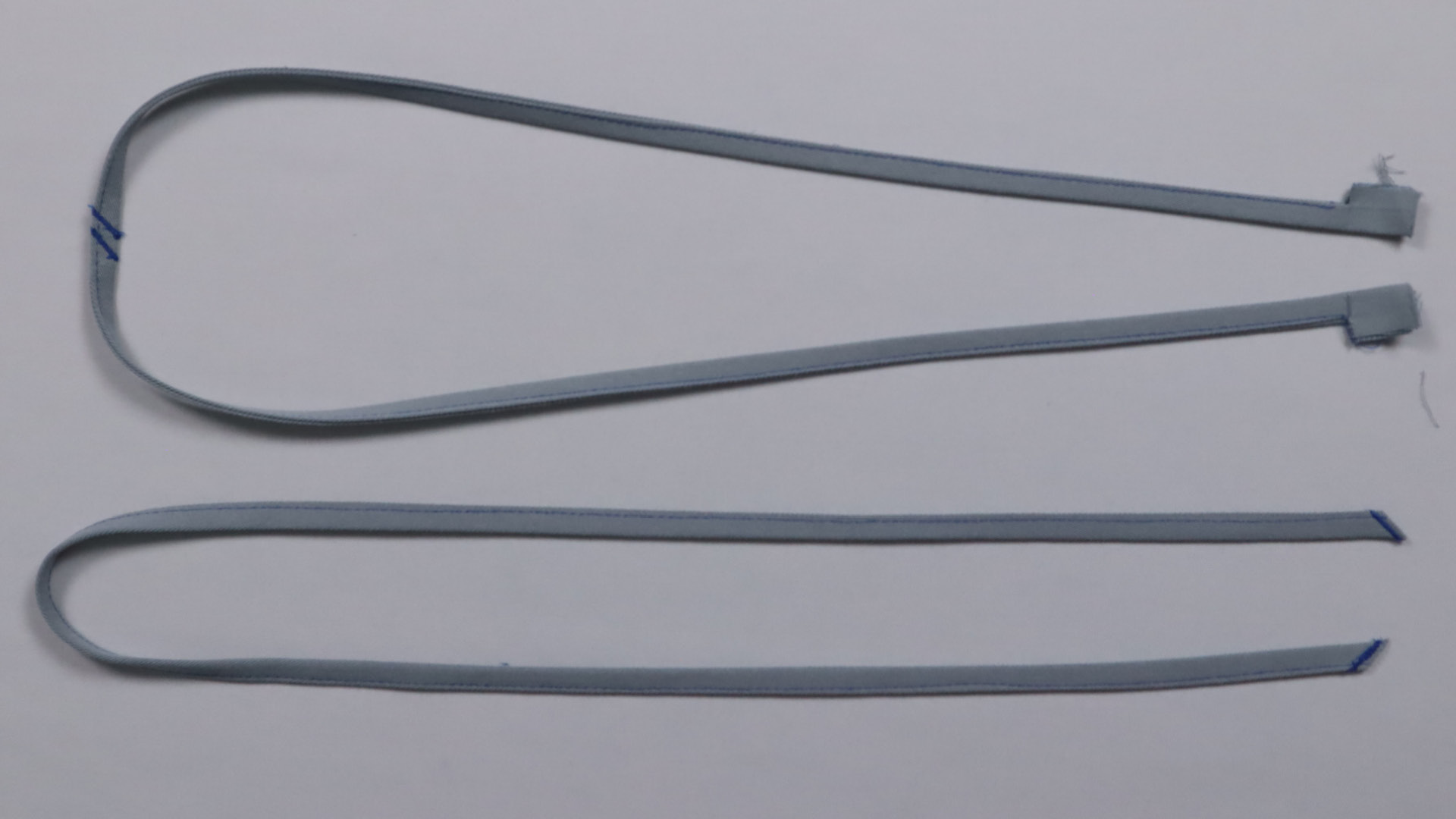
Now the ends of all the ribbons need to be secured to prevent fraying. I decided to use diagonal bartacks where I cut off the excess fabric close to the edge. On the ribbon where I have just snipped the ends, I sew two diagonal bartacks in the middle and divide the ribbon in between.
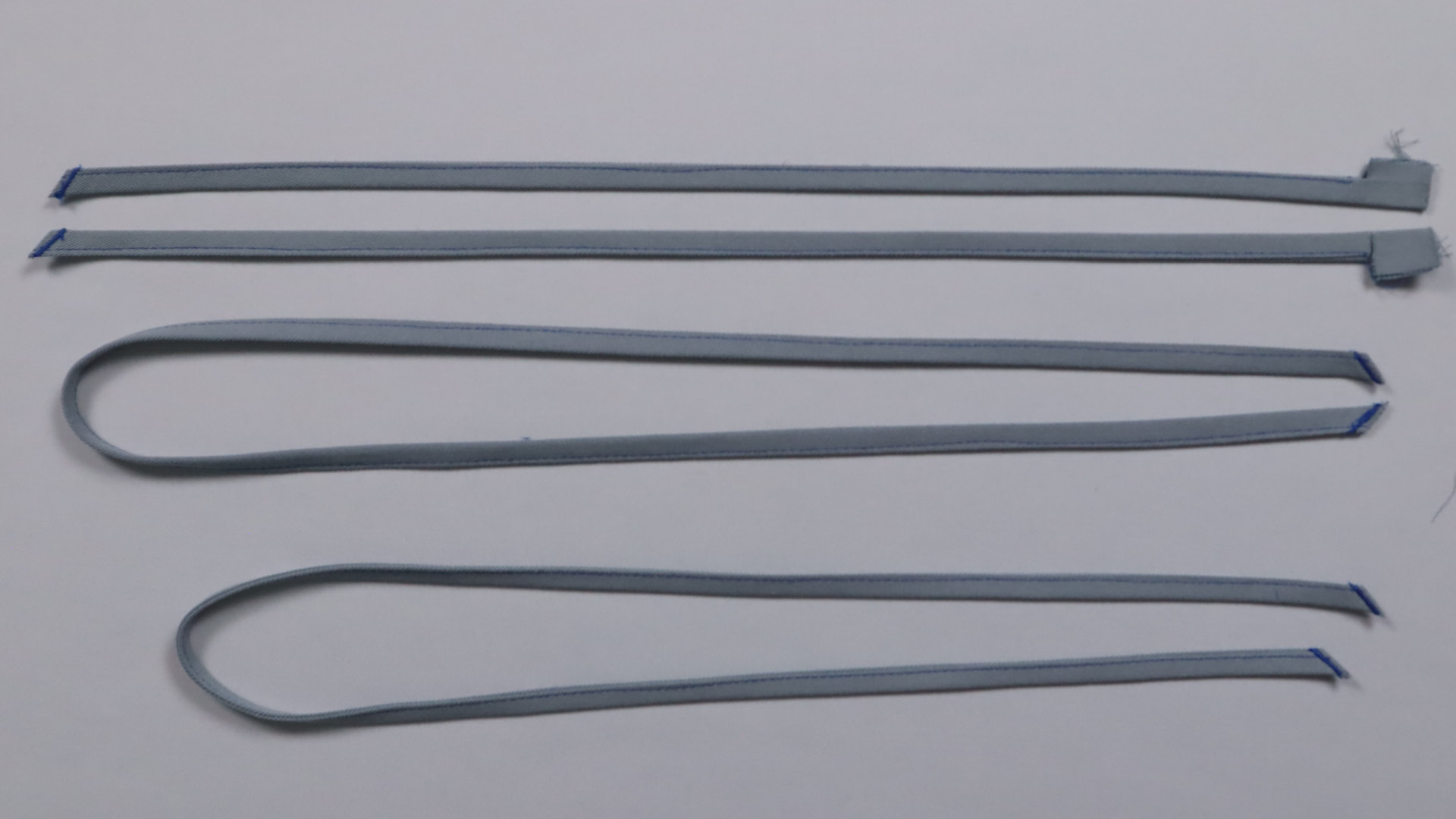
Here you can see the finished ribbons for the cape yoke and hood.
Fixing the back
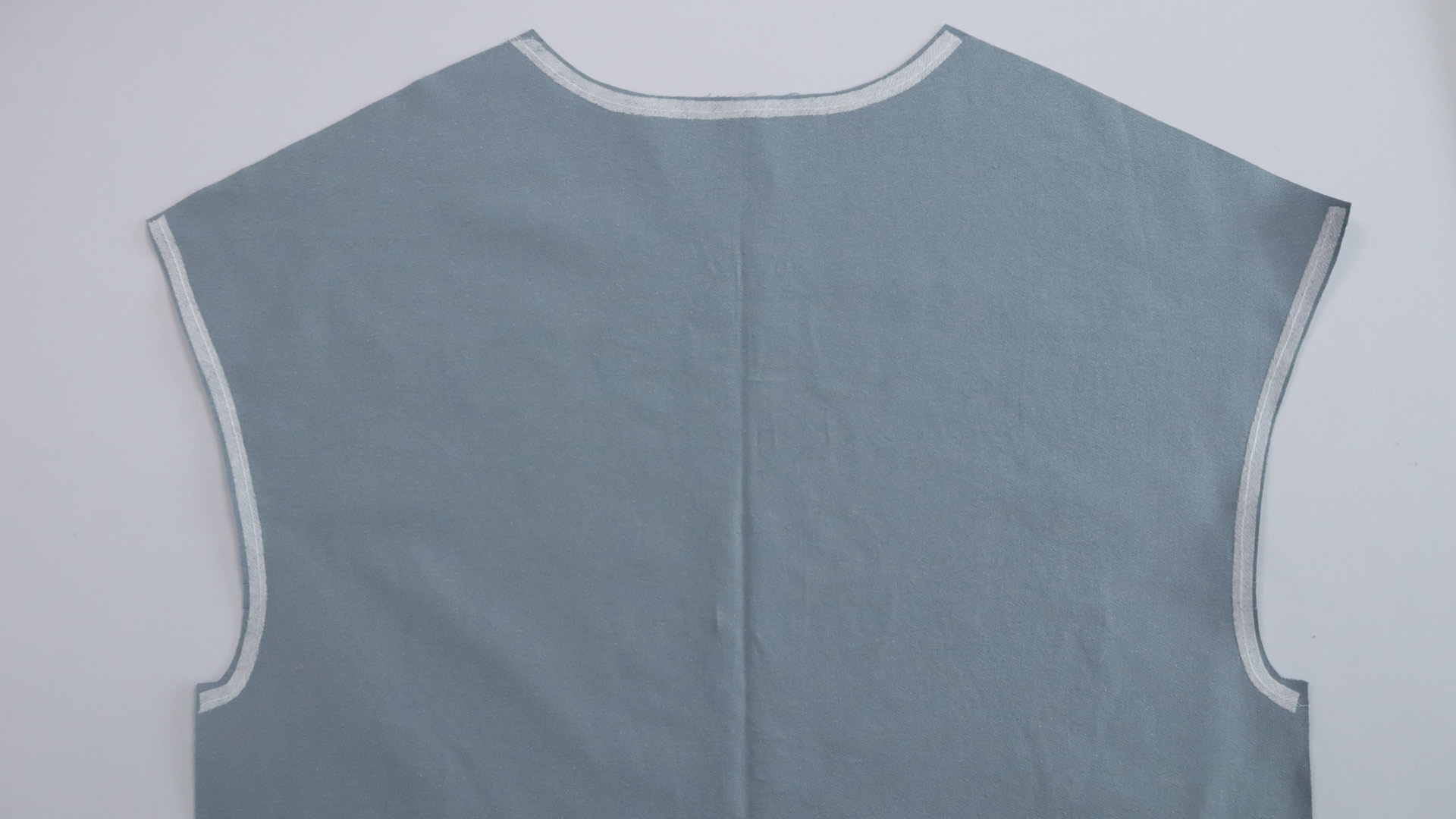
If not already done at the beginning, the armholes and neckline of the back must be fixed with bias tape. The back yoke does not need to be fixed, as it will be attached to the back later and thus prevented from stretching.
Close the side seams of the parka with hood
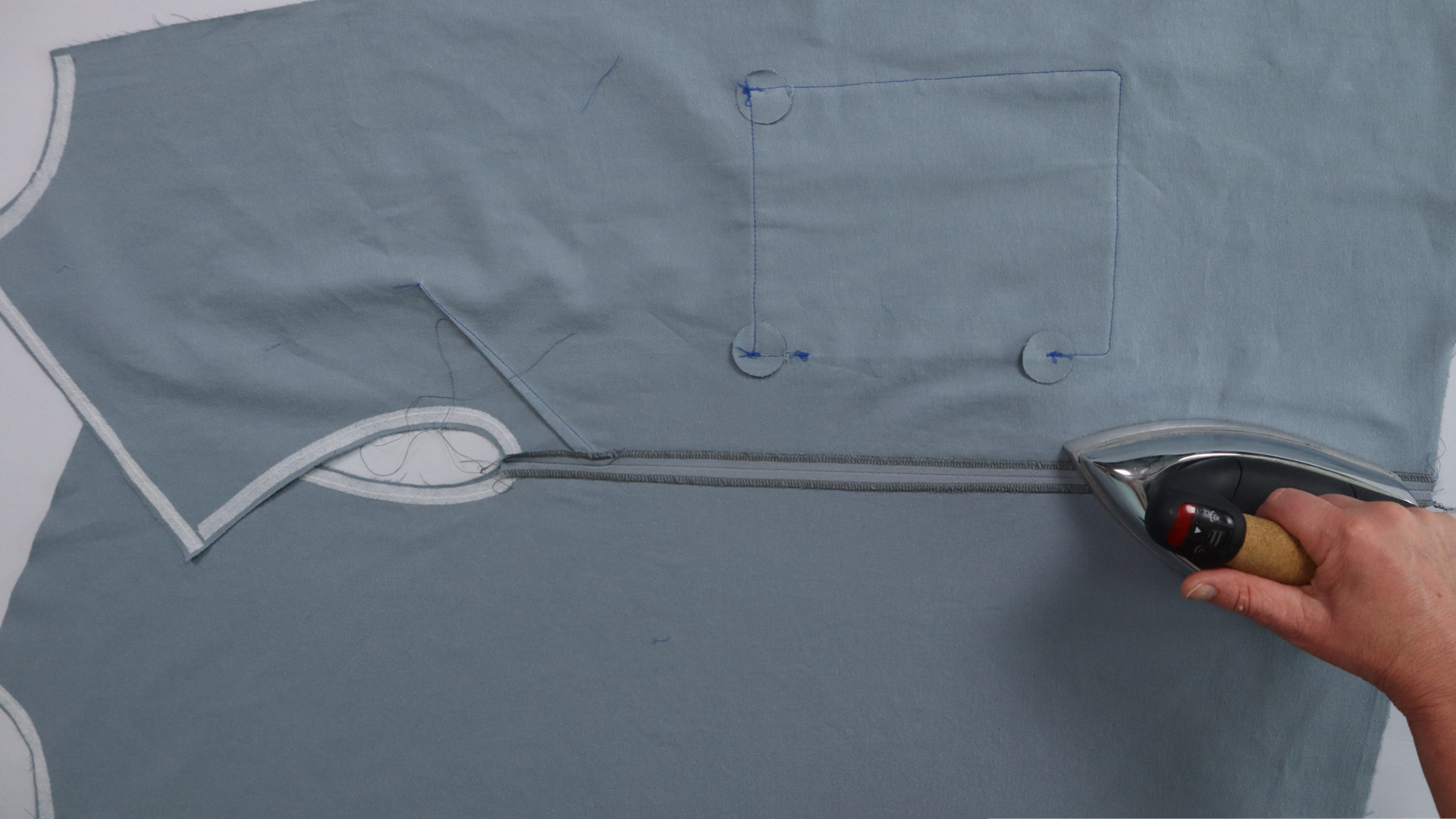
The front and back of the parka are now sewn together at the two side seams. I press the seam allowances apart.
Prepare the hem on the body
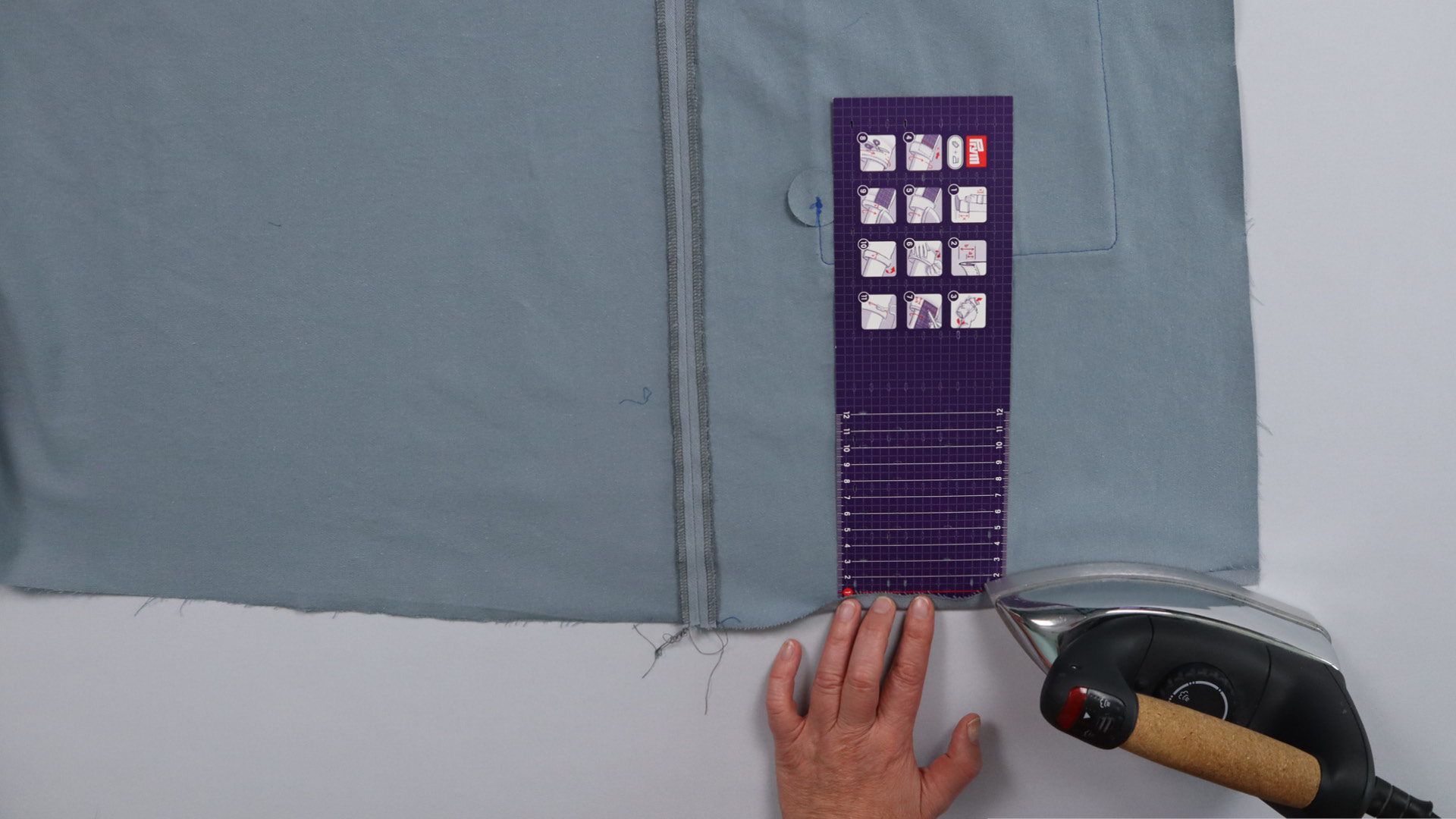
I first press the hem 1 cm inwards all the way around.
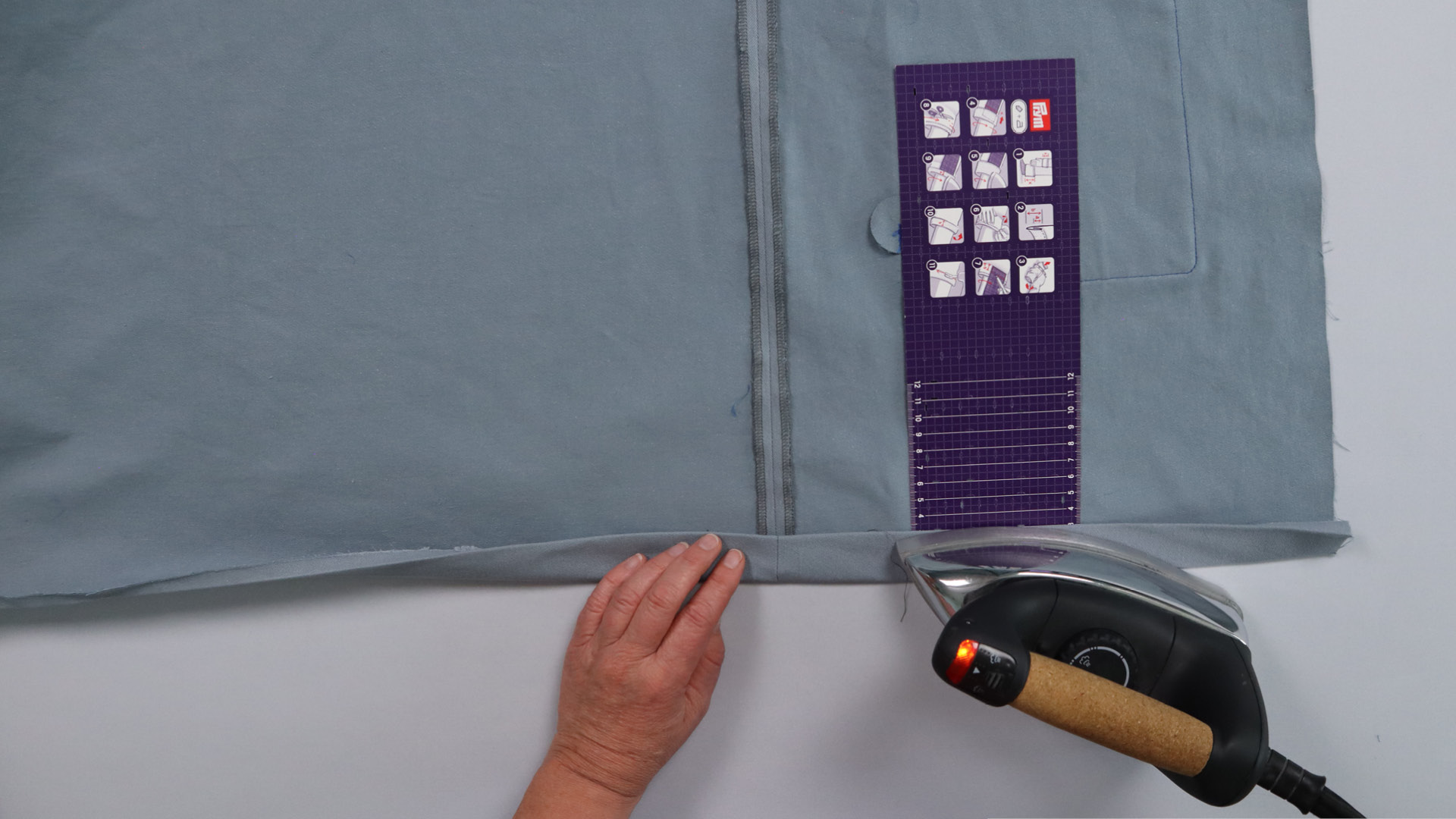
Then I iron it inwards again at the notches. Here it is 3 cm.
Attention: The hem is not yet sewn in place! However, ironing is easiest at this point, which is why the corresponding preparation is already done here.
Sew cape yoke hem with ribbons

On the front cape yoke pieces, the places where the buttonholes are to be sewn are first reinforced with interfacing on the wrong side of the fabric. Then I mark the position of the buttonholes on the right side of the fabric. The length of the buttonholes matches the sewn ribbons. If you use other tapes, you may have to adjust them.
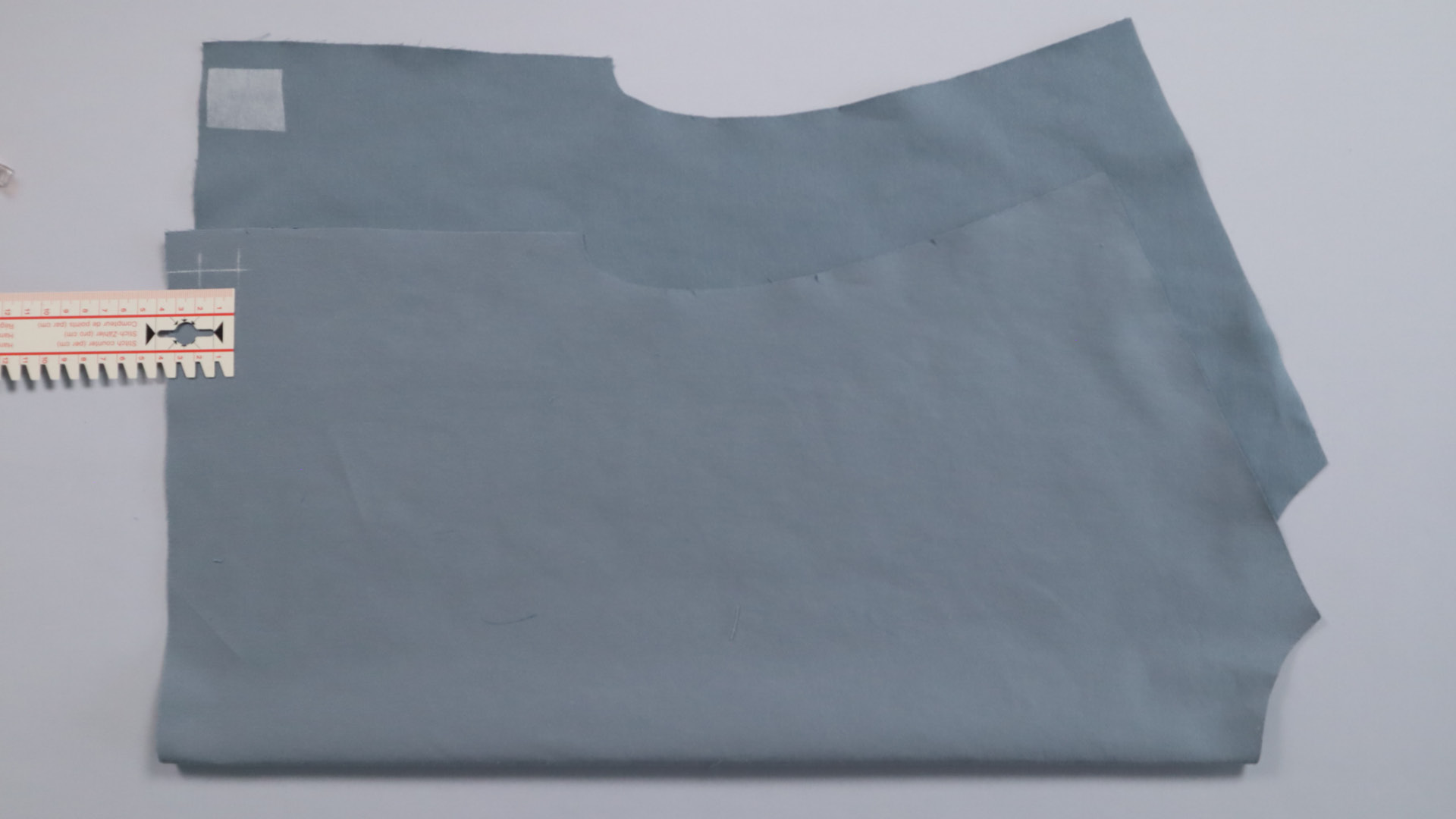
I repeat the steps on the back cape yoke. Then I sew the four buttonholes into the hems as previously marked and carefully open them.
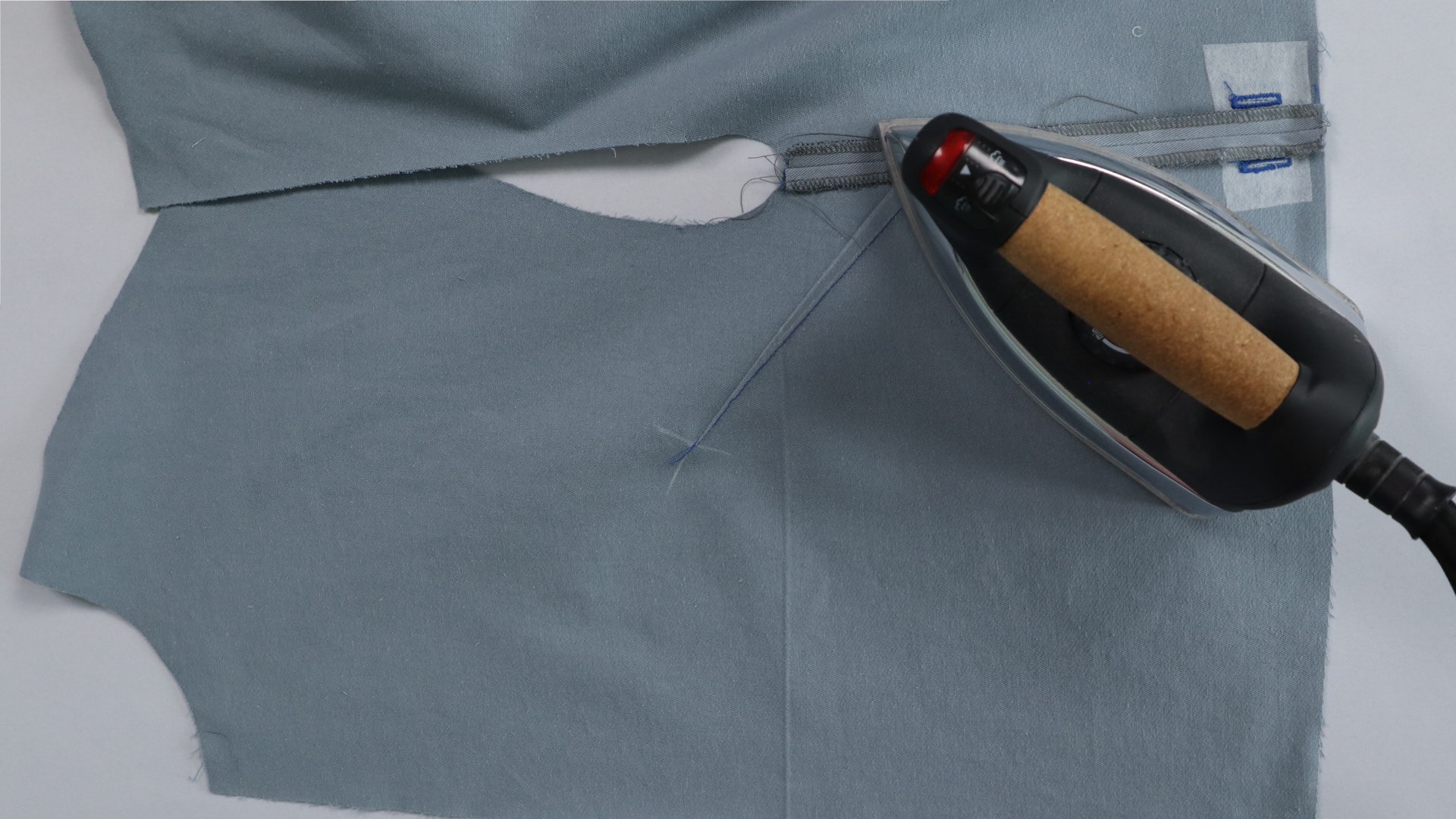
Now the side seams can also be closed at the cape yoke and the seam allowances can be pressed open.
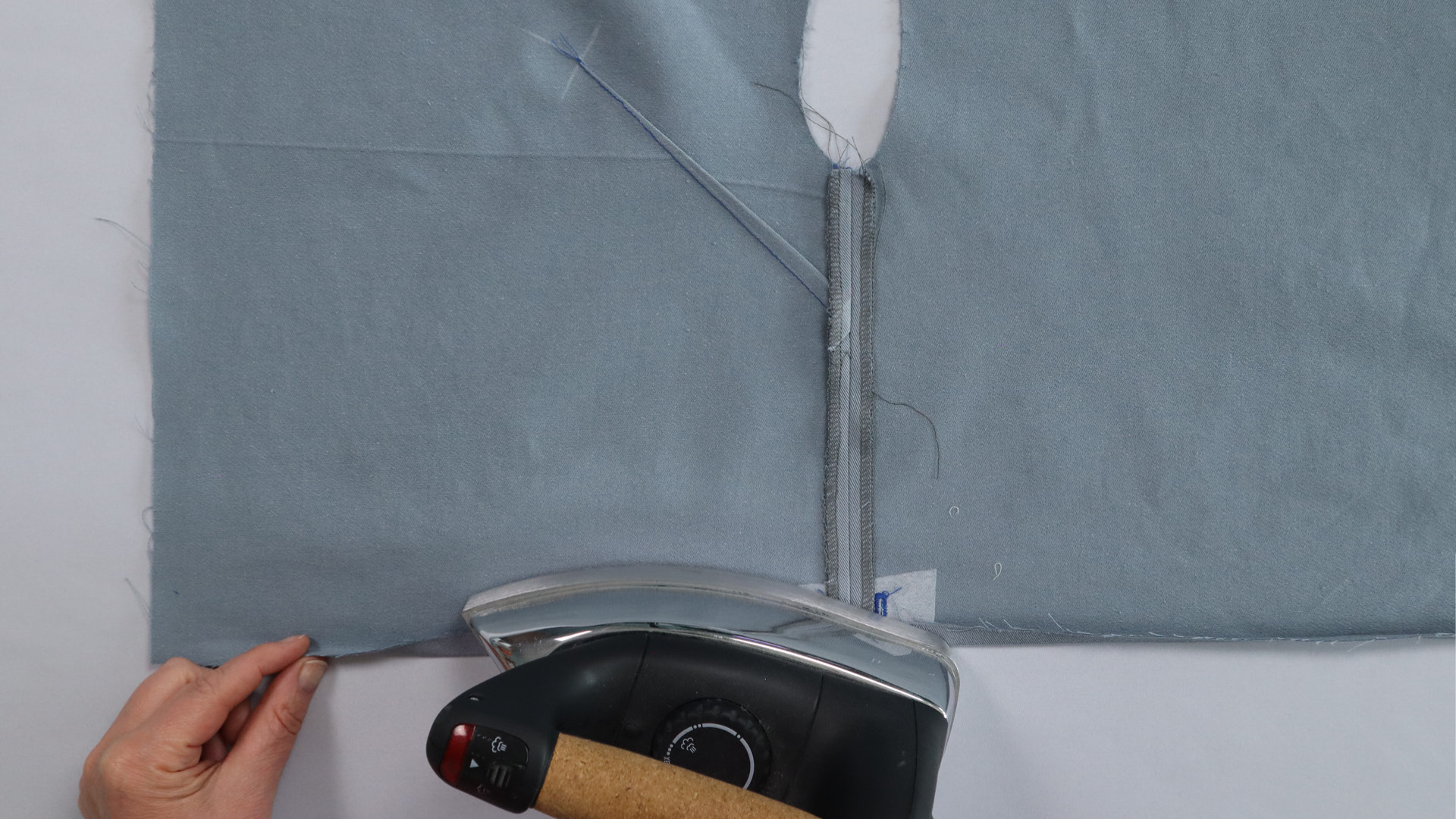
The hem of the cape yoke is first turned inwards 1 cm and ironed.

Then I turn the hem inwards by another 3 cm at the notches and press it in place. Here you can already see that the buttonholes are exactly on the inside of the hem.

At the center front, I cut the 1 cm wide seam allowance 4.5 cm from the front edge on both sides and press it open again.
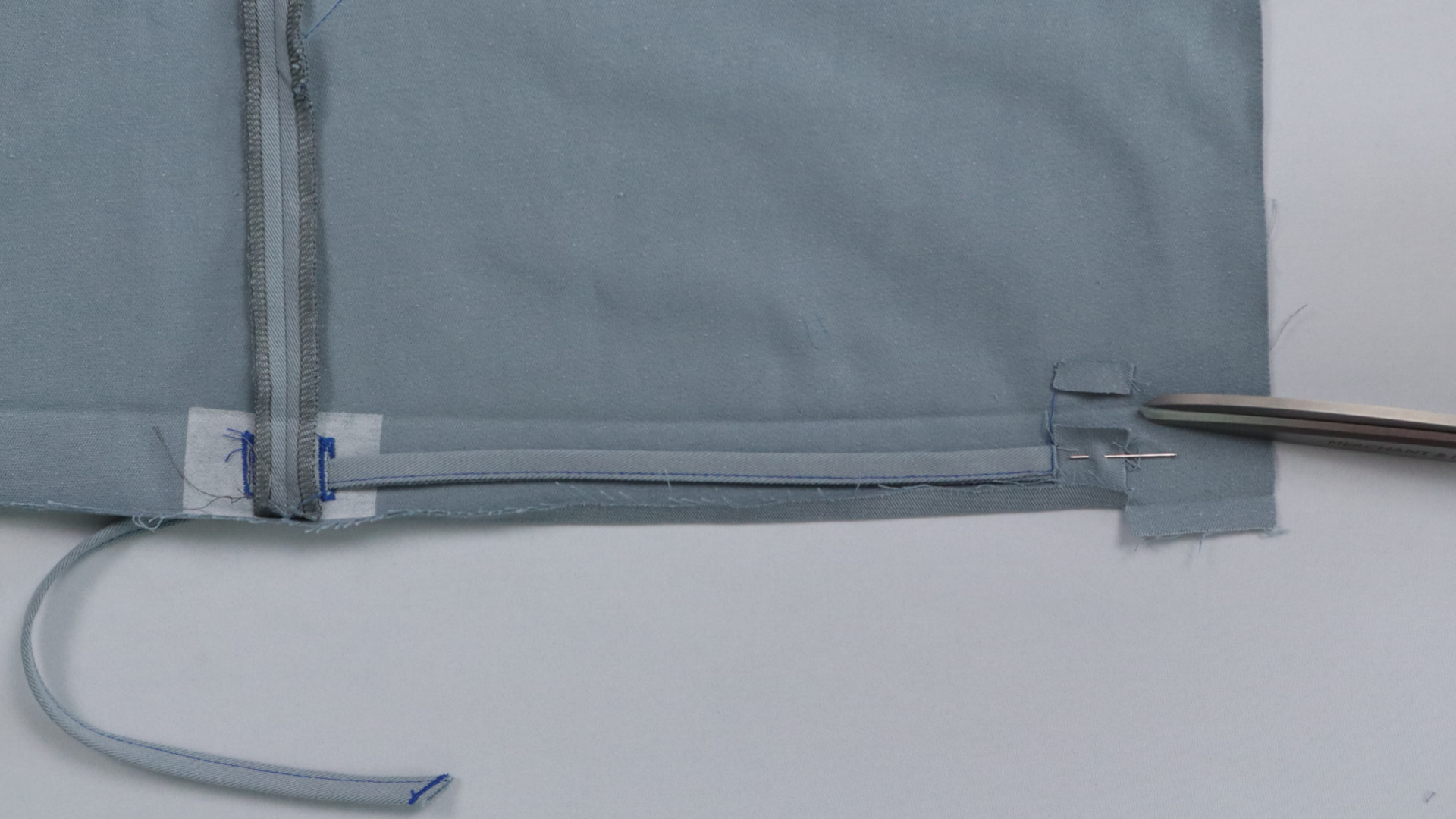
I place the ribbons for the front cape yoke at this point and pin them so that they are centered in the hem. I cut back the folded edge of the ribbon so that it is not wider than the hem.
I put the end of the ribbon through the buttonhole to the outside.

The open edges are then sewn to the hem with a narrow bar tack.
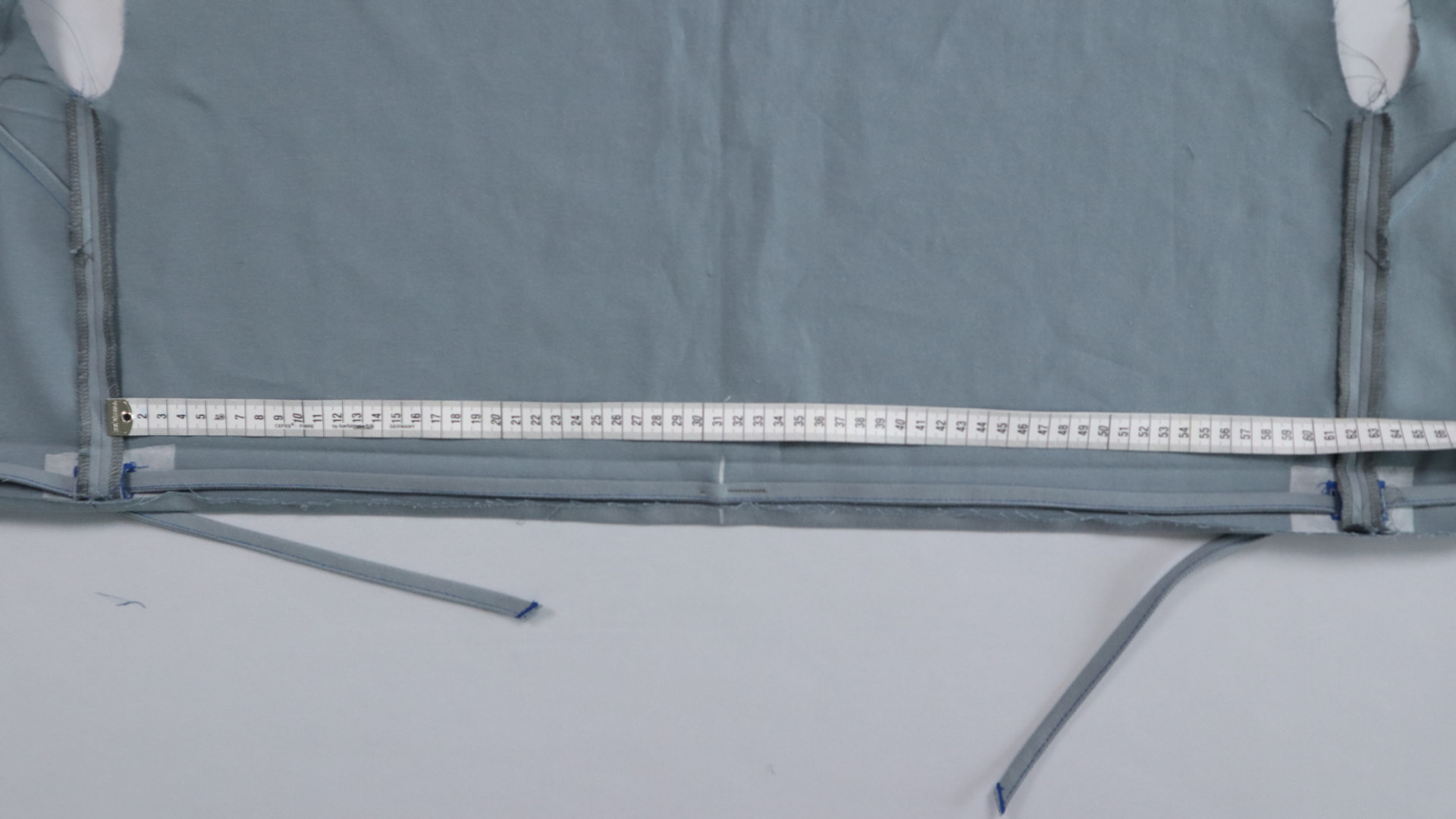
I place the back ribbon on the hem from the inside, pin it in the middle and put the ends through the buttonholes to the outside. I secure it at the center back with a bar tack to prevent it from slipping out or shifting.
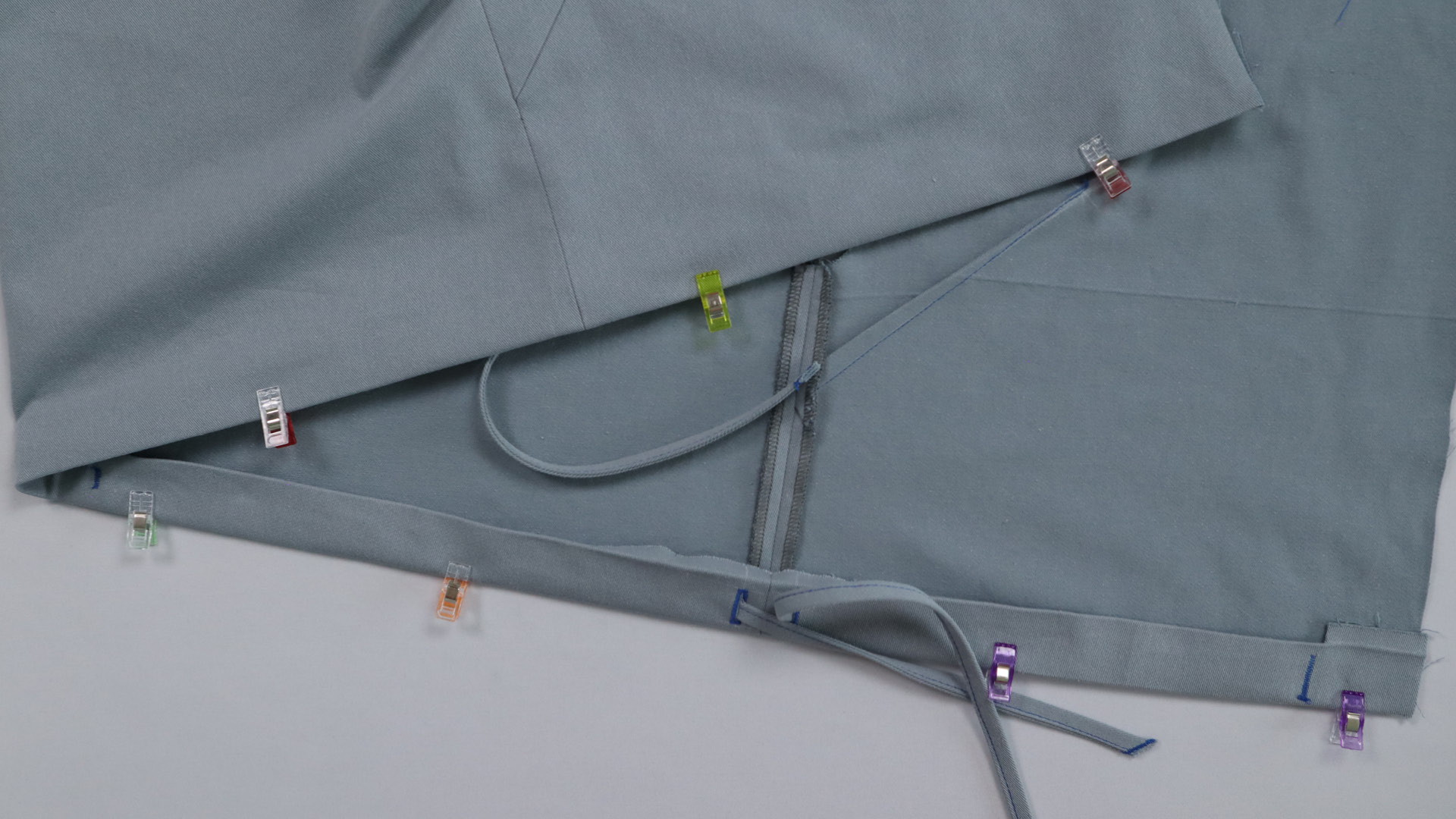
Then I fold the hem back inwards and pin it in place. At the front edges, I lay the cut seam allowances flat on top so that there are fewer layers of fabric on top of each other at this point.

I now topstitch the hem close to the edge from the right side. The distance to the edge is approx. 25 – 28 mm. It is best to measure again how wide your hem fold is so that you can catch all the layers when topstitching.
Close the shoulder seams

The shoulder seams can now be closed on both the body and the cape yoke.
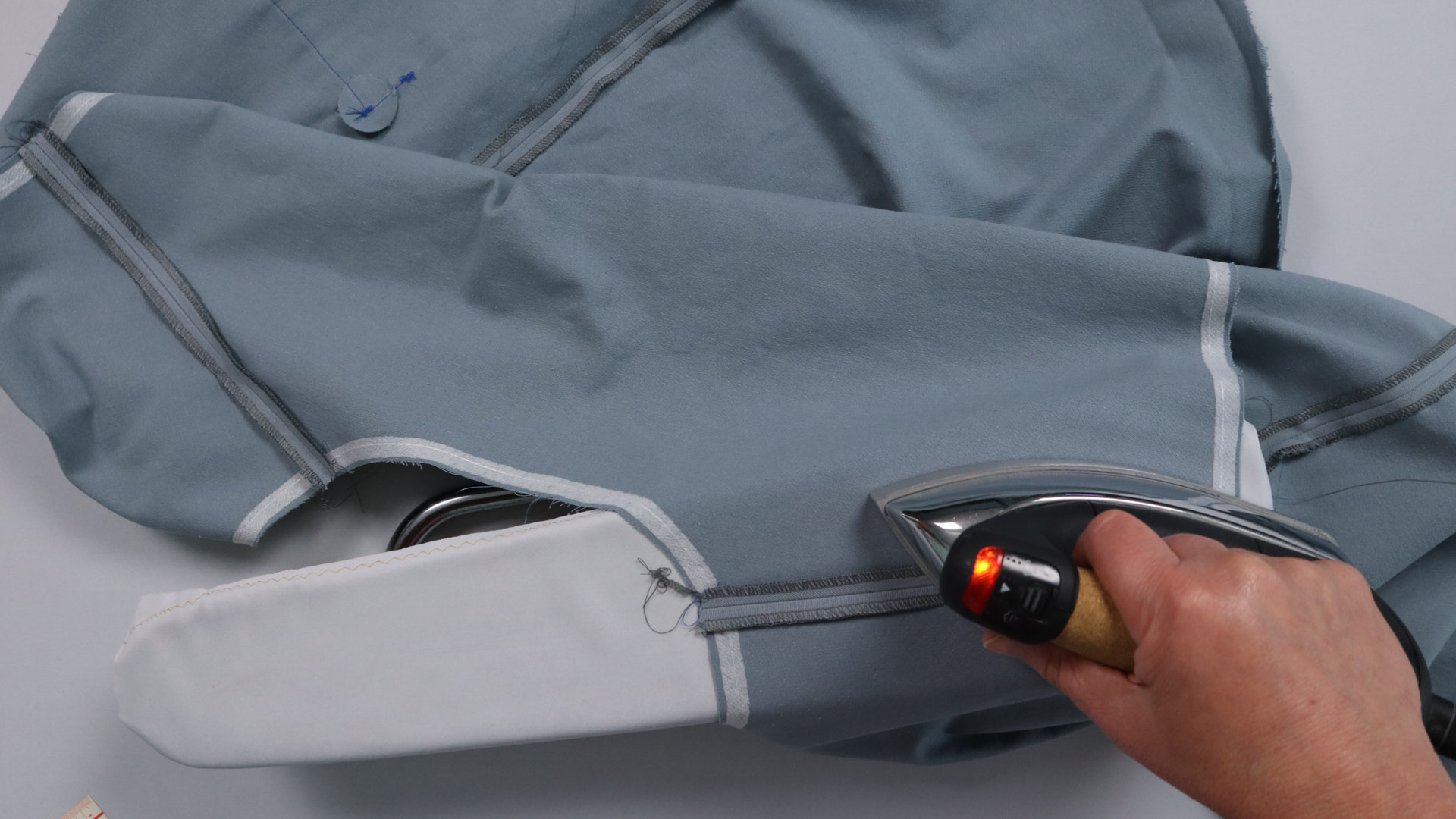
I press the seam allowances on the body open. You can also press them to the front and topstitch them close to the edge from the right. Then they lie in the opposite direction to the seam allowances on the cape yoke and you have fewer height differences.

I press the seam allowances to the back at the cape yoke and topstitch them close to the edge from the right side.
Connecting cape yoke and body
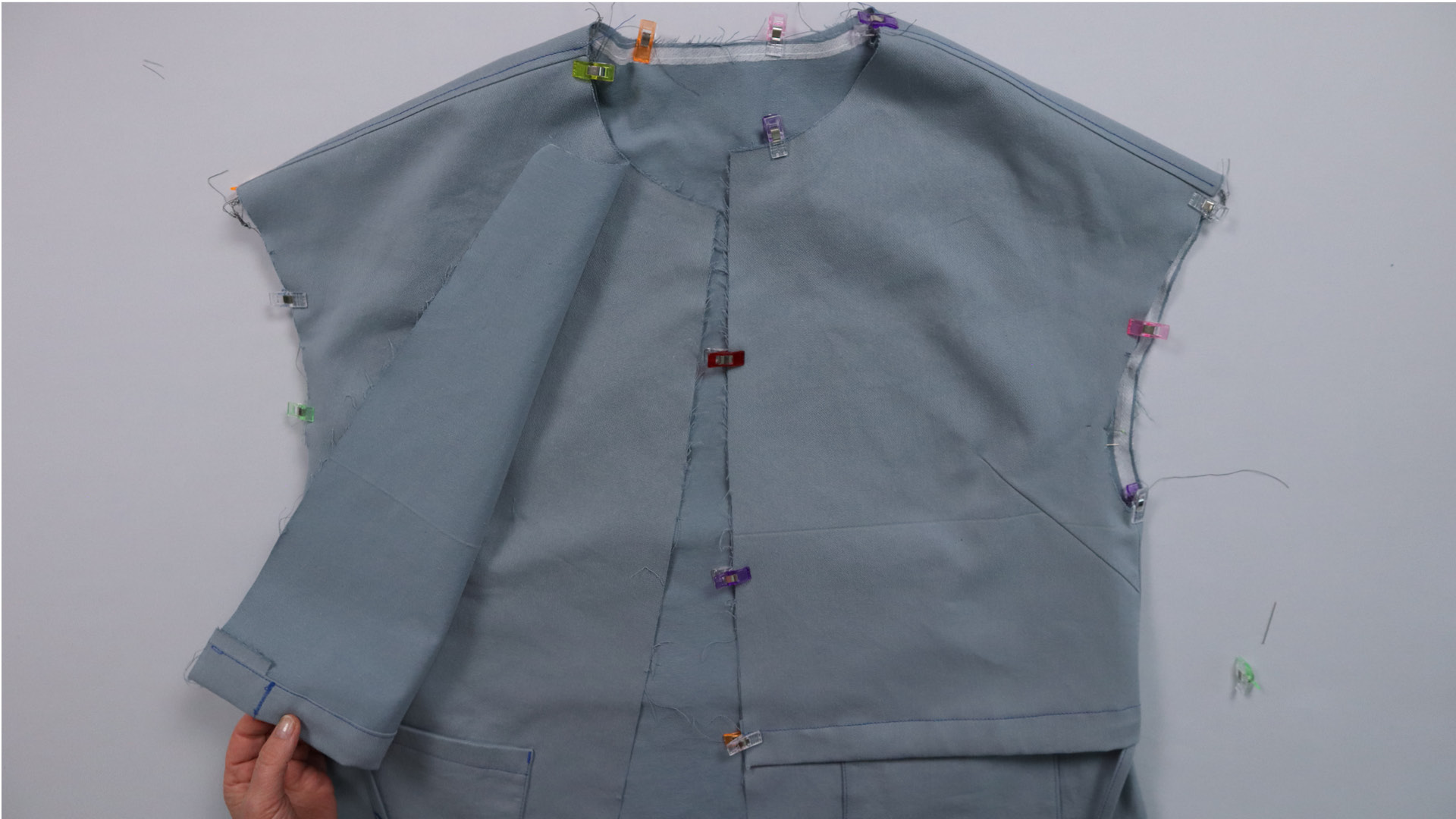
The cape yoke and body are now joined together within the seam allowances using auxiliary seams. To do this, pin them together at the center front, the neckline and the armholes. Make sure that the edges are flush.
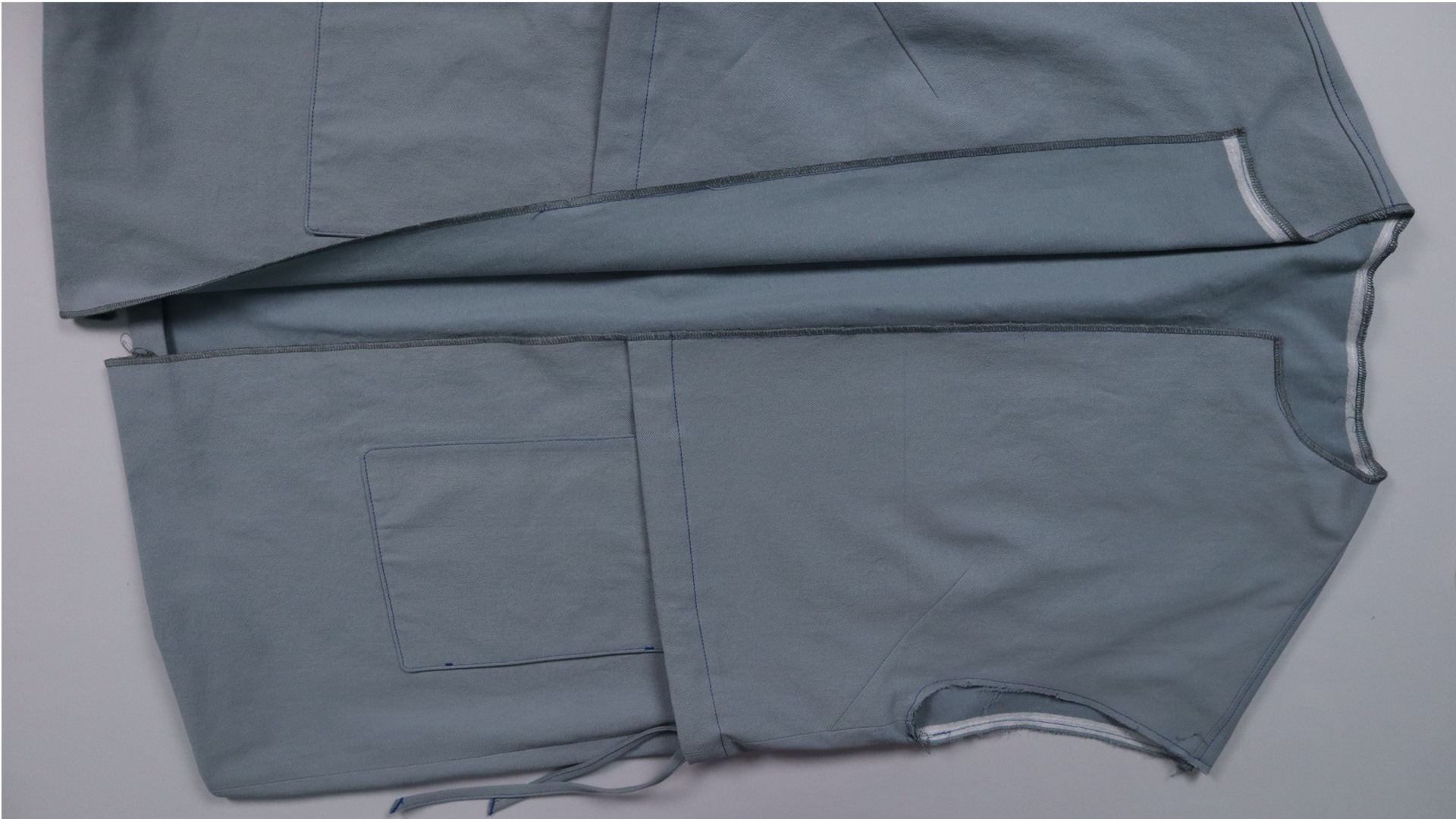
I join the front pieces, collar and armholes within the seam allowances.
Sew hood
Sew buttonholes or insert eyelets
First transfer the position of the buttonhole from the pattern to the right side of your fabric if you have not already done so. Reinforce the area on the wrong side of the fabric with a piece of interfacing measuring approx. 2 x 3 cm and, if necessary, place another piece of fabric under the hood piece on the wrong side before sewing the buttonhole.
 The buttonhole positions are marked.
The buttonhole positions are marked.
I recommend a buttonhole that has straight bars at the beginning and end.
Alternatively, you can of course make eyelets or sew the buttonhole using a different technique. In any case, make sure that it matches the size of your ribbon or cord. The marking in the pattern matches the pattern piece for the ribbon exactly.
Connecting hood parts
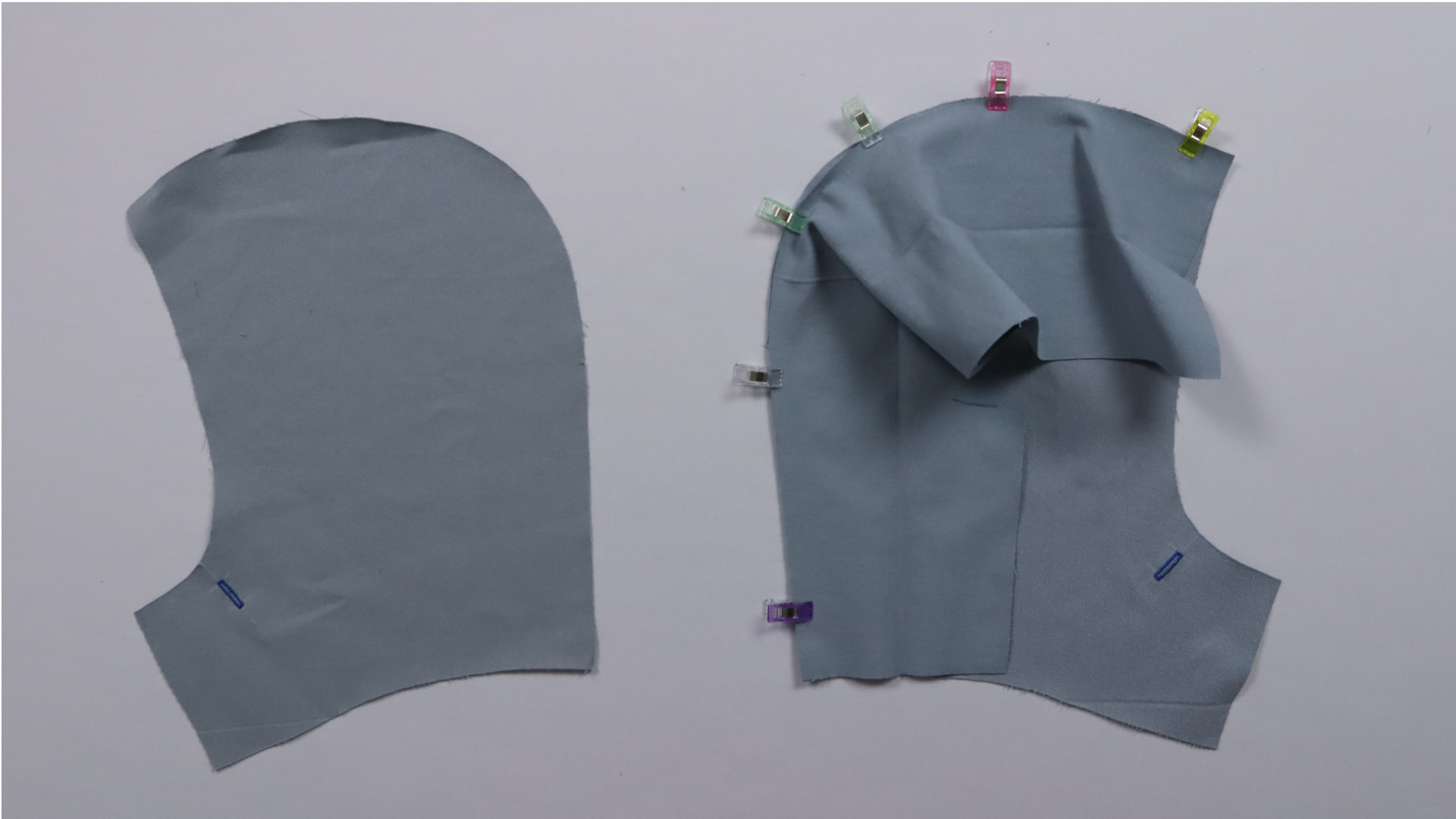
Now join the side hood pieces to the center piece. Pay attention to the snaps again when you pin the center strip to the side pieces, right sides facing.
This step is a little tricky due to the curve of the hood. So take enough time for pinning and sewing and keep laying the fabric of the center strip flat so that you don’t sew in any creases.
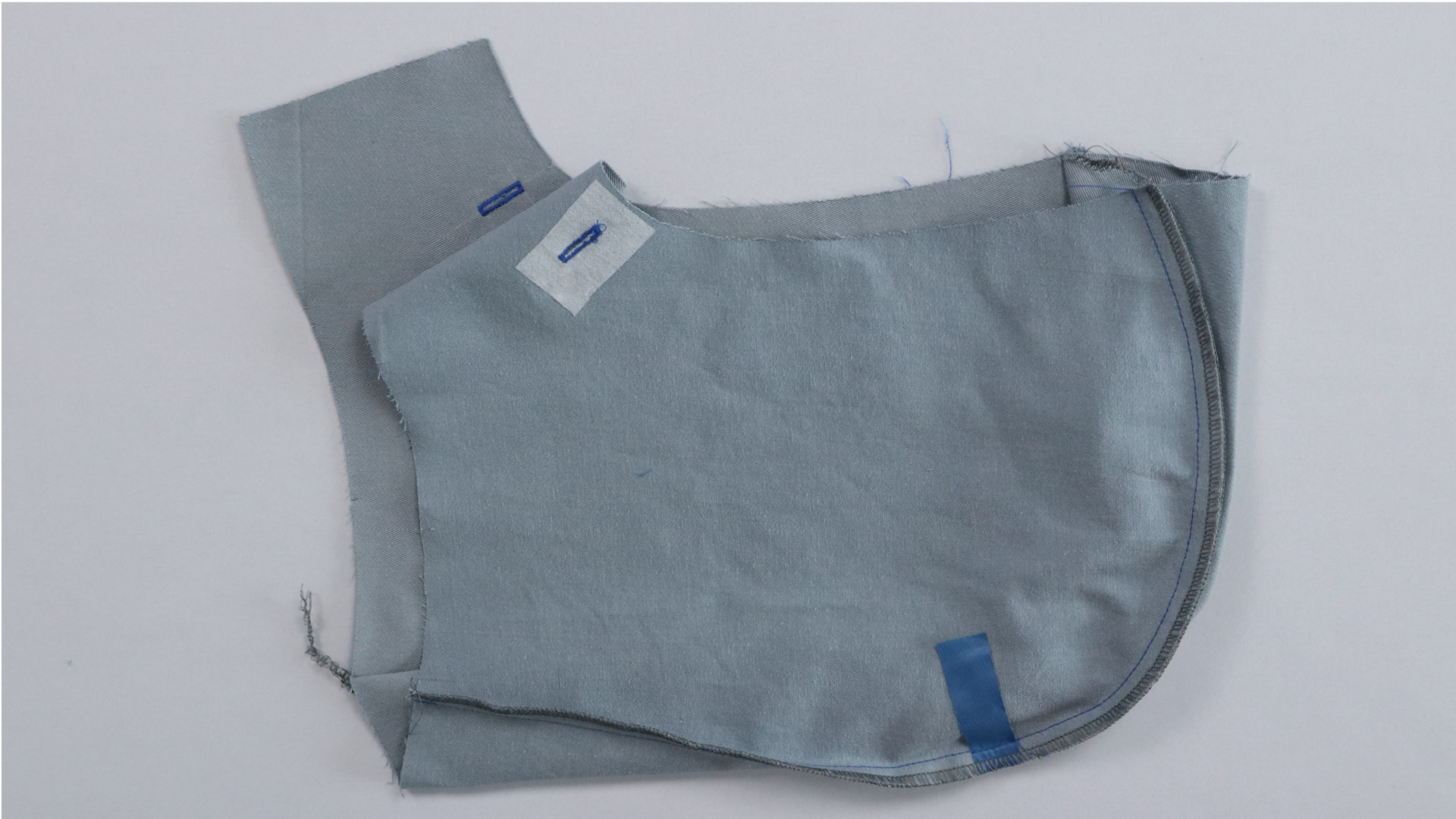
Here I sew a connecting strip into the curve on both sides, to which the hood lining will later be attached.
I press the seam allowances to the center strip and topstitch them close to the edge from the right.
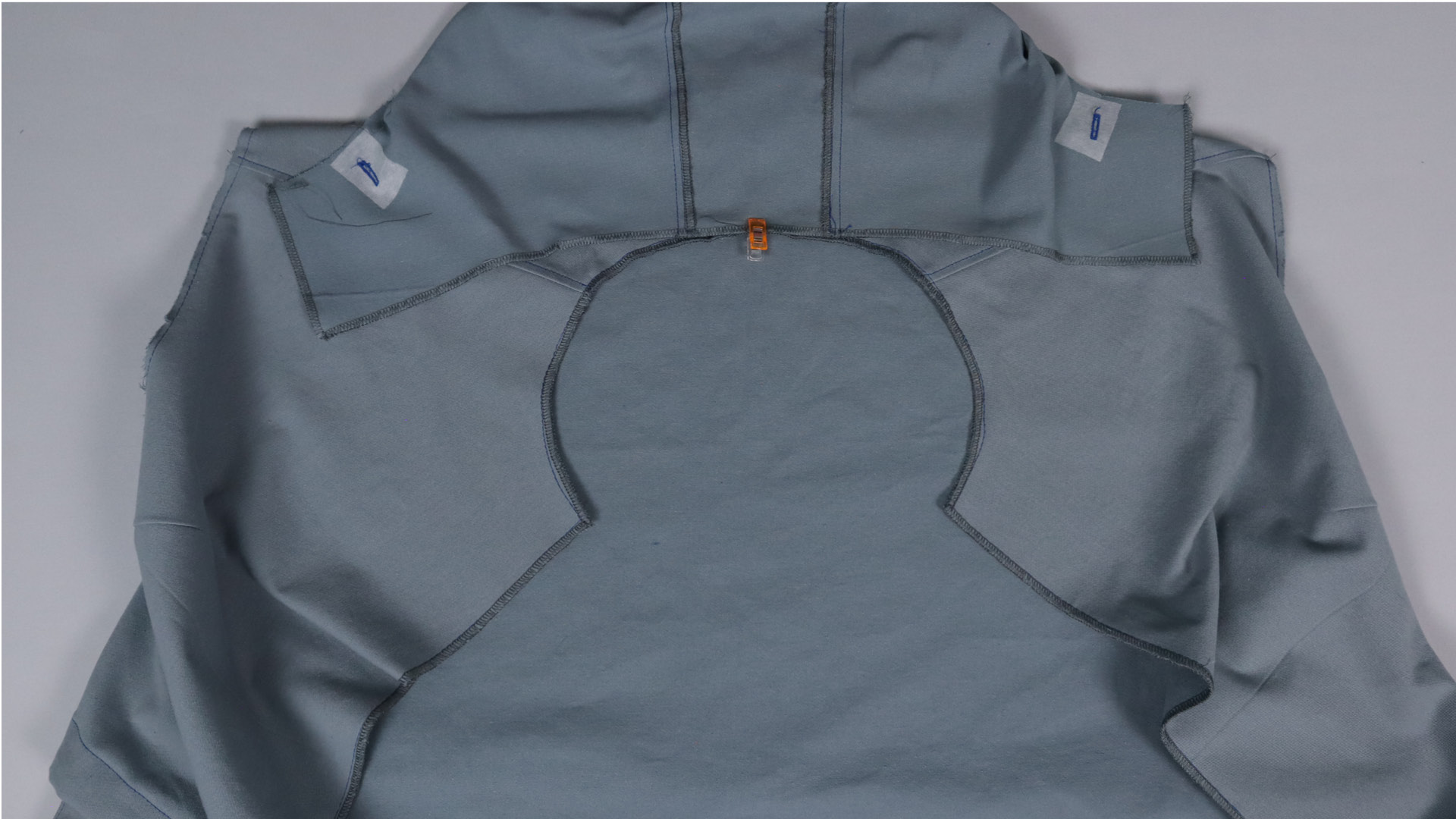
I pin the hood into the neck hole at the center back.
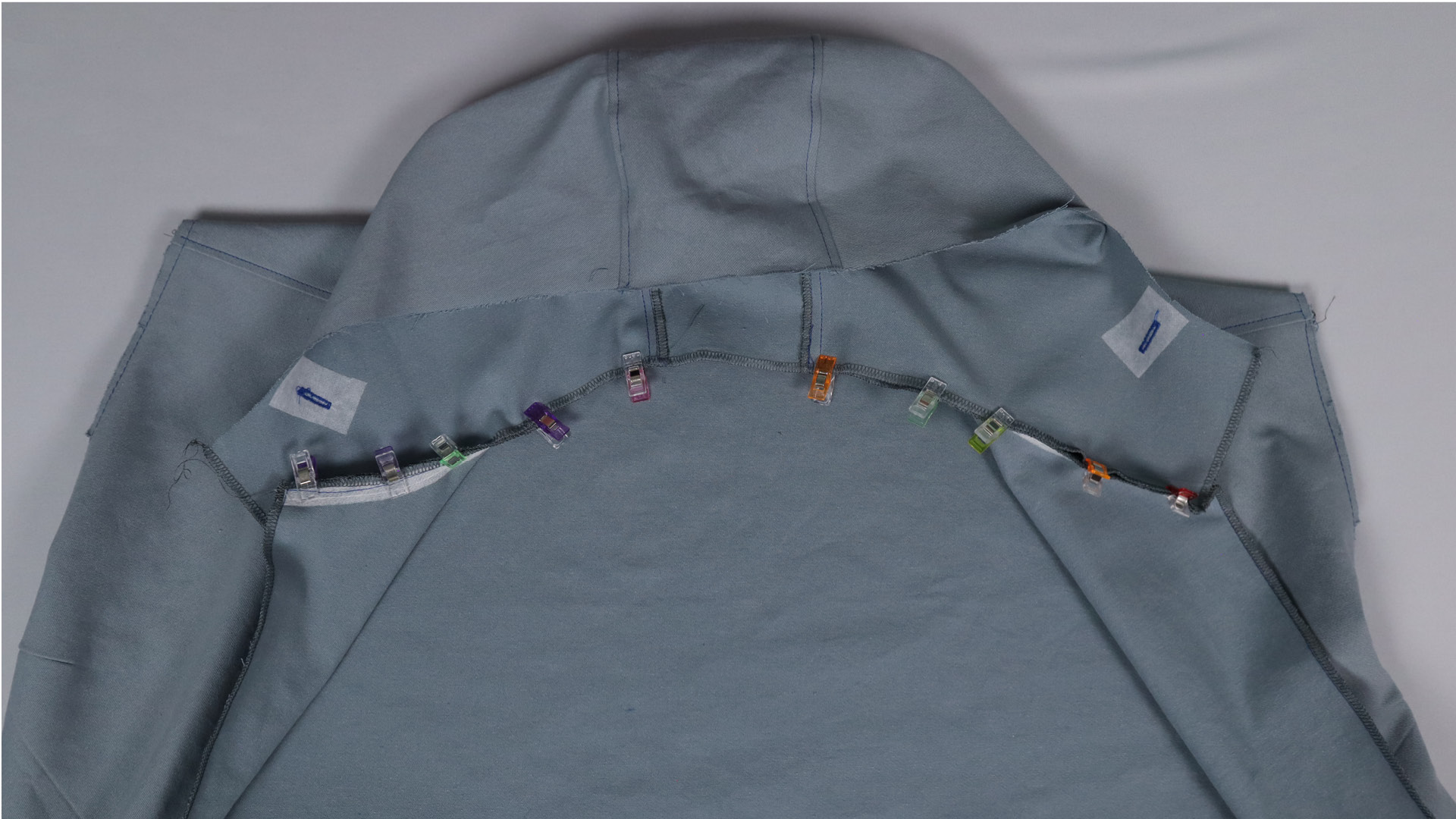
Pin the hood to the body, right sides facing, according to the notches, and sew together.
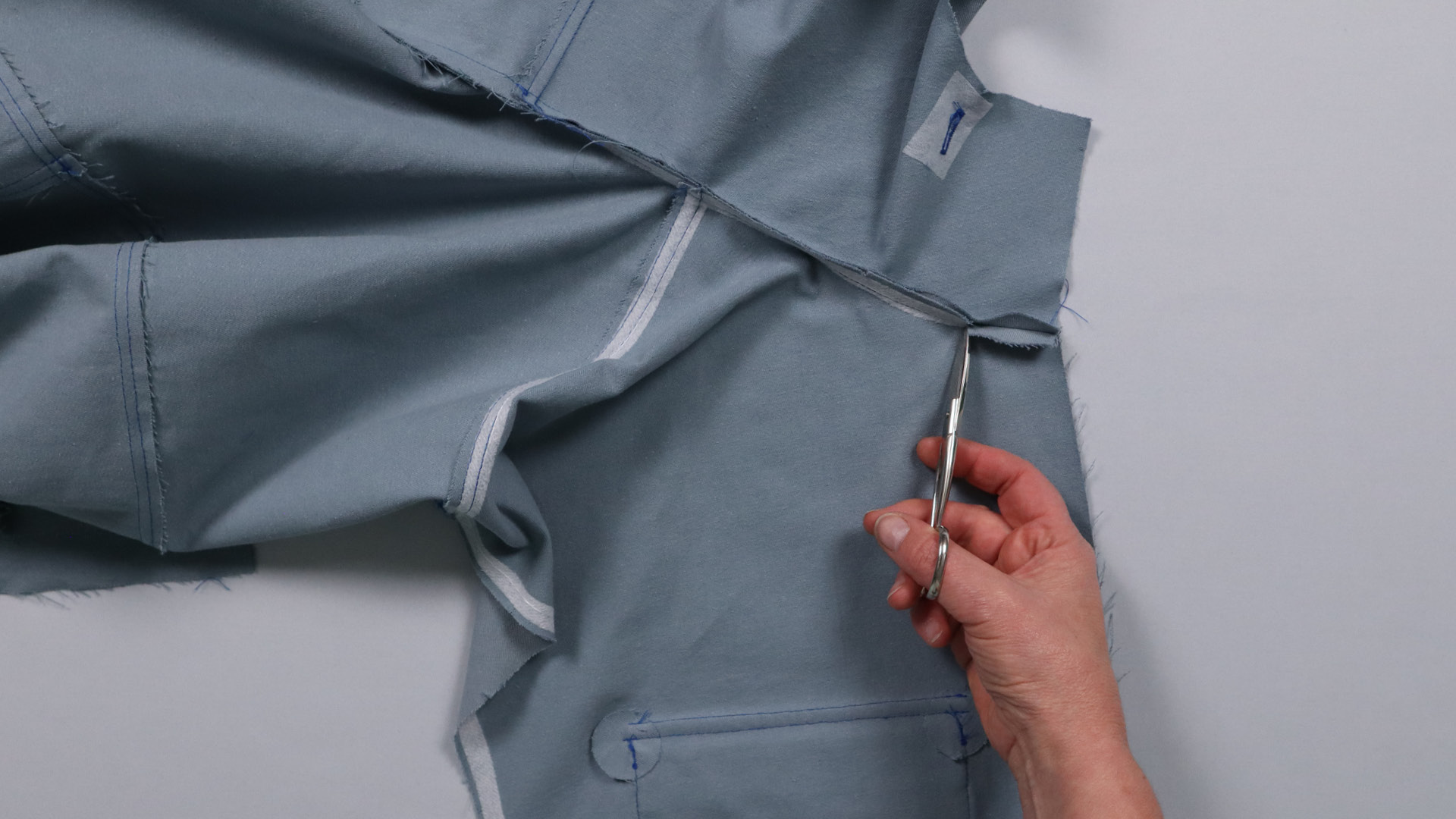
Then cut the seam allowance of the body approx. 4.5 cm from the front edge on both sides and press the seam allowances open. The picture above is of the jacket with hood, which is why you can see the pocket and no overlock seam. Don’t let this confuse you.
Press the seam allowances in the remaining curve towards the hood.
Sew zipper to the parka with hood
There are markings in the pattern 13 mm from the top edge and at the bottom of the zipper. The zipper is placed between these markings; the zipper tape then protrudes slightly at the upper end. If you have transferred the notches exactly, the distance between the notches will be 5 mm longer than the specified zipper length. This extra length is maintained when sewing in the zipper to prevent it from curling.
If you have a longer or shorter zipper than specified, the lower clip must be moved accordingly.
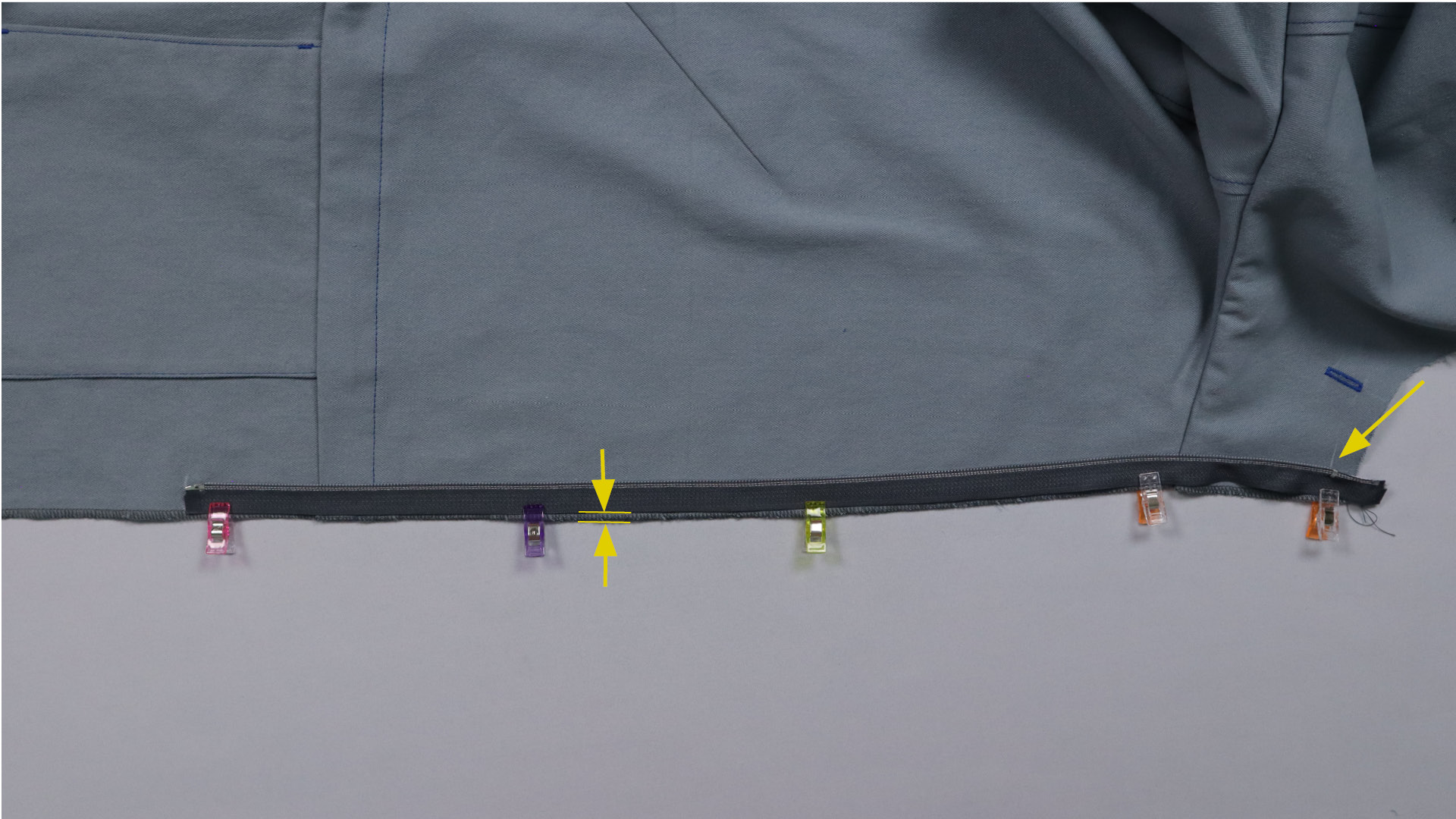
First, I pin the right side of the zipper to the right front piece, right sides together.
A seam allowance of 1 cm is provided on the front edge of the parka.
After sewing in, 7 mm of the zipper tape including the teeth or spiral should be visible on both sides, i.e. 14 mm in total. If your closed zipper including the tape is 3 cm wide, there will be 16 mm left minus the 14 mm, i.e. 8 mm on each side. To ensure that the seam allowance of 1 cm is maintained, the zipper must be positioned 2 mm away from the front edge.
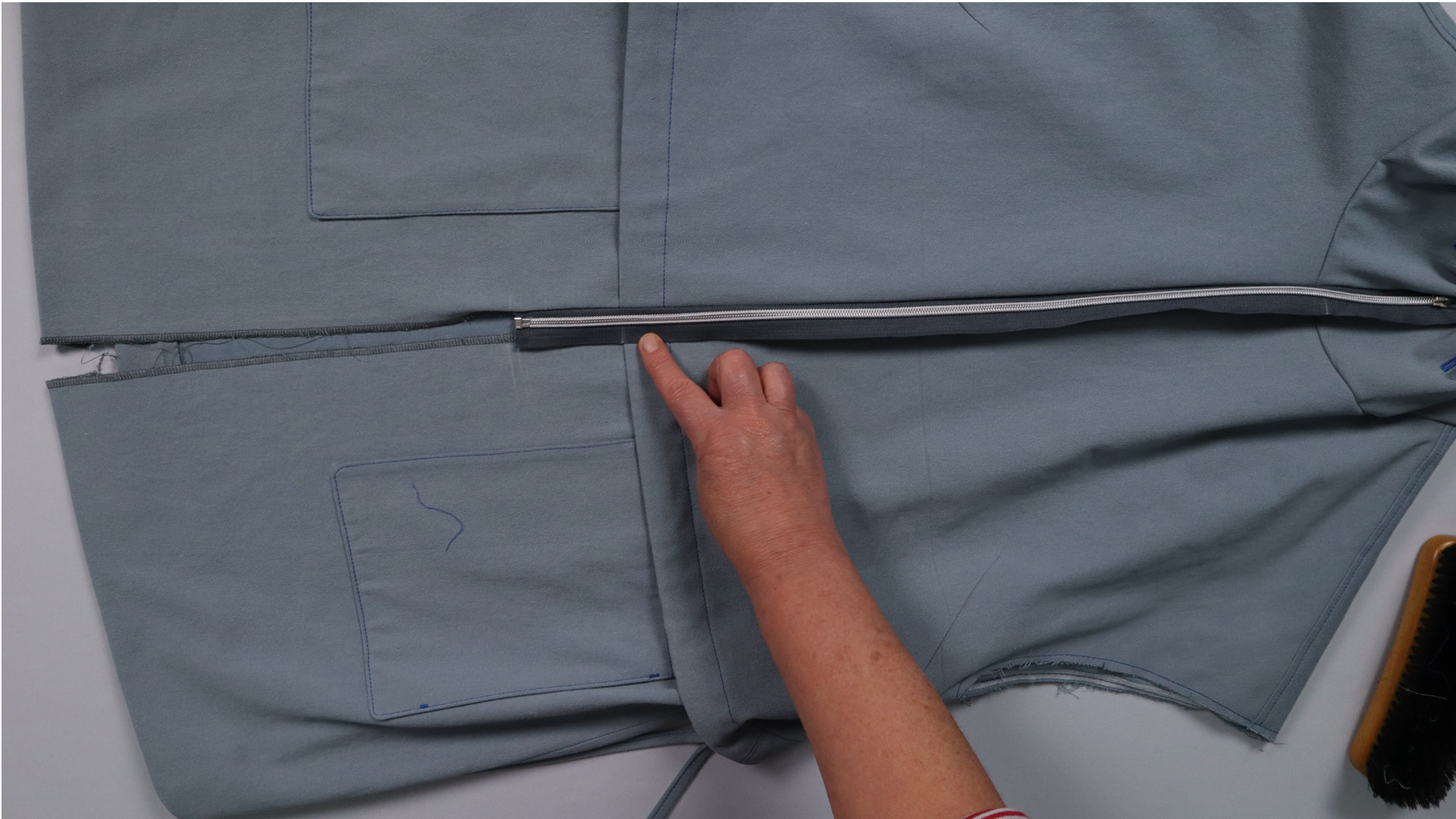 Mark the bottom edge of the turtleneck and the hood seam.
Mark the bottom edge of the turtleneck and the hood seam.
Then close the zipper again and mark the bottom edge of the cape yoke and the attachment seam of the hood on the tape that has not yet been sewn on so that both sides are sewn in the same way.
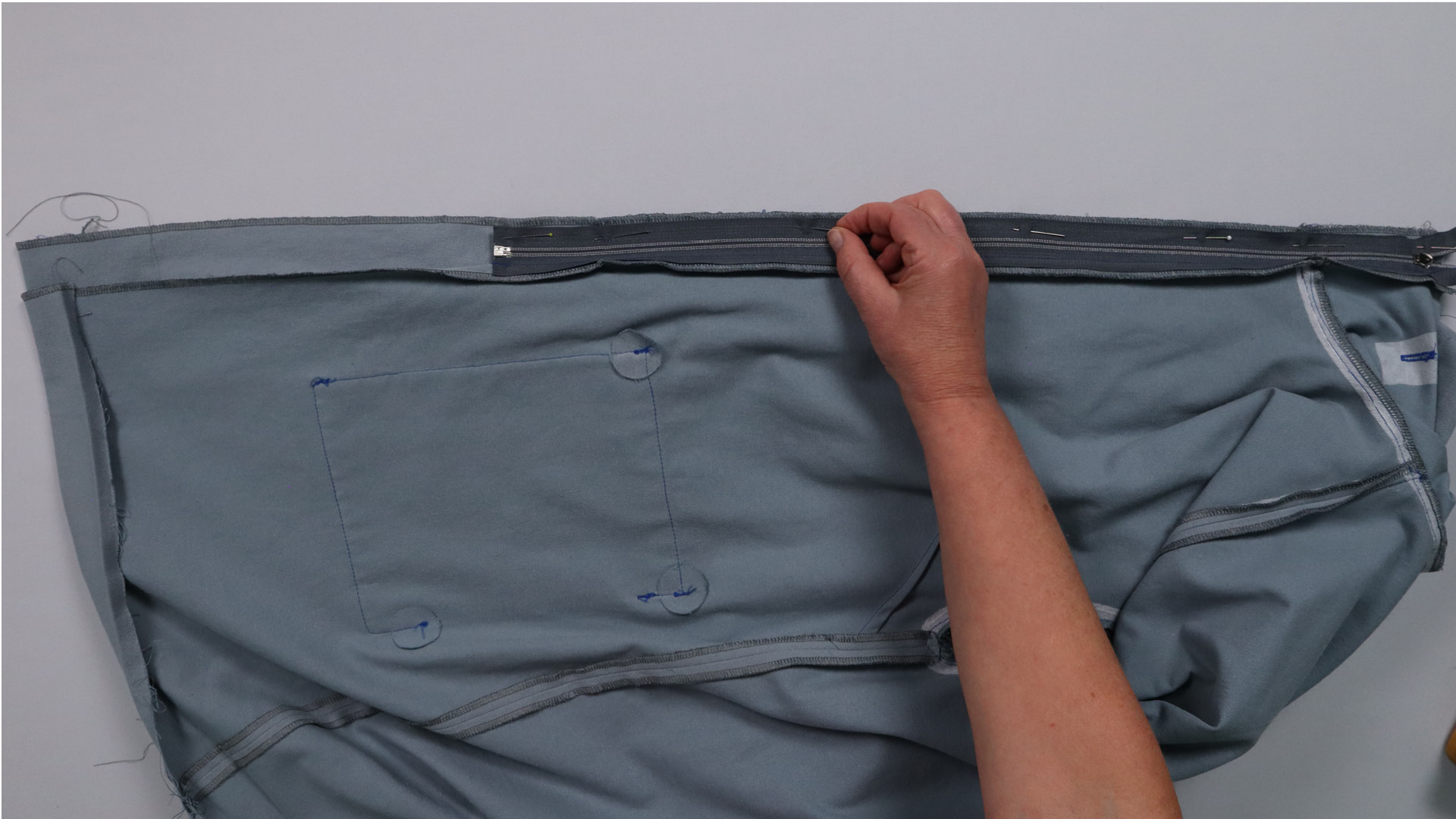
Now sew the second side of the zipper to the other front piece, paying attention to the markings.
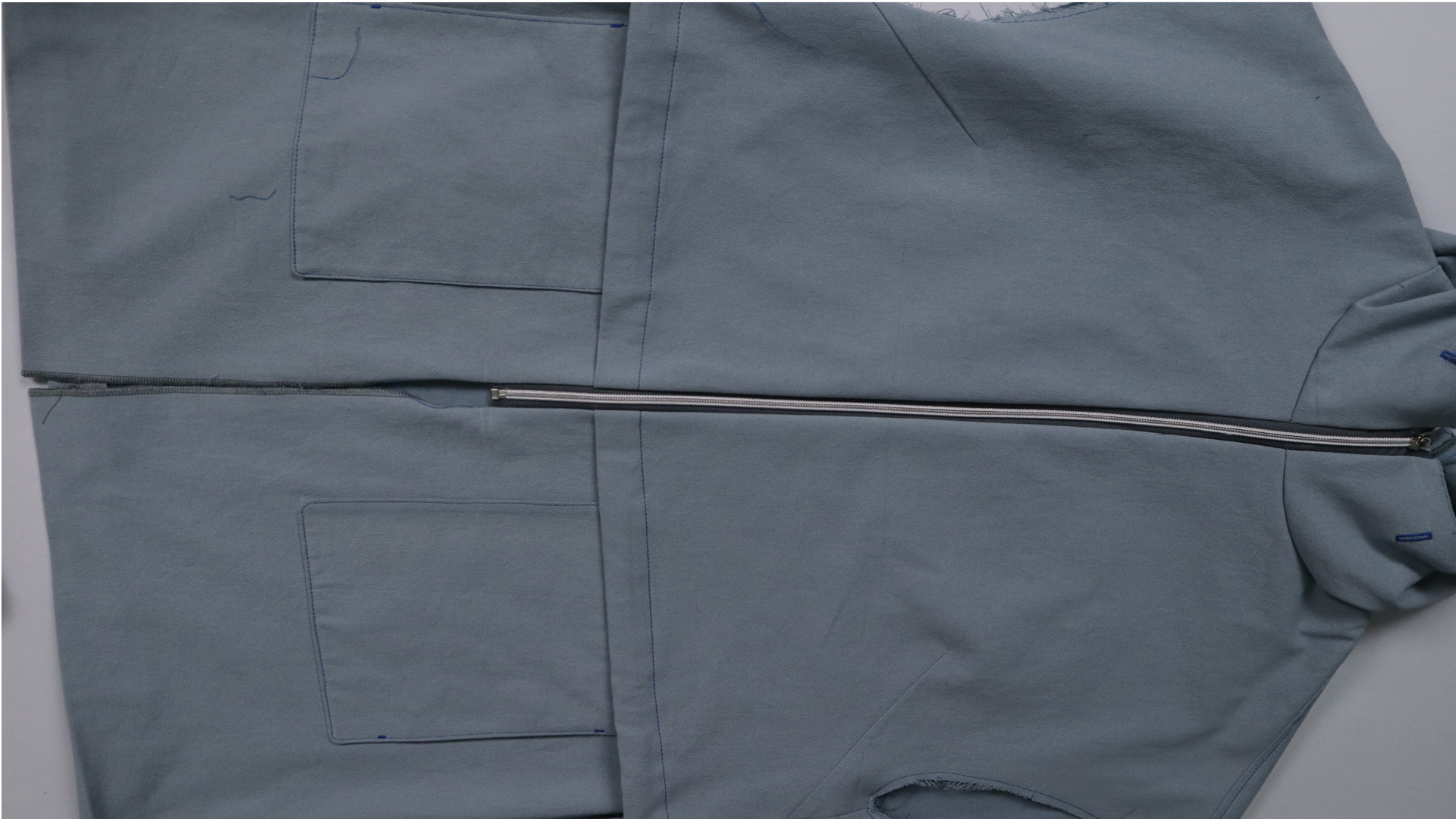 The zipper is sewn on.
The zipper is sewn on.
This is what the sewn-in zipper looks like.
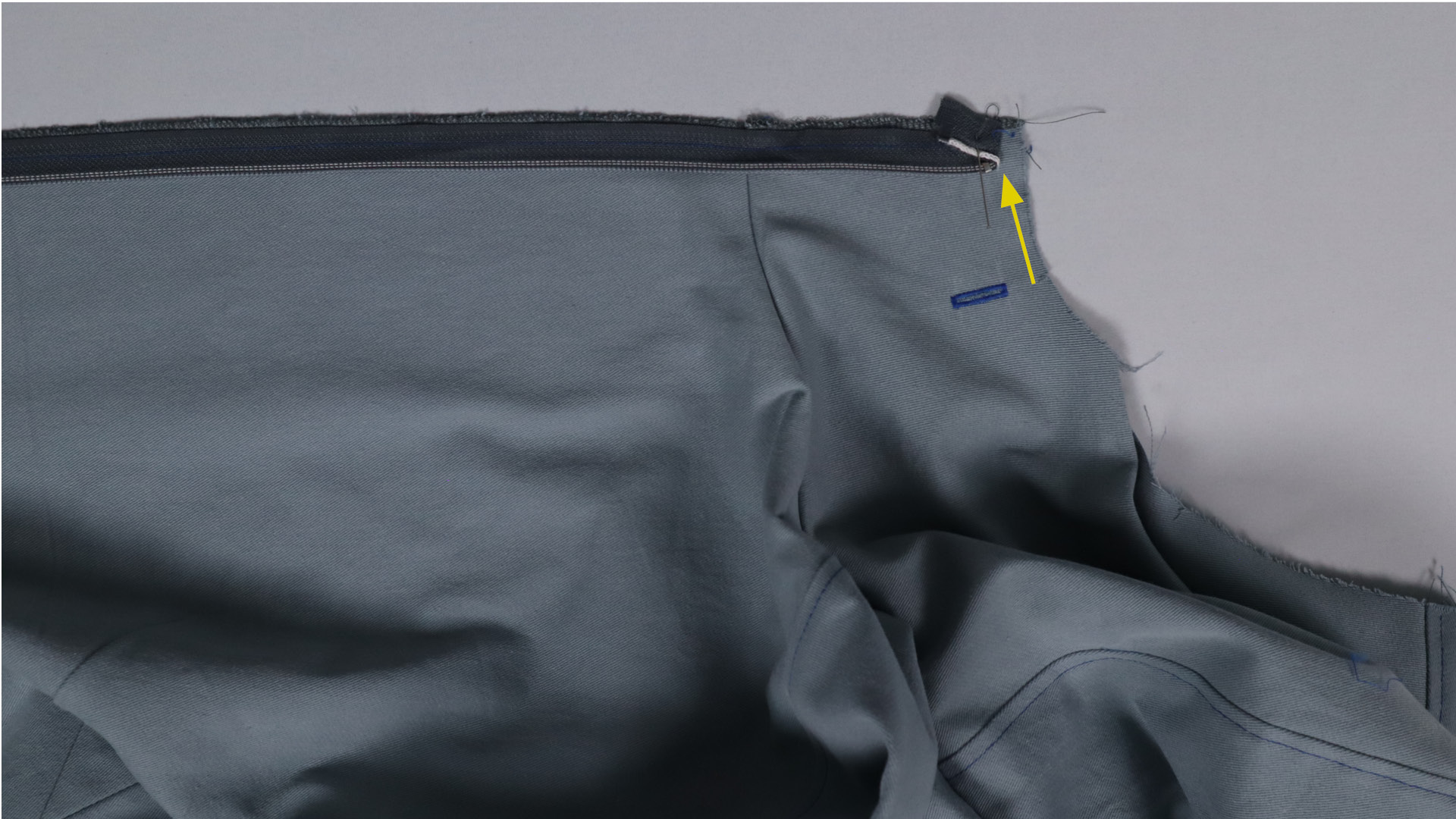
The zipper tape that protrudes at the upper end is folded to the side directly above the teeth/spiral (towards the front edge) and pinned in place.
Sew underlap
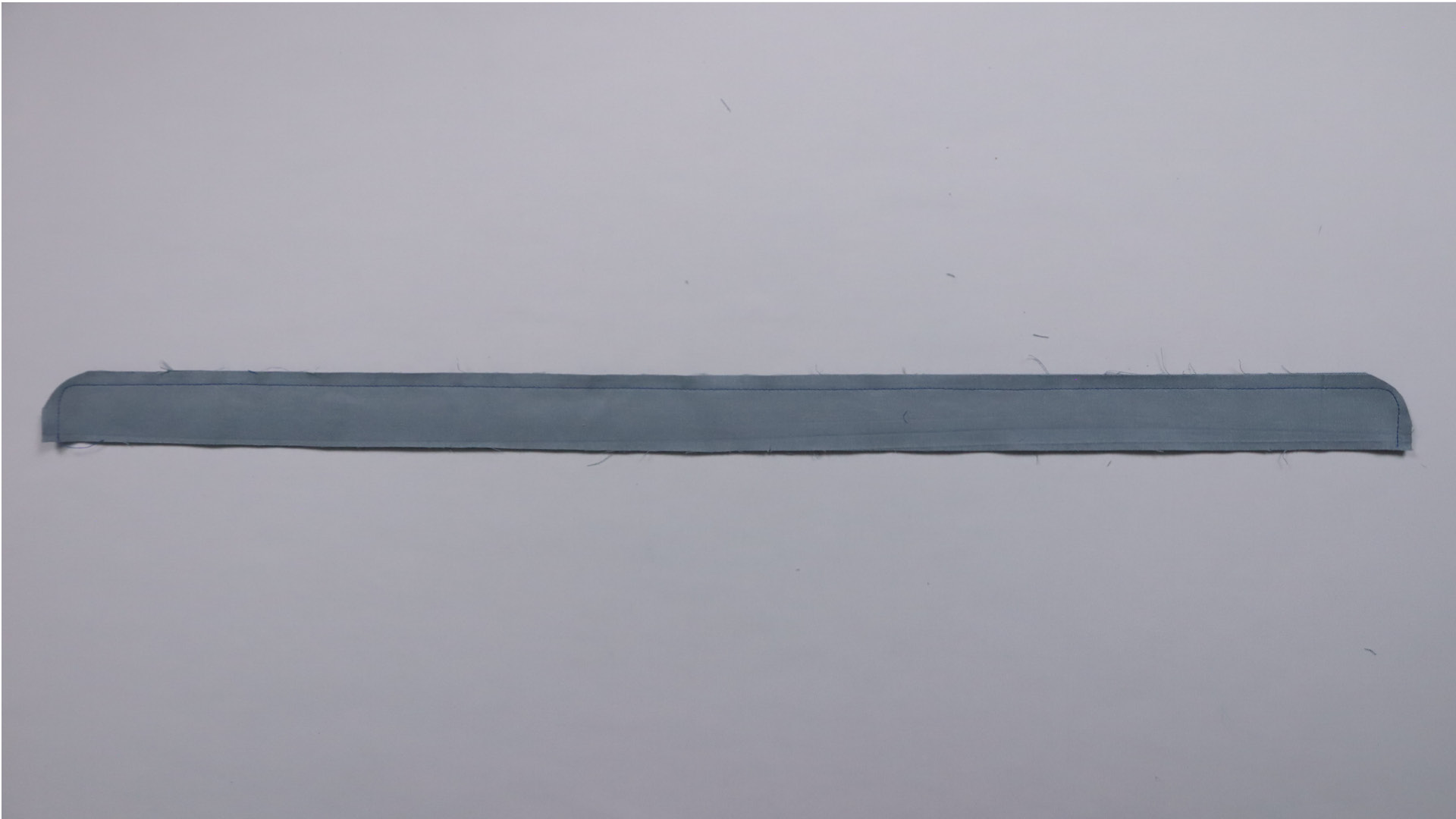
If necessary, reinforce the outside of the underlap with a suitable interfacing. If your outer fabric is very thick, you can also use a thinner fabric for the underside. Bear in mind that if the zipper is not fully closed, it will be visible later when the parka opens up a little.
Then lay both parts of the underlap on top of each other, right sides facing, and pin the short sides, the curves and the long side in between together. After sewing, cut back the seam allowances in the curves.
Check whether the length of the underlap matches the front edge of the parka.
Then press the seam allowances open, turn the underlap and press it again before topstitching the outer edge from the outside close to the edge.
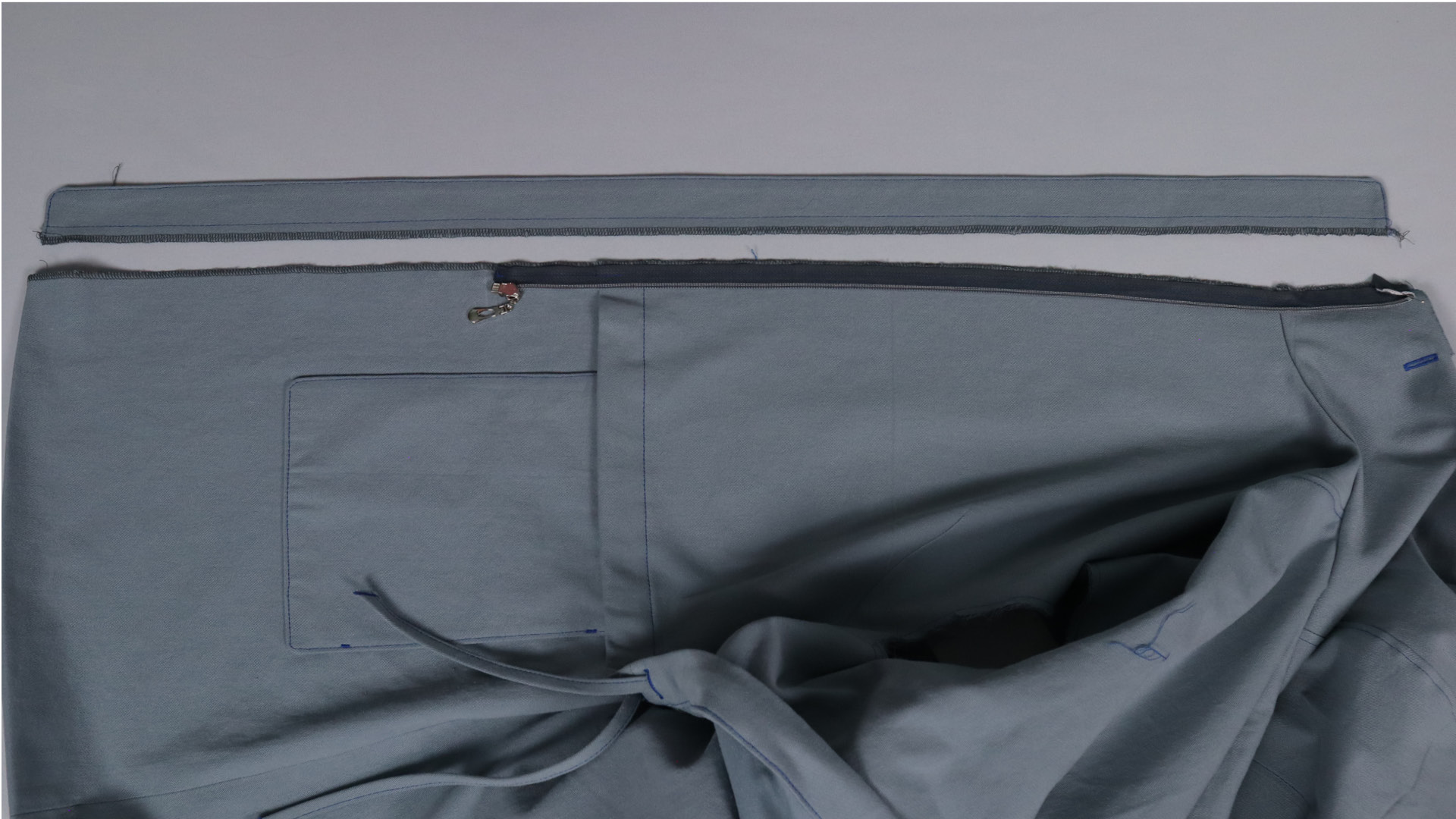 The underlap is attached to the zipper.
The underlap is attached to the zipper.
I topstitched the long, straight side at a distance of approx. 1.8 cm from the edge to prevent the fabric from getting stuck in the zipper later.
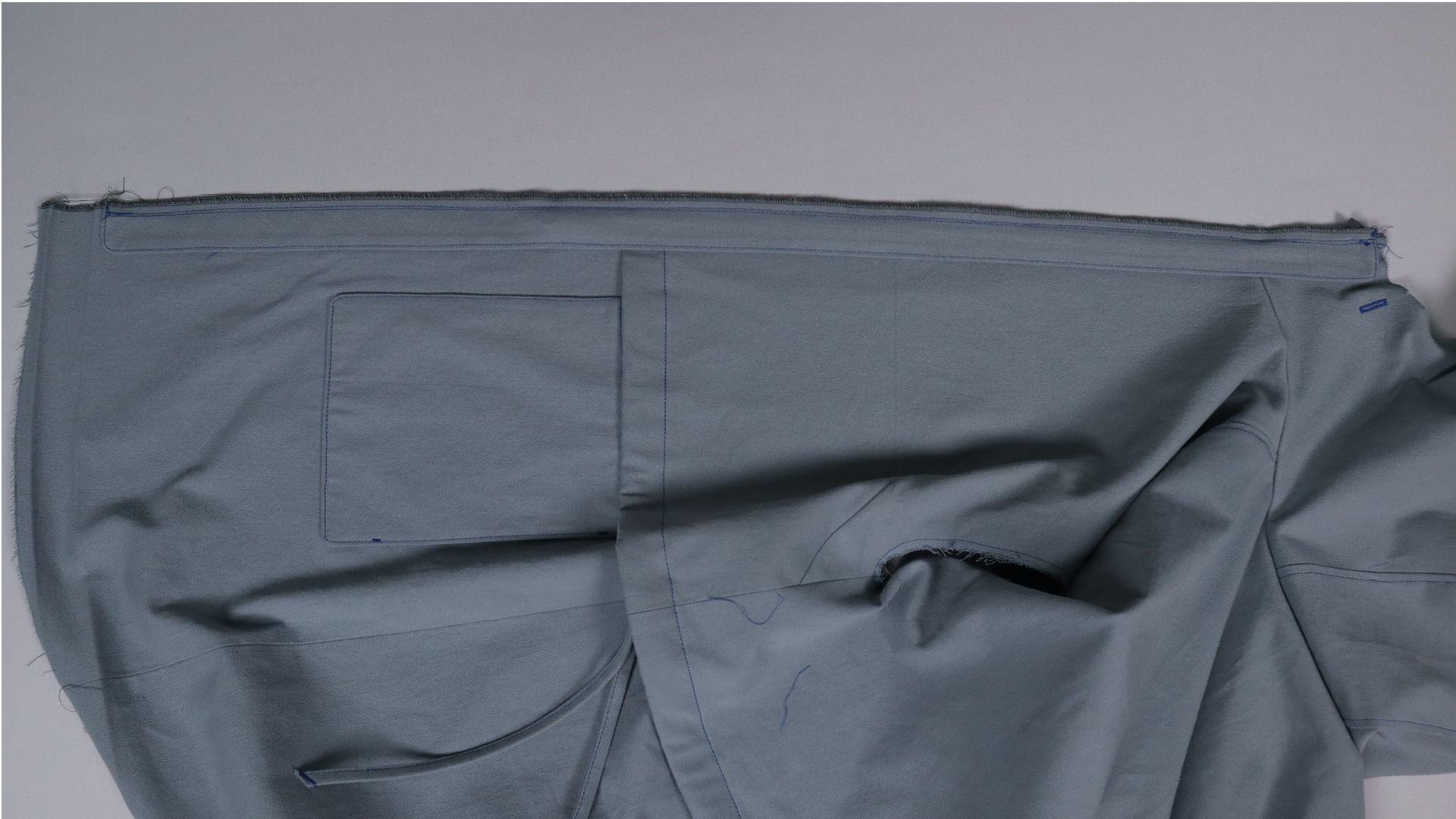
Now sew the underlap on the left front piece under the zipper. To do this, place it on the front piece with the side that will later be visible from the outside so that the zipper is in between.
The underlap just barely covers the zipper at the top and almost reaches the folded edge of the hem at the bottom.
It is best to sew the underlap in place from the inside of the parka. This way you can sew next to the previous seam and the zipper tape remains visible at the correct width. The hem is not yet sewn in place!

Now fold the hem up along the already ironed edge, right sides facing and pin in place.
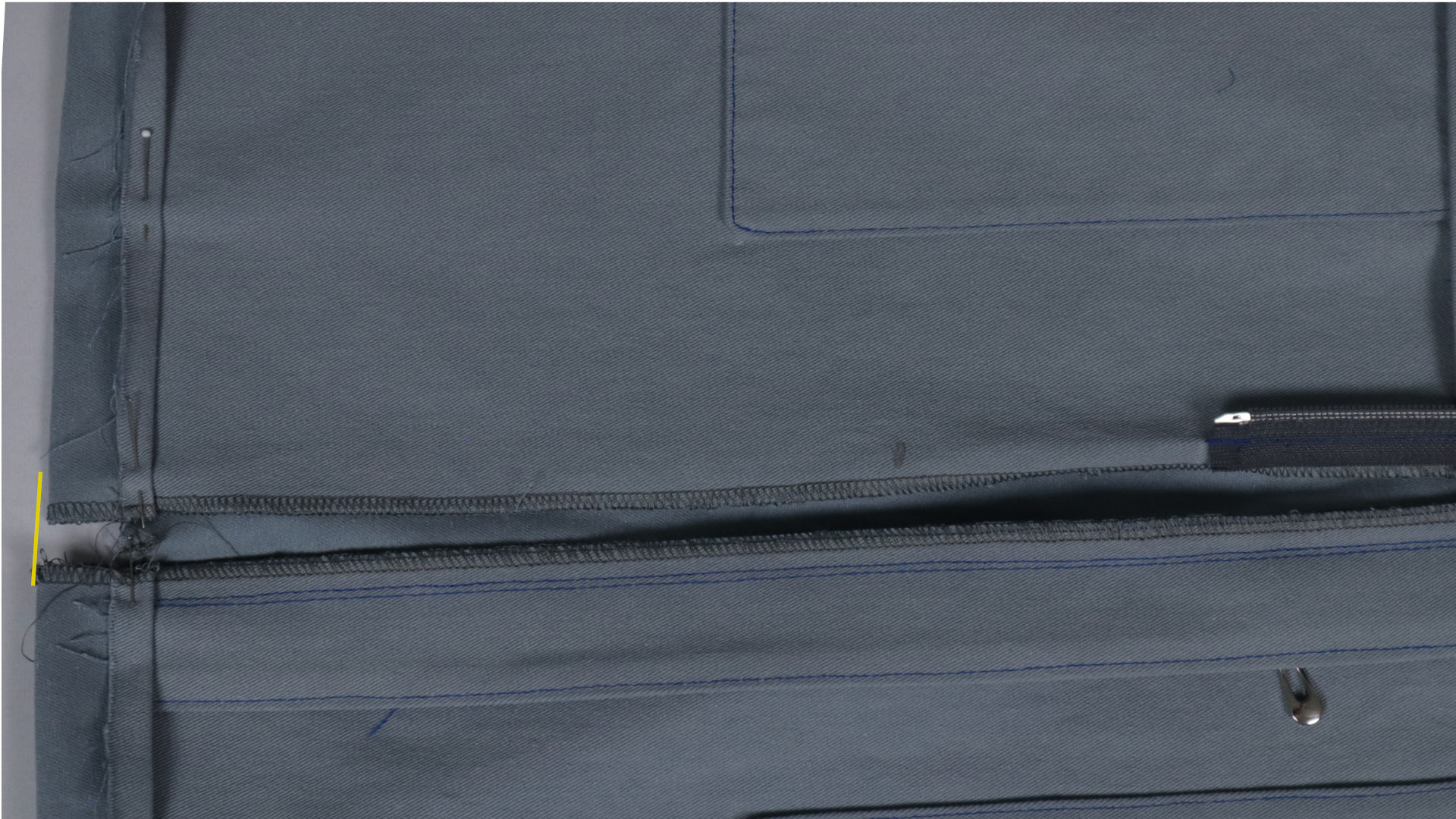
Make sure that the distance from the end of the zipper to the folded hem edges is the same on both front pieces.
Sewing the inner lining of the parka with hood
If your lining fabric is very frayed, I recommend neatening the lining pieces all the way around before sewing them together. Otherwise, you can neaten the seam allowances after sewing them together or cut them back with pinking shears.
In addition to the lining fabrics, you will also need the front facing and the hood facing. If you are using a very thin or soft fabric, these parts should be reinforced with a suitable interfacing that is not too firm.
Sew the front and back
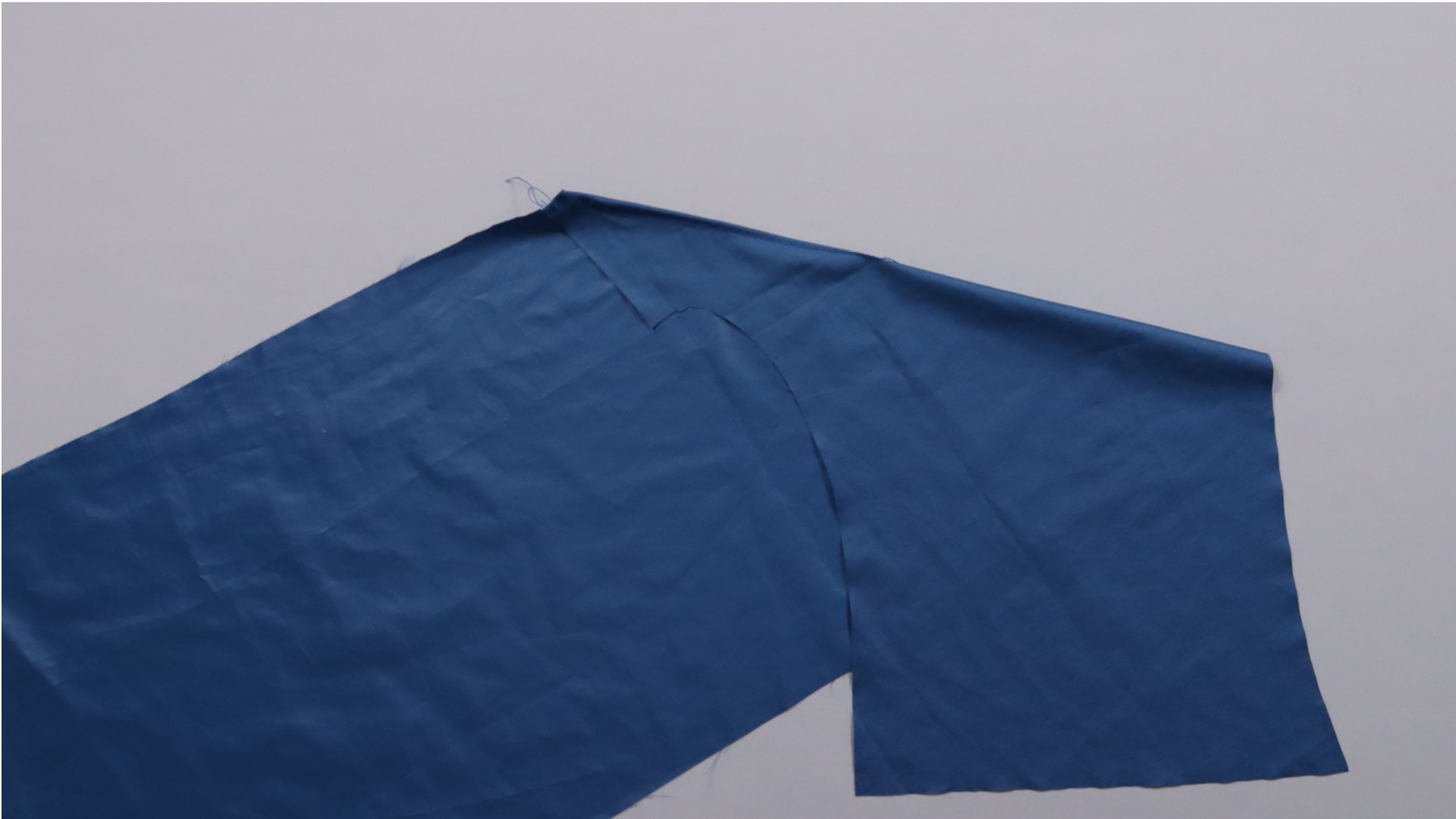
First, sew the darts on the two front pieces and press them towards the shoulder seam.
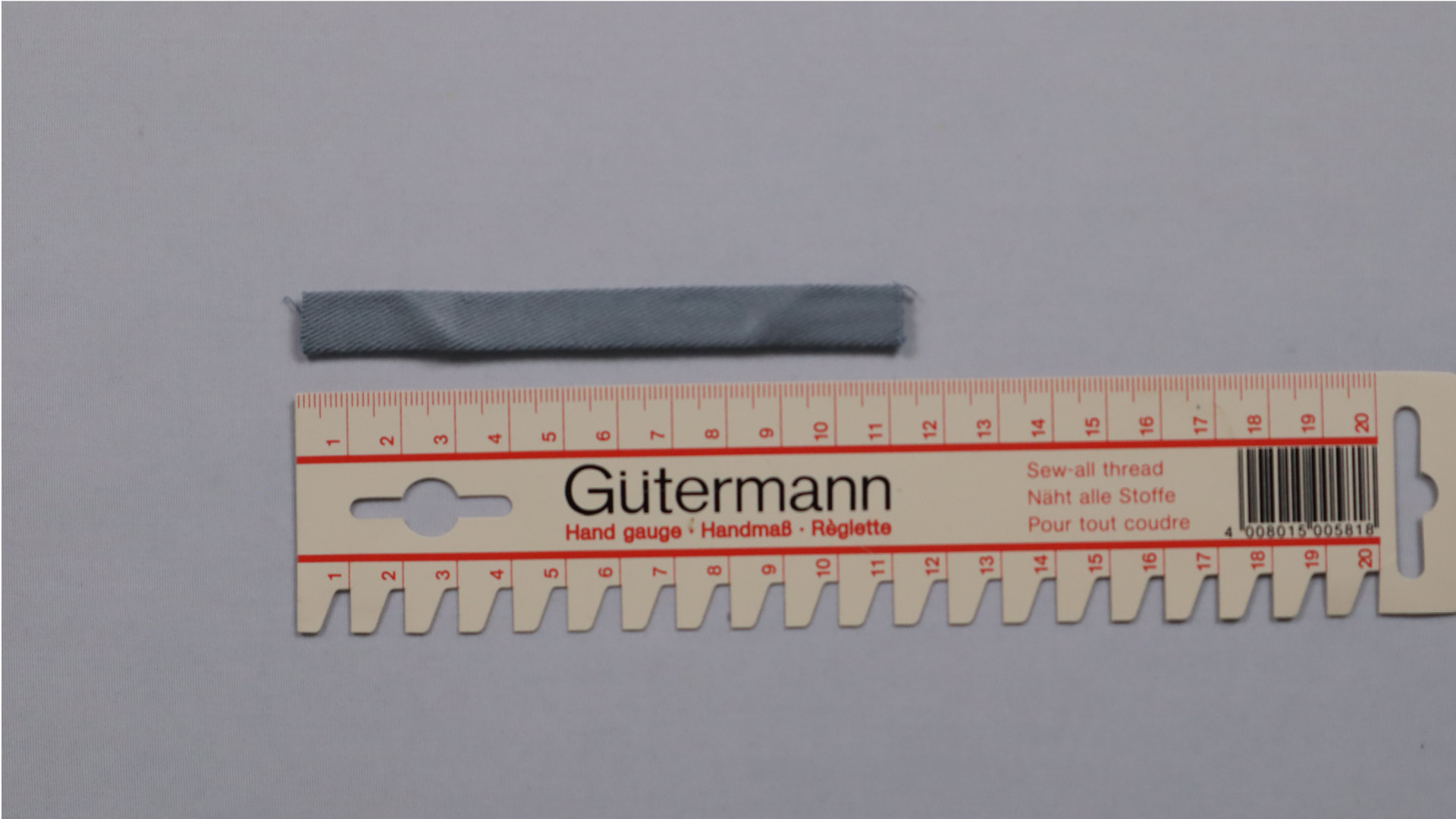
Then I prepare the hanging ribbon and do this in the same way as I sewed the ribbons for the turtleneck and hood.

The ends are ironed vertically upwards so that the finished ribbon is approx. 8 cm wide.
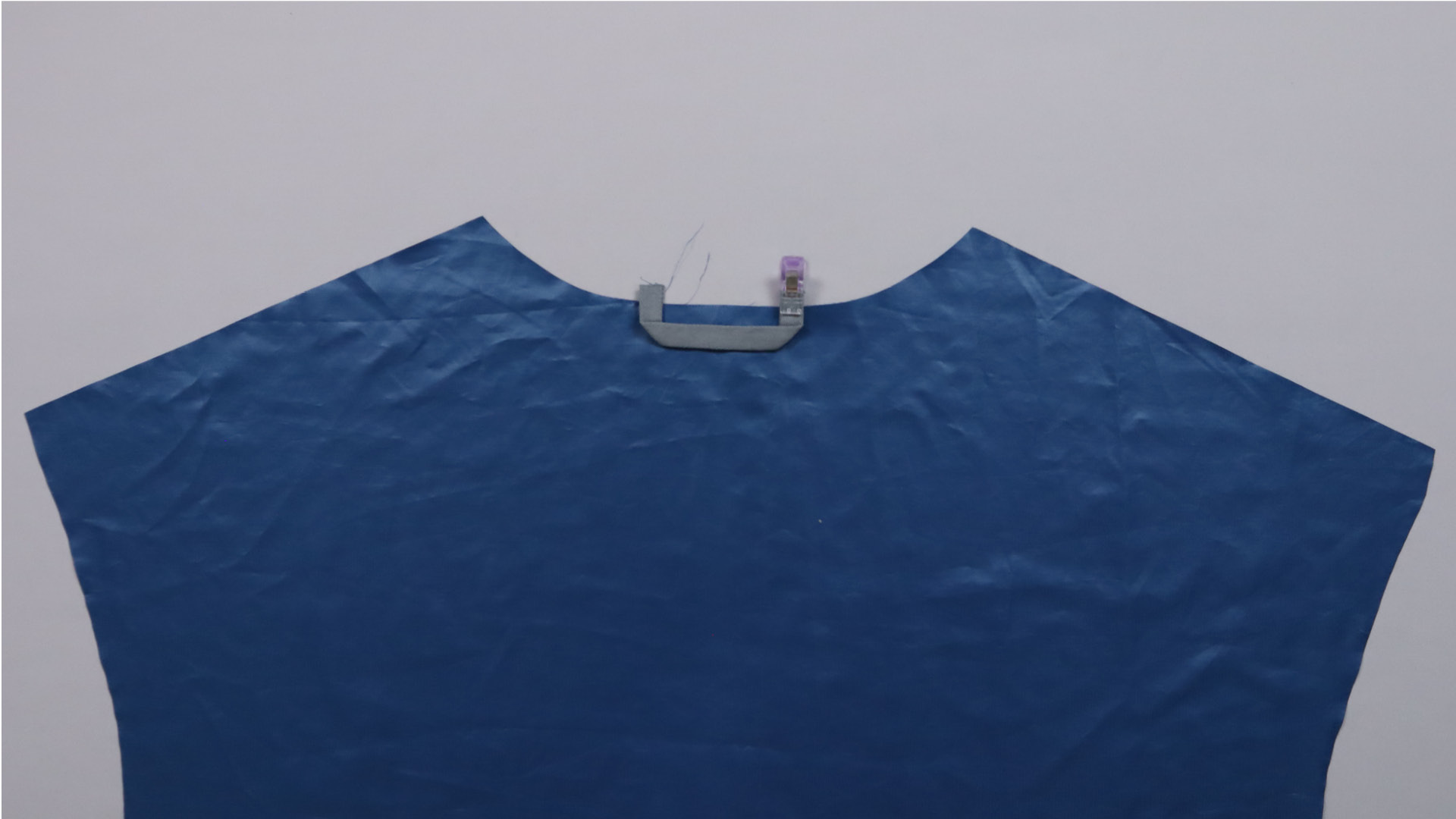
The ribbon is then sewn to the center of the neck hole on the lining back within the seam allowances.
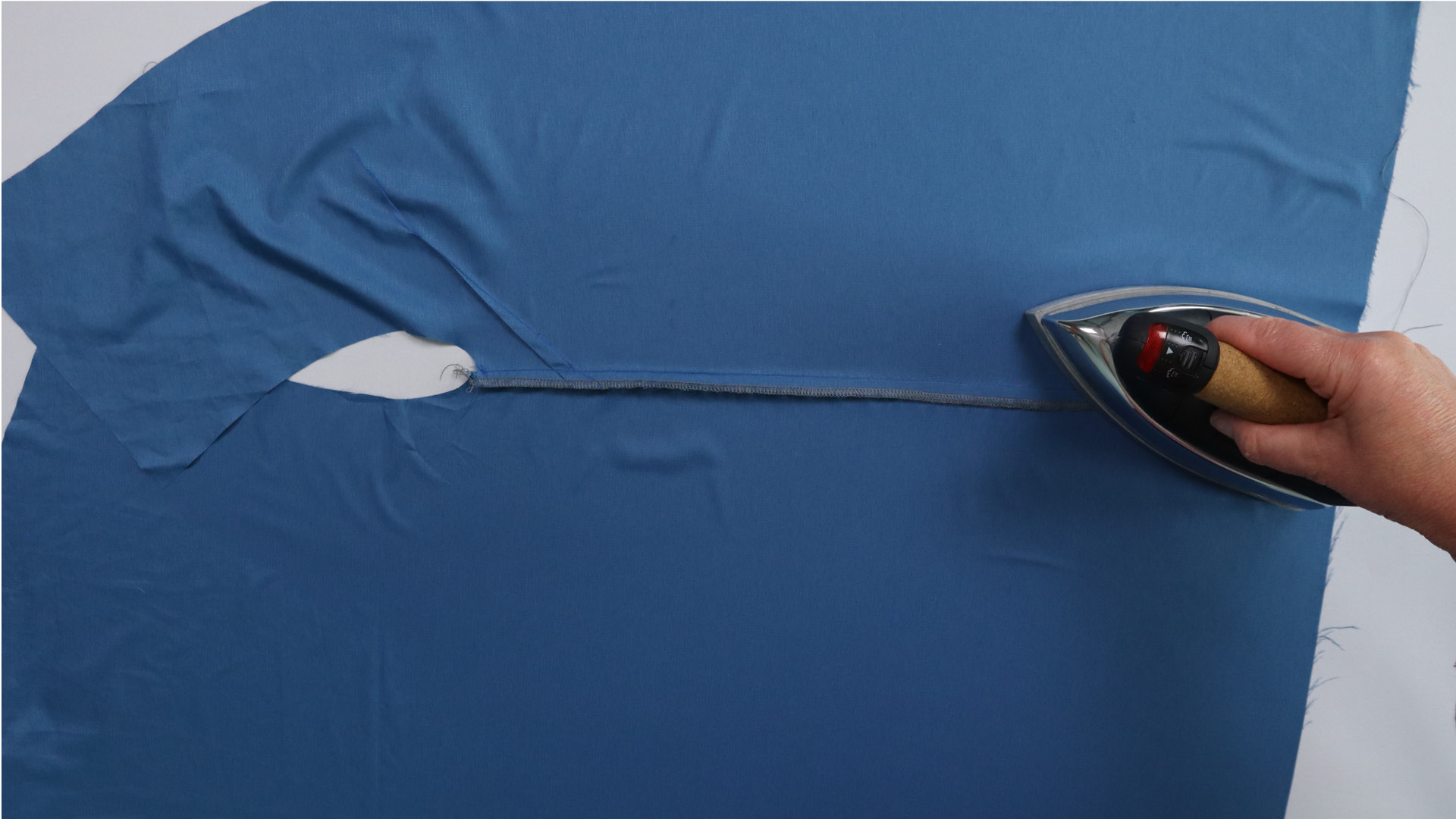
I close the side seams and press the seam allowances towards the back.
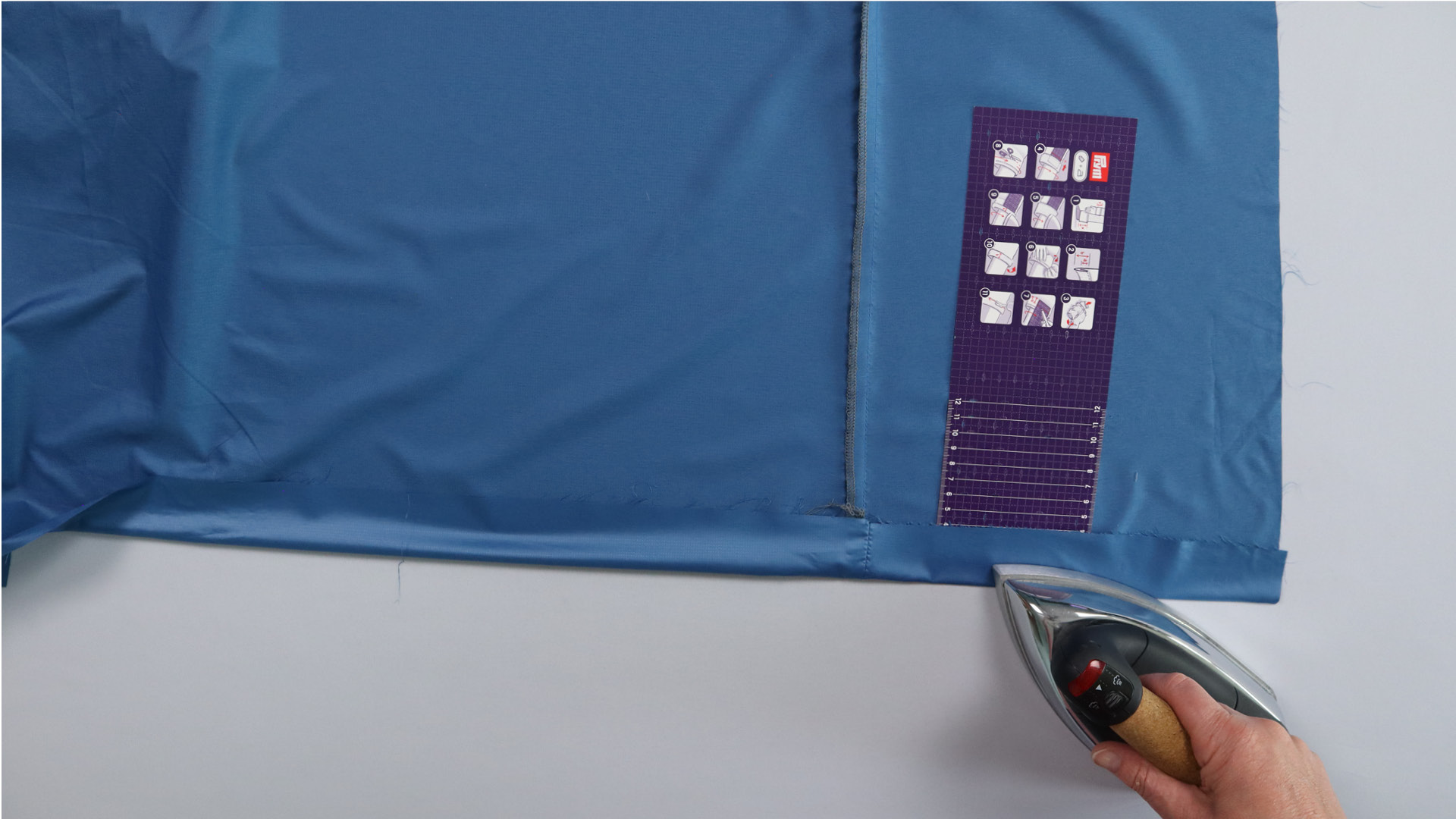
The hem is turned in twice. I first press it inwards according to the notches.
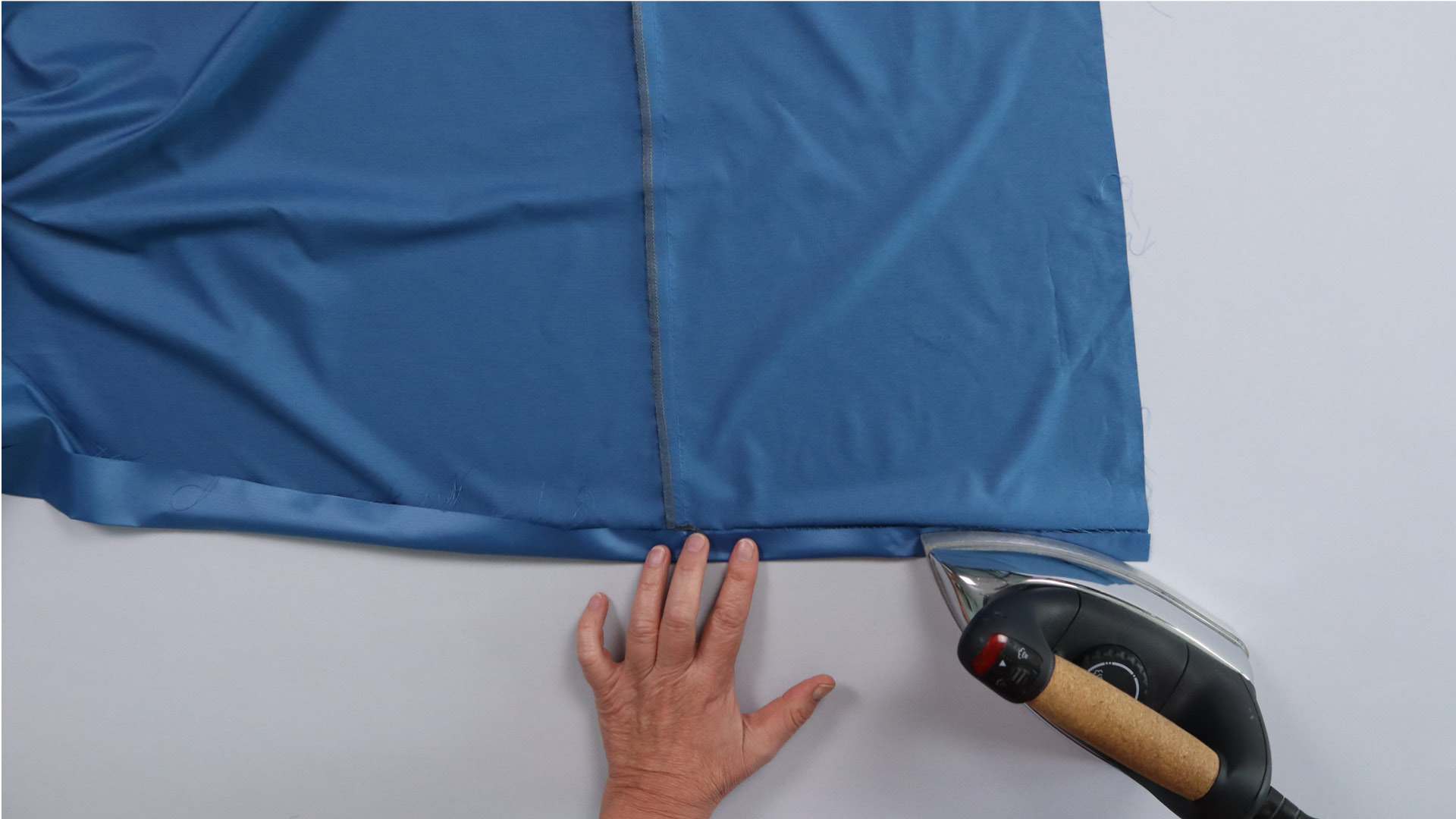
Then I fold the pressed hem in half again and press the edges.
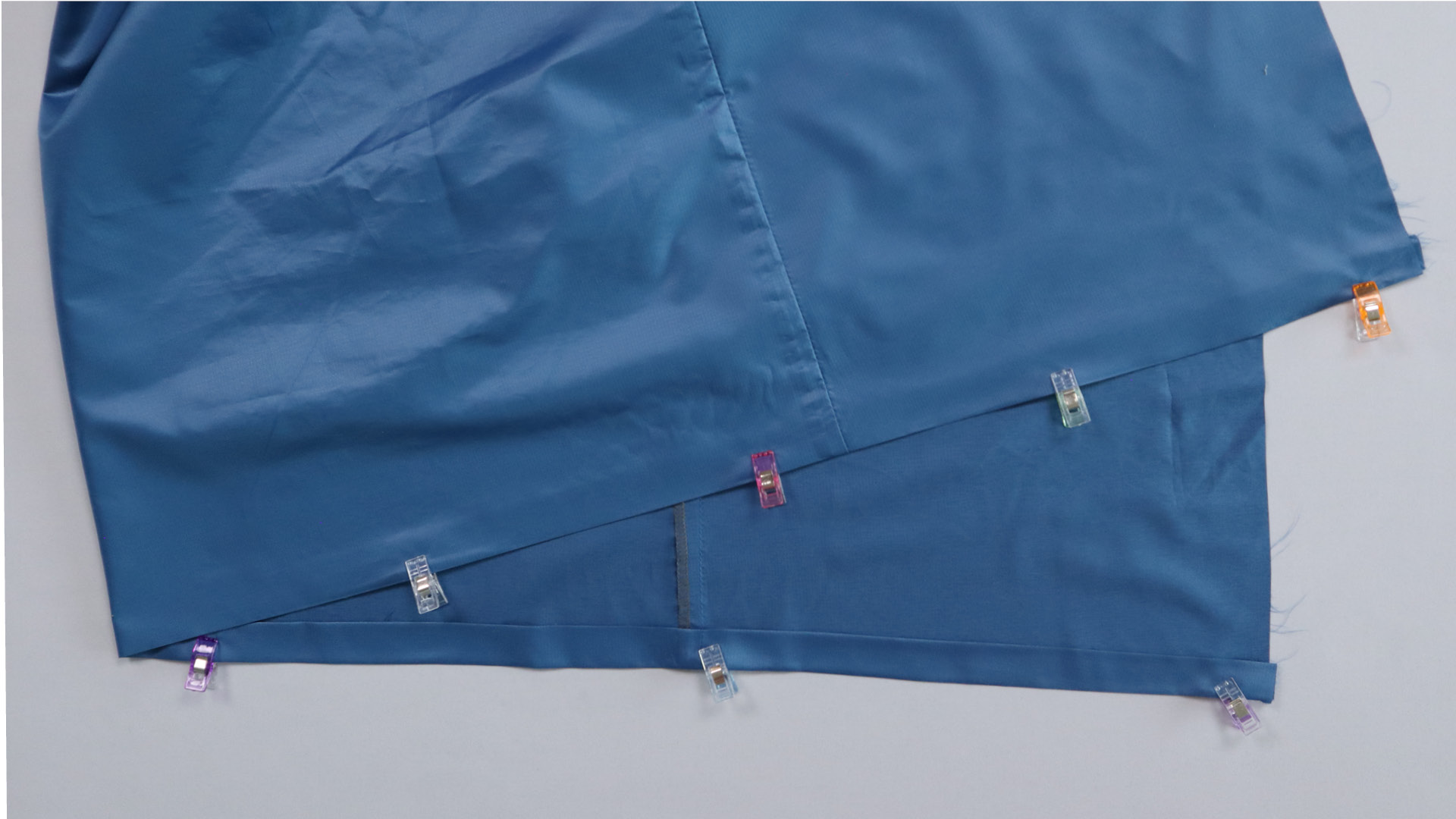
I pin the hem along the entire length and then sew it close to the edge.
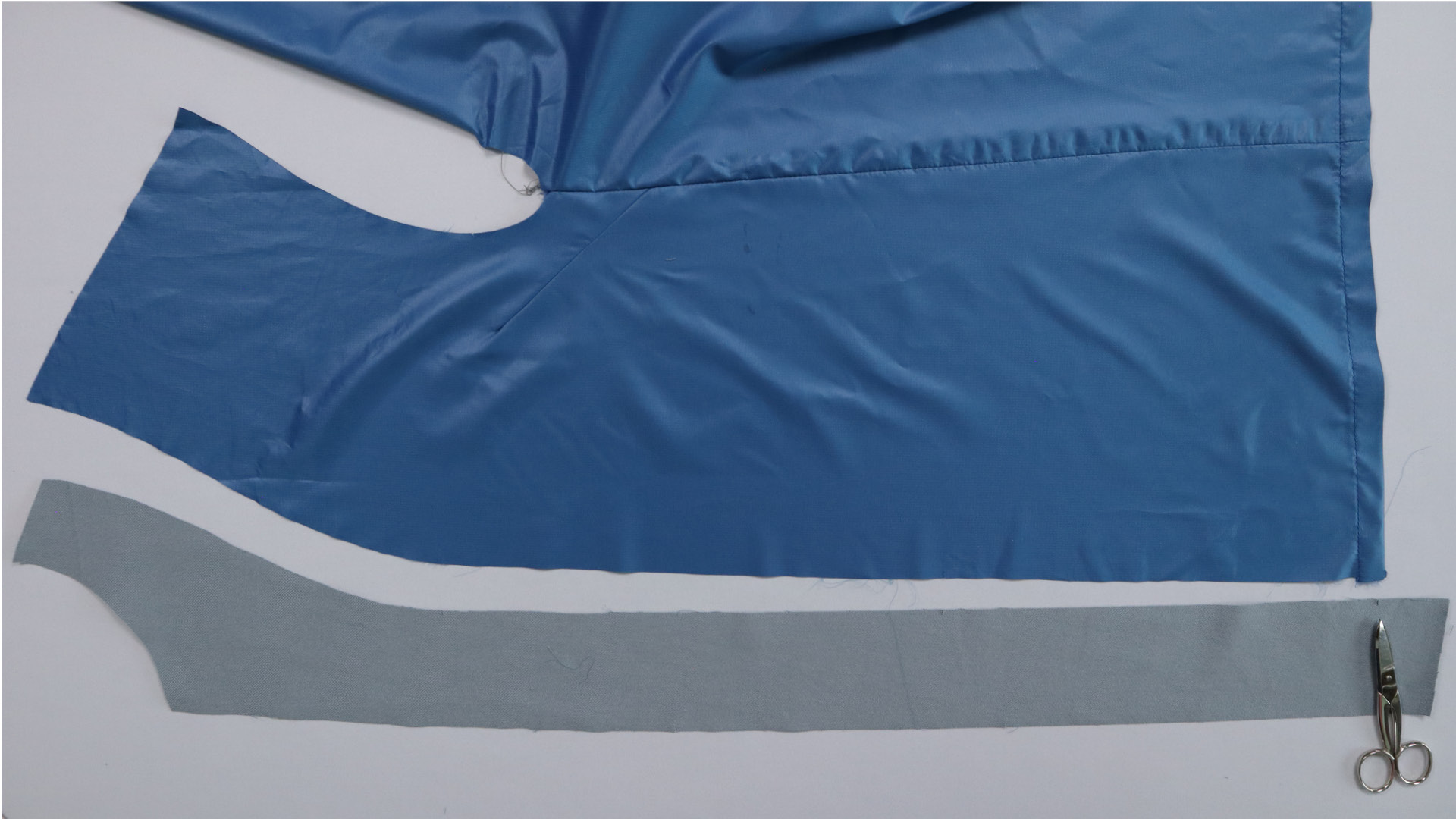
Next, the front pieces are sewn to the facing.

They are pinned right sides together. The facing overlaps at the lower end.

I have finished the seam allowances together here. They are ironed to the facing along the entire length and then topstitched close to the edge from the right.
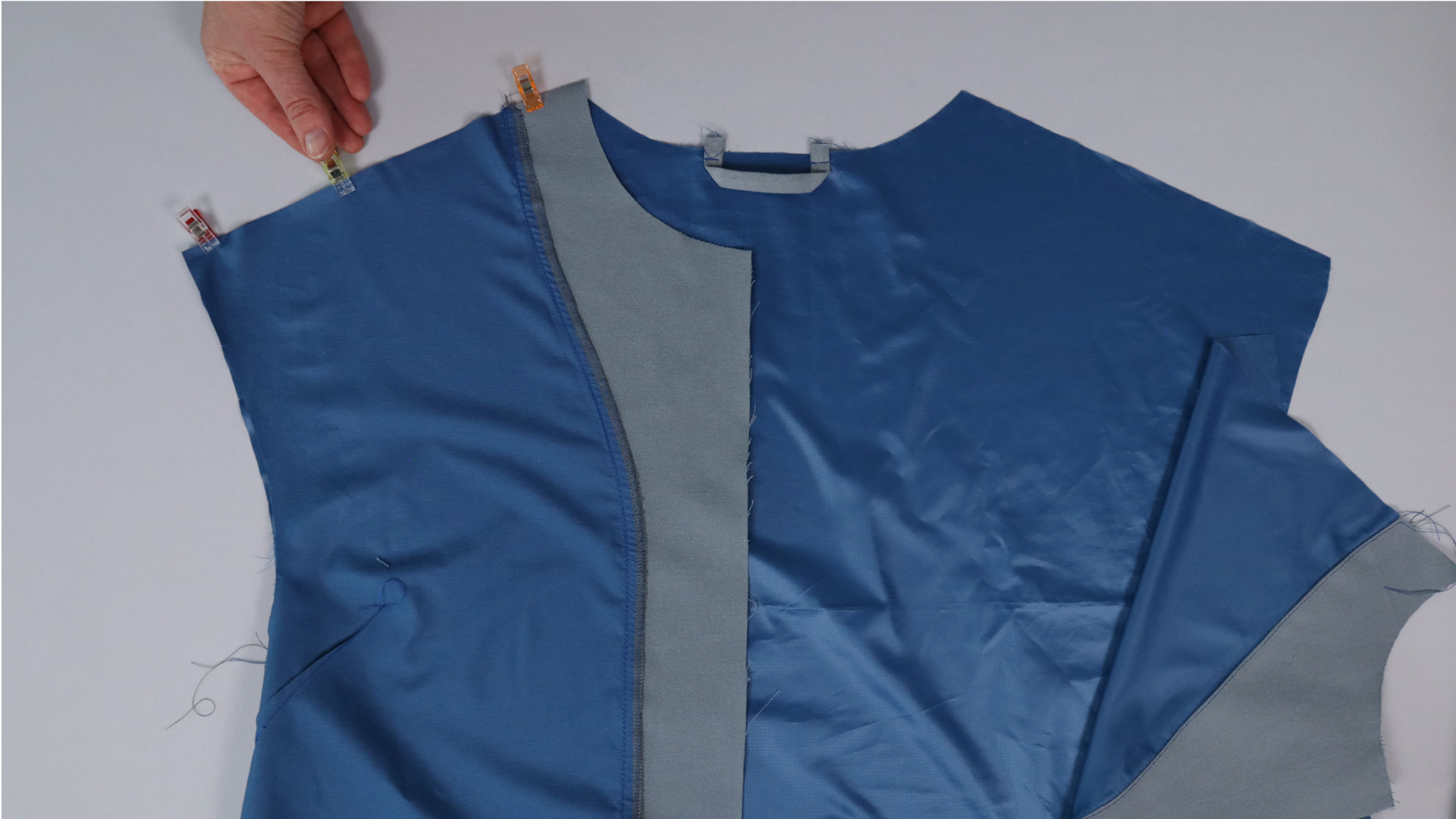
Once this has been done on both sides, the shoulder seams are closed.
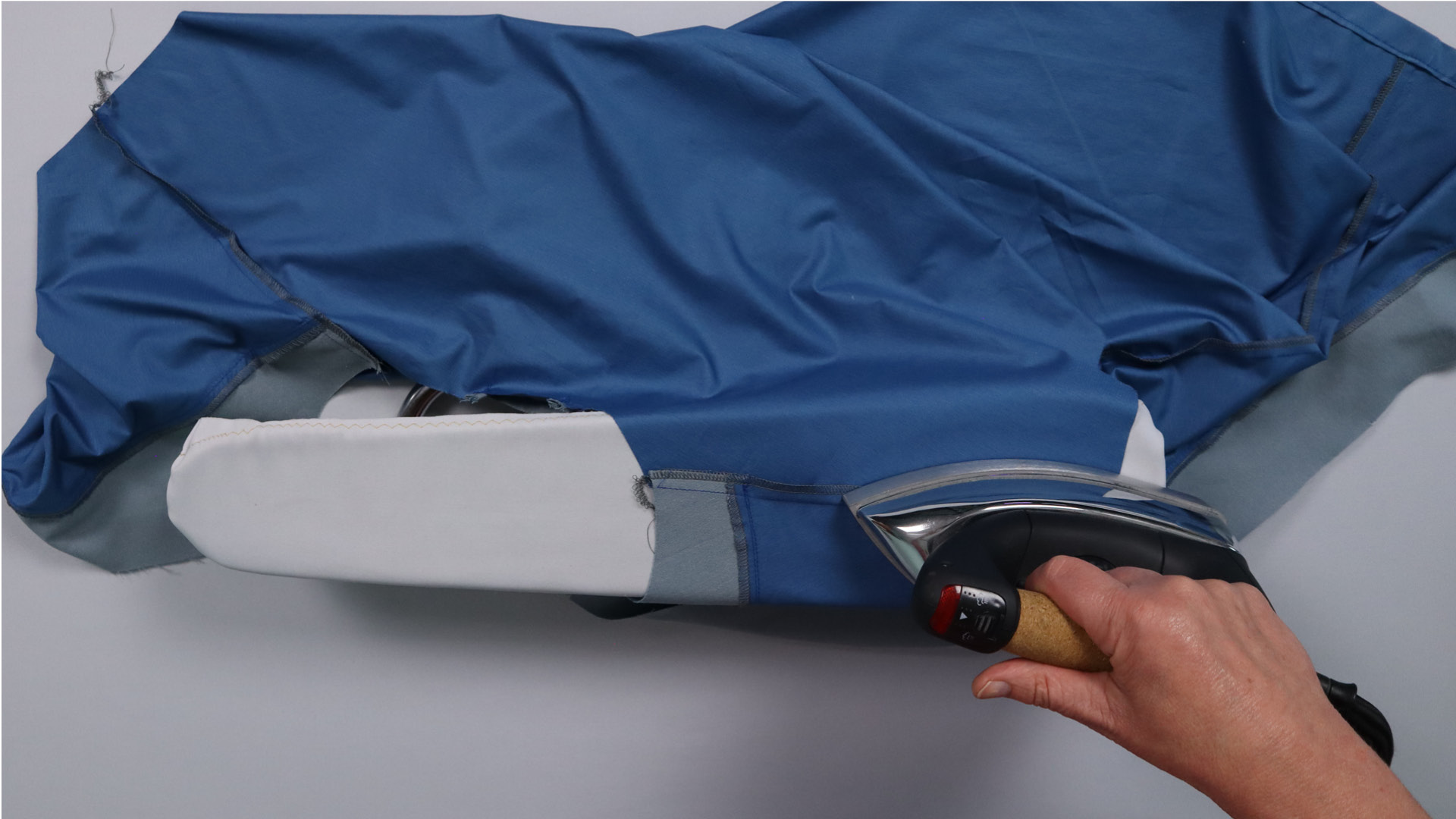
The seam allowances are ironed to the back.

This is what the lining for the body of the parka looks like.
Sew lining hood

The middle section of the hood is now joined to the two side sections. As with the outer fabric, the middle section is pinned to the side sections, paying attention to the notches. When sewing, make sure that the fabric is always smooth and that no creases form. Iron the seam allowances to the middle section.

The lining hood is then sewn to the back edge of the hood facing.
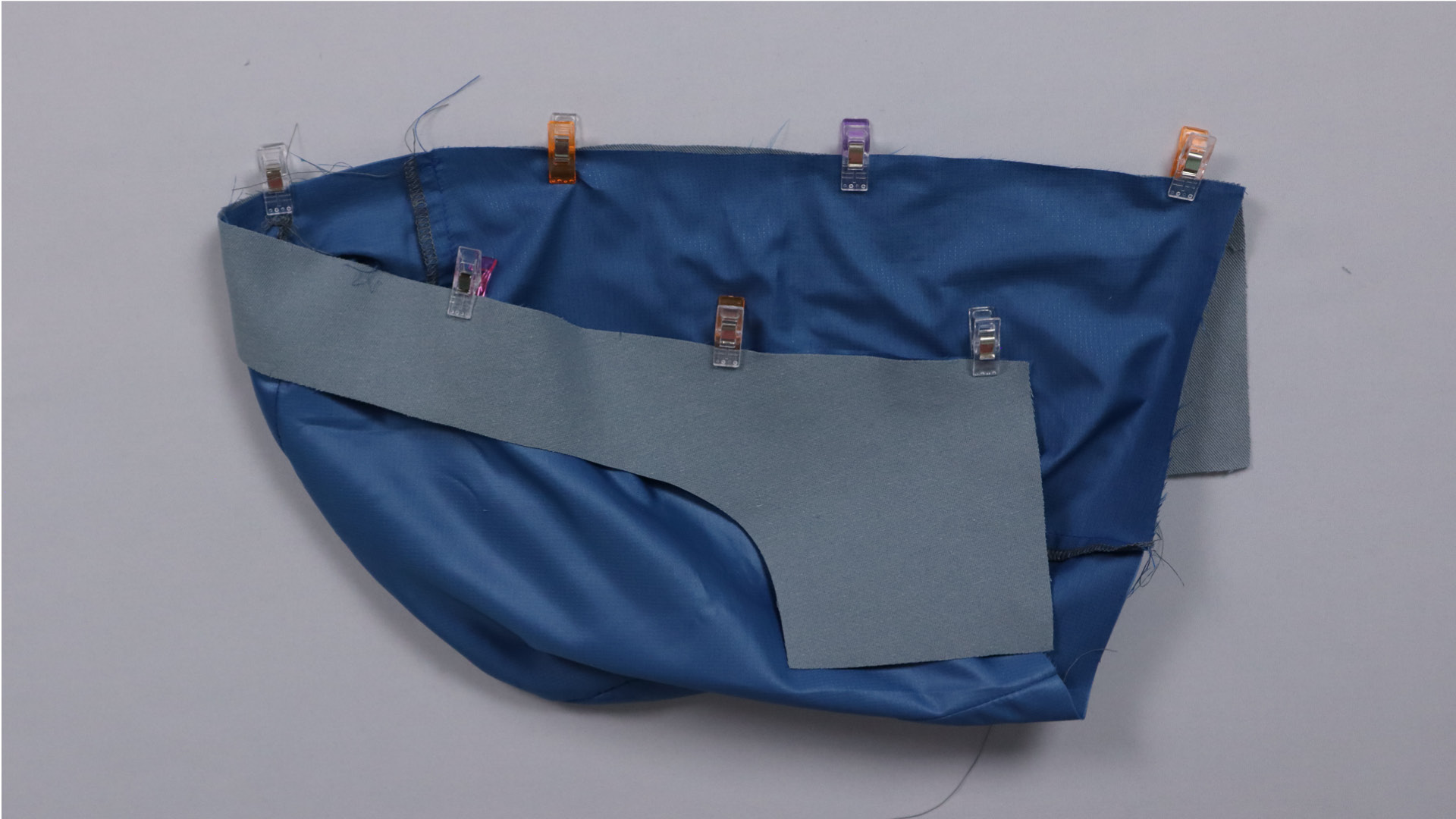
To do this, I pin them to the facing, right sides together, and sew them together.

I press the seam allowances towards the lining and topstitch close to the edge.
Sew the hood to the lining parka
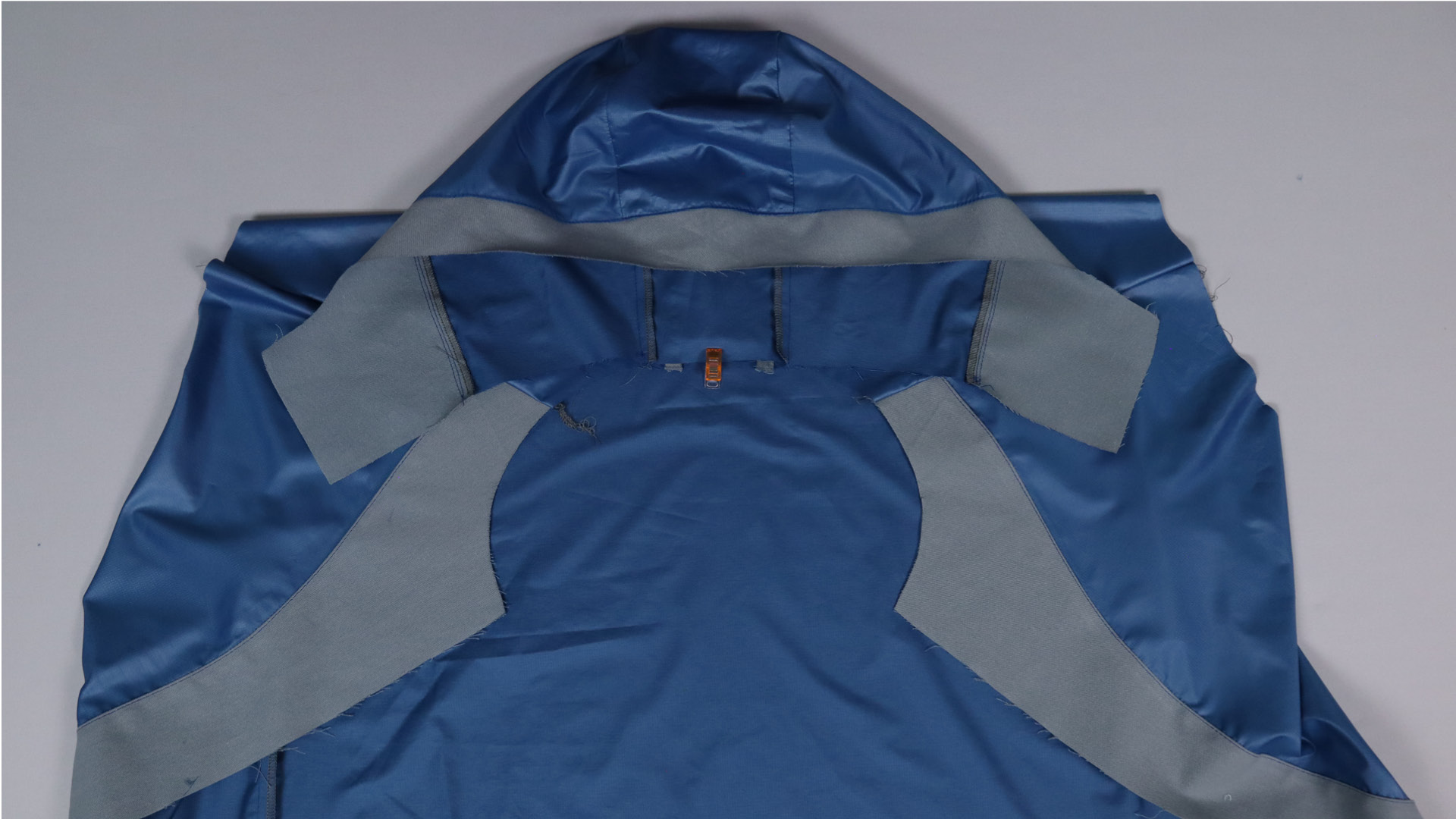
I pin the lining hood to the neck hole, starting at the center back, right sides together.

When it is pinned along the entire length, I sew it on.
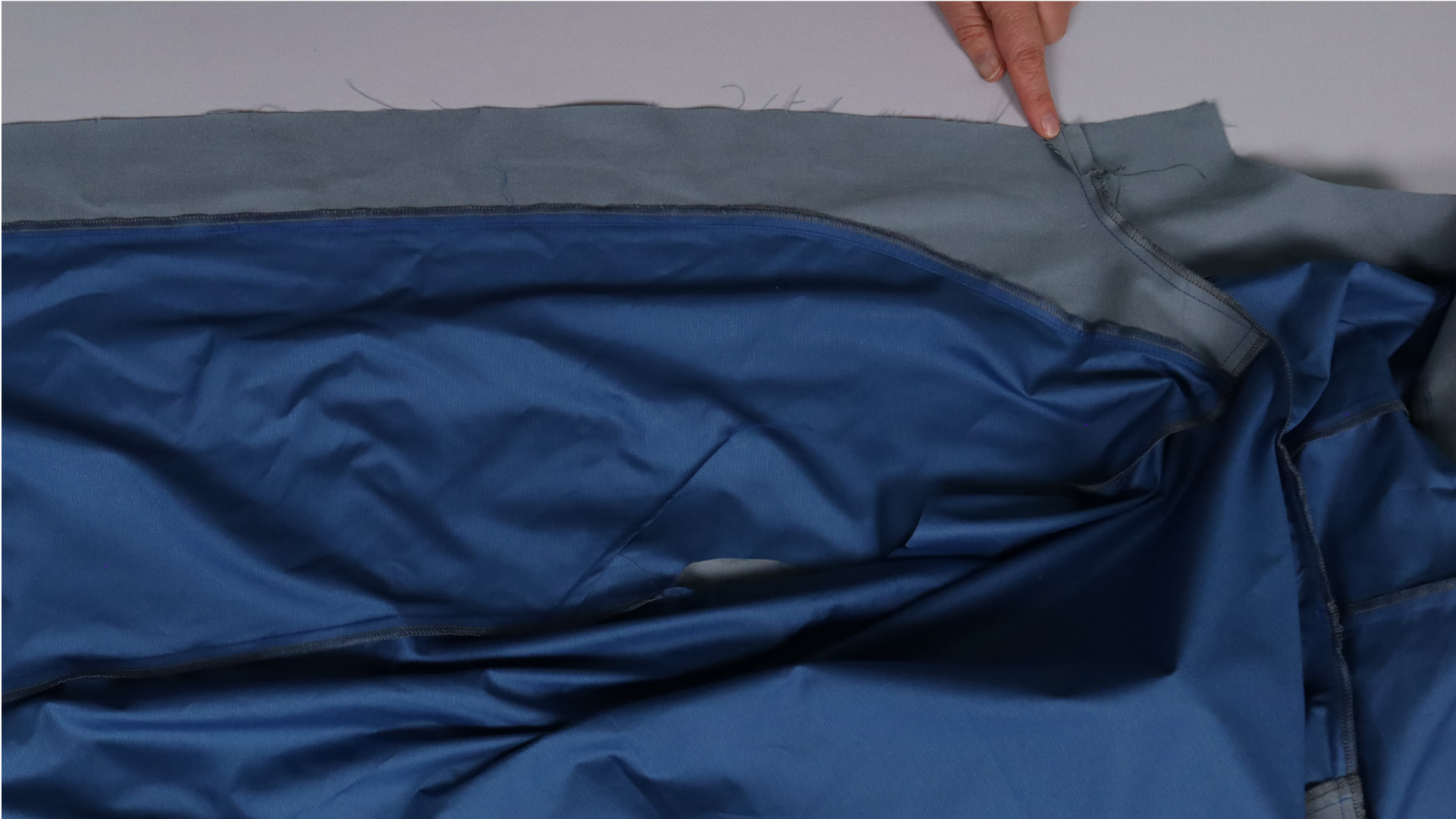
The seam allowance of the hood is also cut on both sides approx. 4.5 cm from the front edge and ironed apart in the front area. Press the remaining seam allowances towards the hood.
Joining outer fabric and lining
Sew the parka parts together

The lining and outer fabric of the parka are now sewn together.

To do this, pin the front edges and the edge of the hood together, right sides facing.

Starting at the turned-in hem, the facings are sewn all around the outer parka.
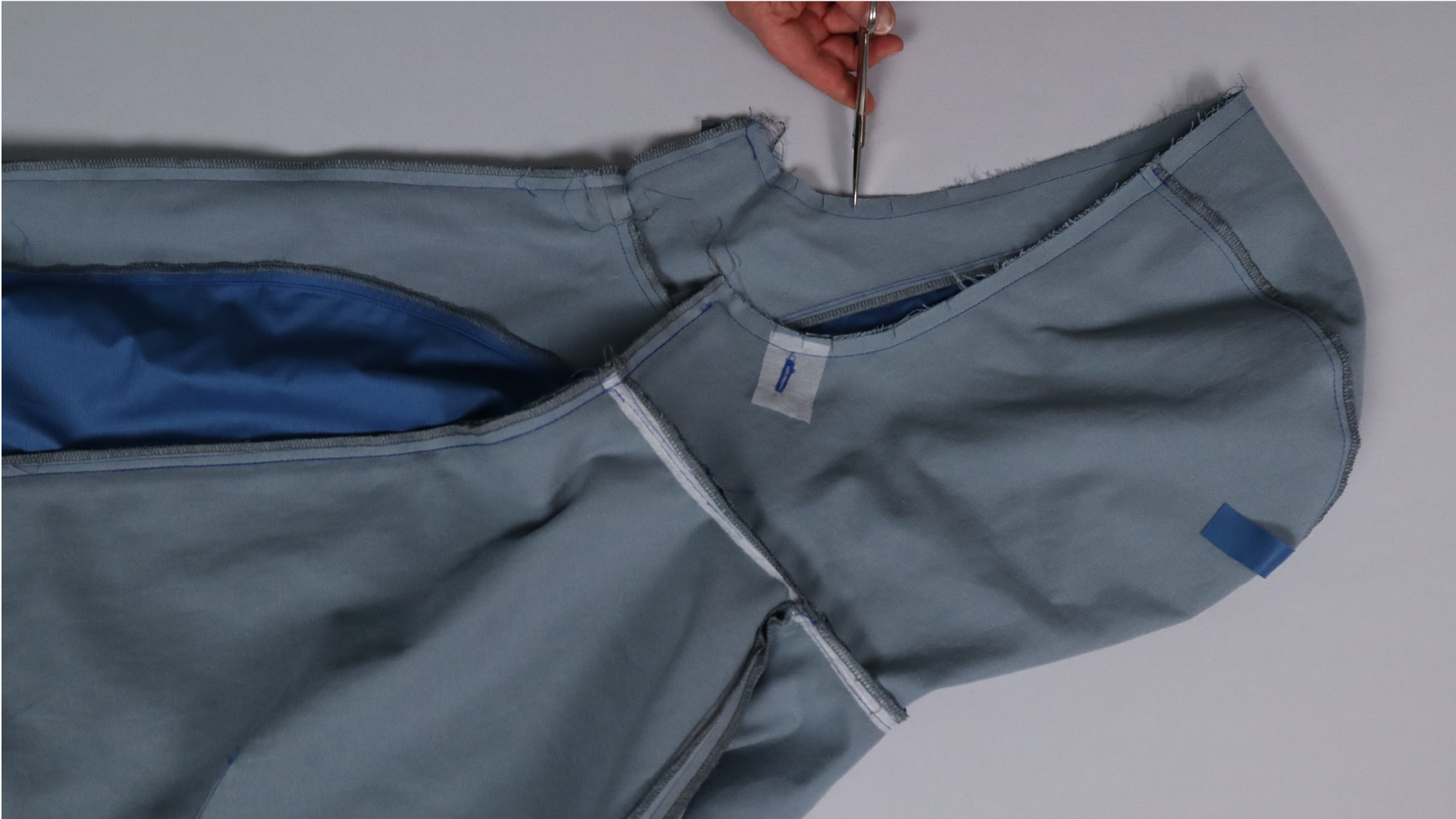
I cut the seam allowance on the front edge of the hood in the curves so that it does not stretch after turning.
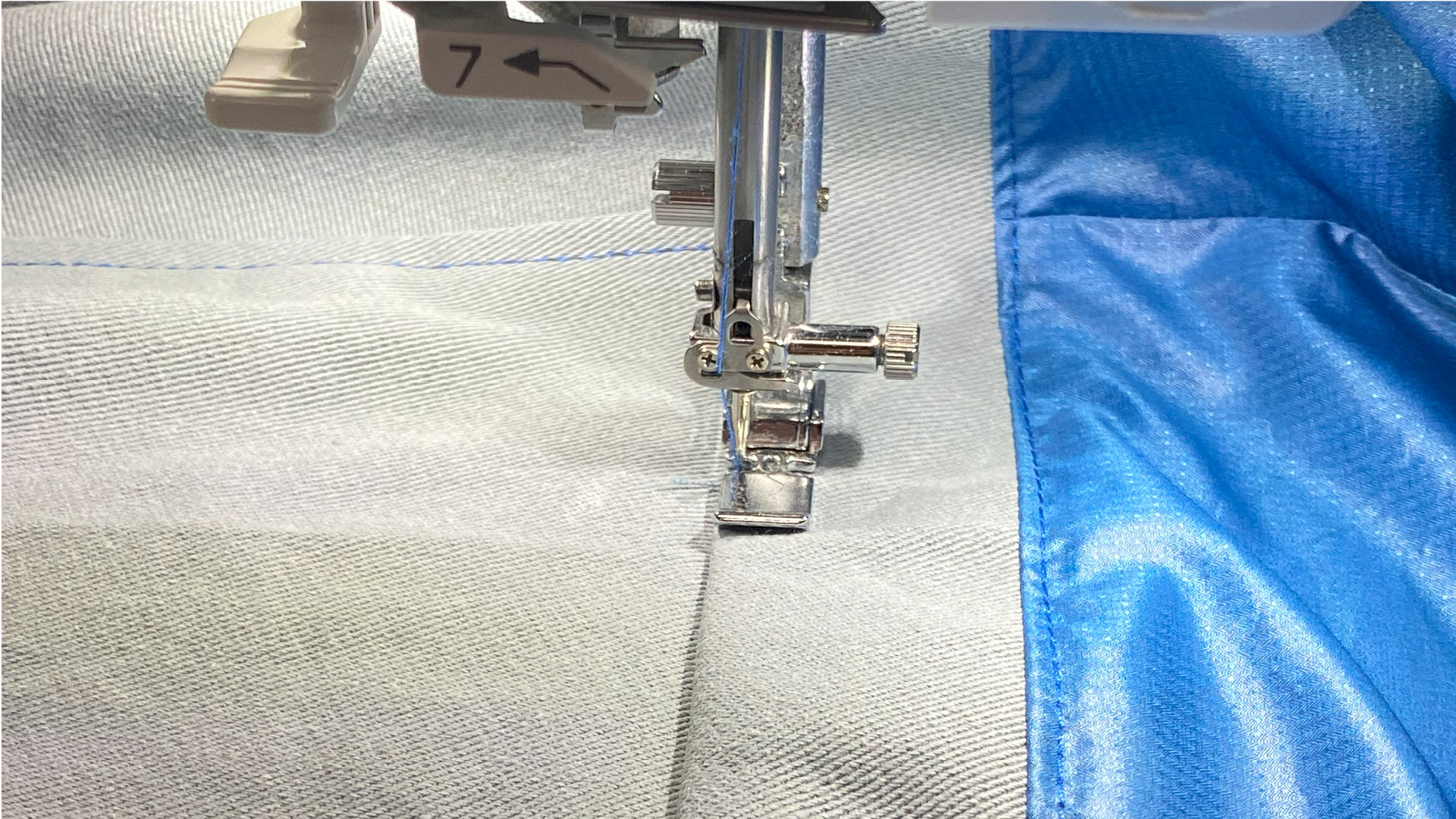
Then I topstitch the hood facing onto the seam allowances close to the edge.
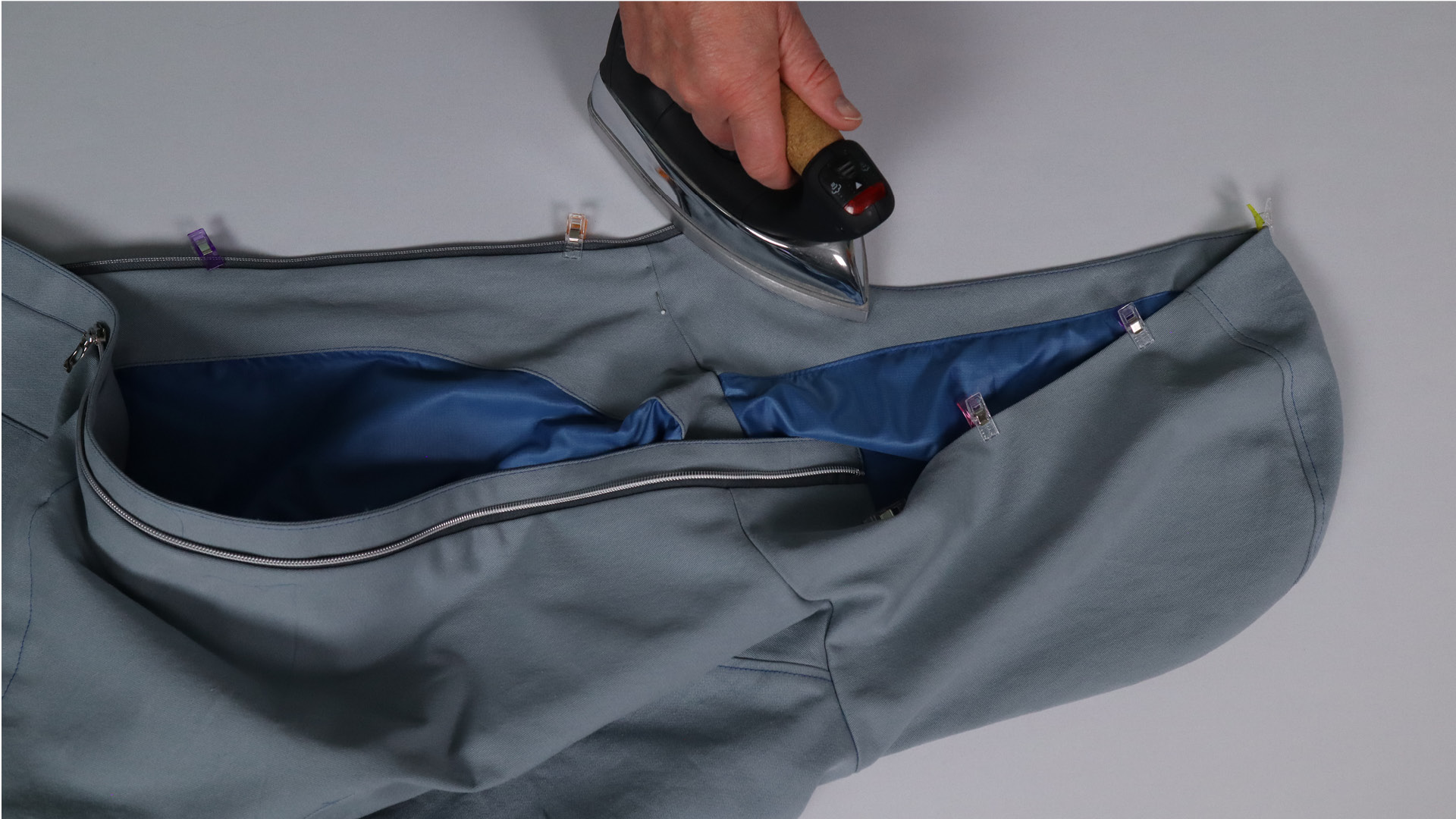
After turning the parka inside out, I press the seam allowances on the front edge of the parka and hood flat and pin them.
Topstitch the center front, hem and hood
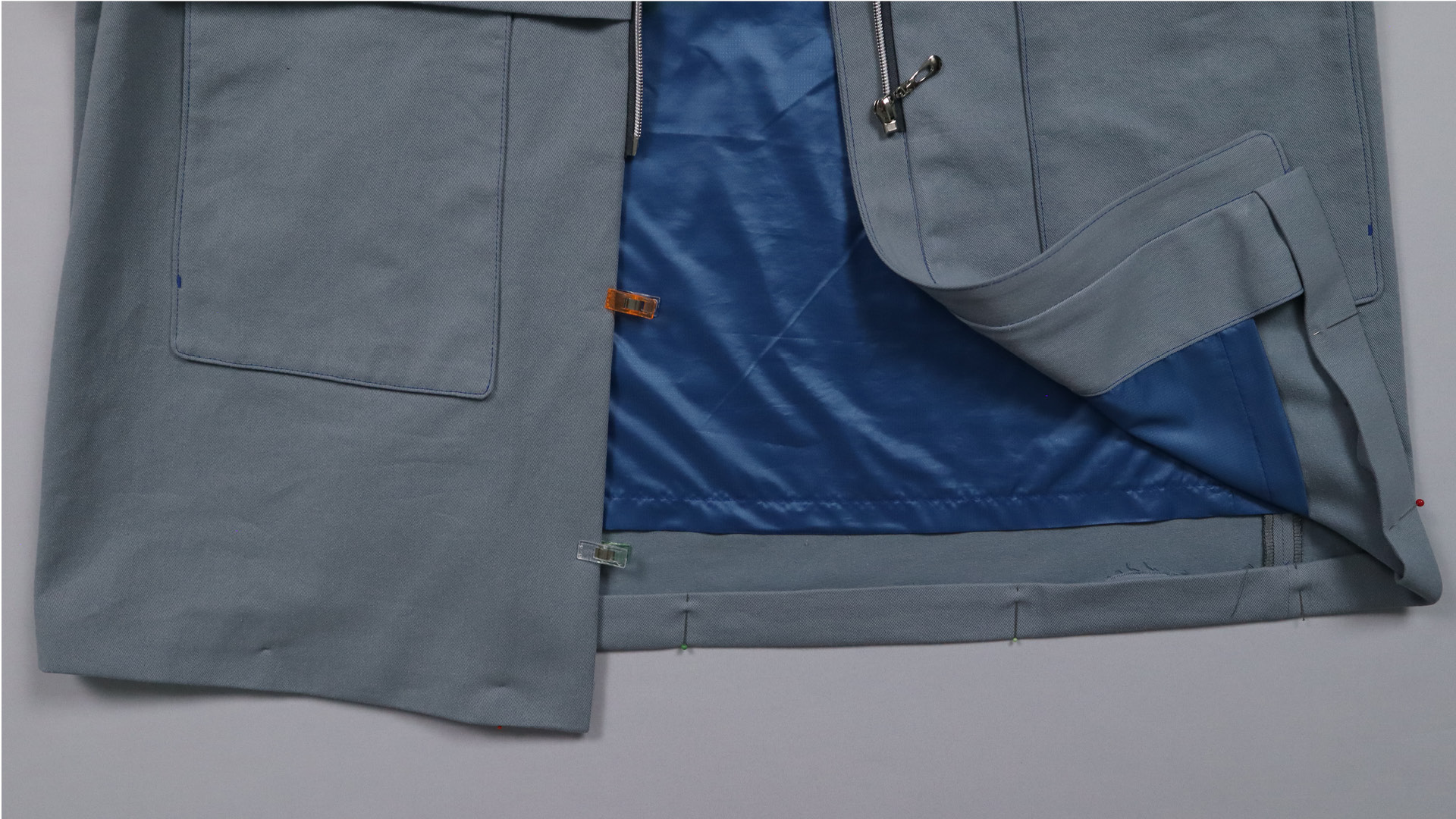
I shape the corners of the hem and press it again before pinning it. The lower ends of the facing are in the hem fold.
Don’t be confused by the length of the lining in the picture – on your parka it is longer and goes all the way to the hem.
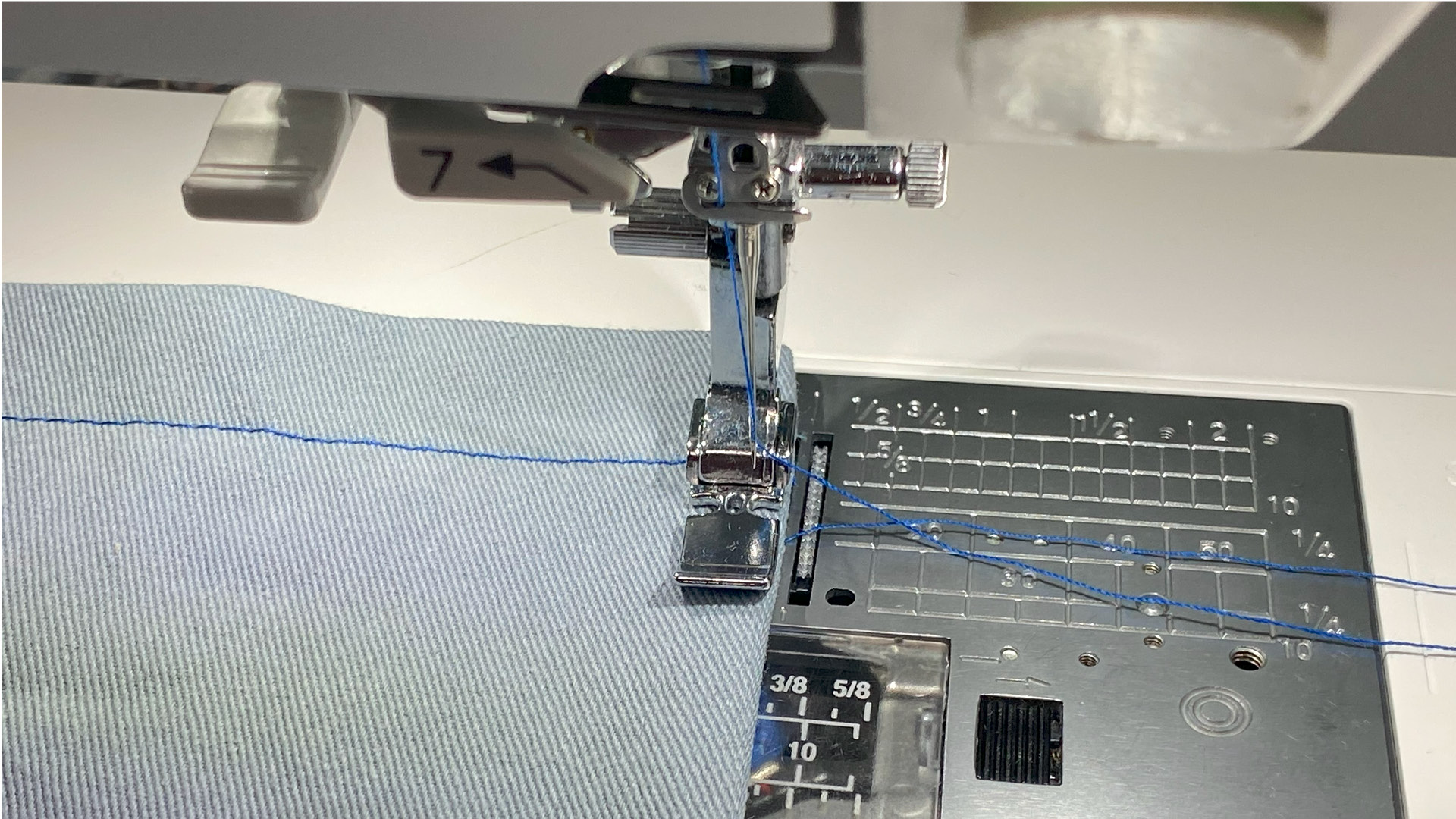
First I topstitch the hem. The distance to the edge is again 25 – 28 mm and should be chosen so that you can catch all the layers well. The lining may need to be pushed to the side so that it is not inadvertently sewn in place.
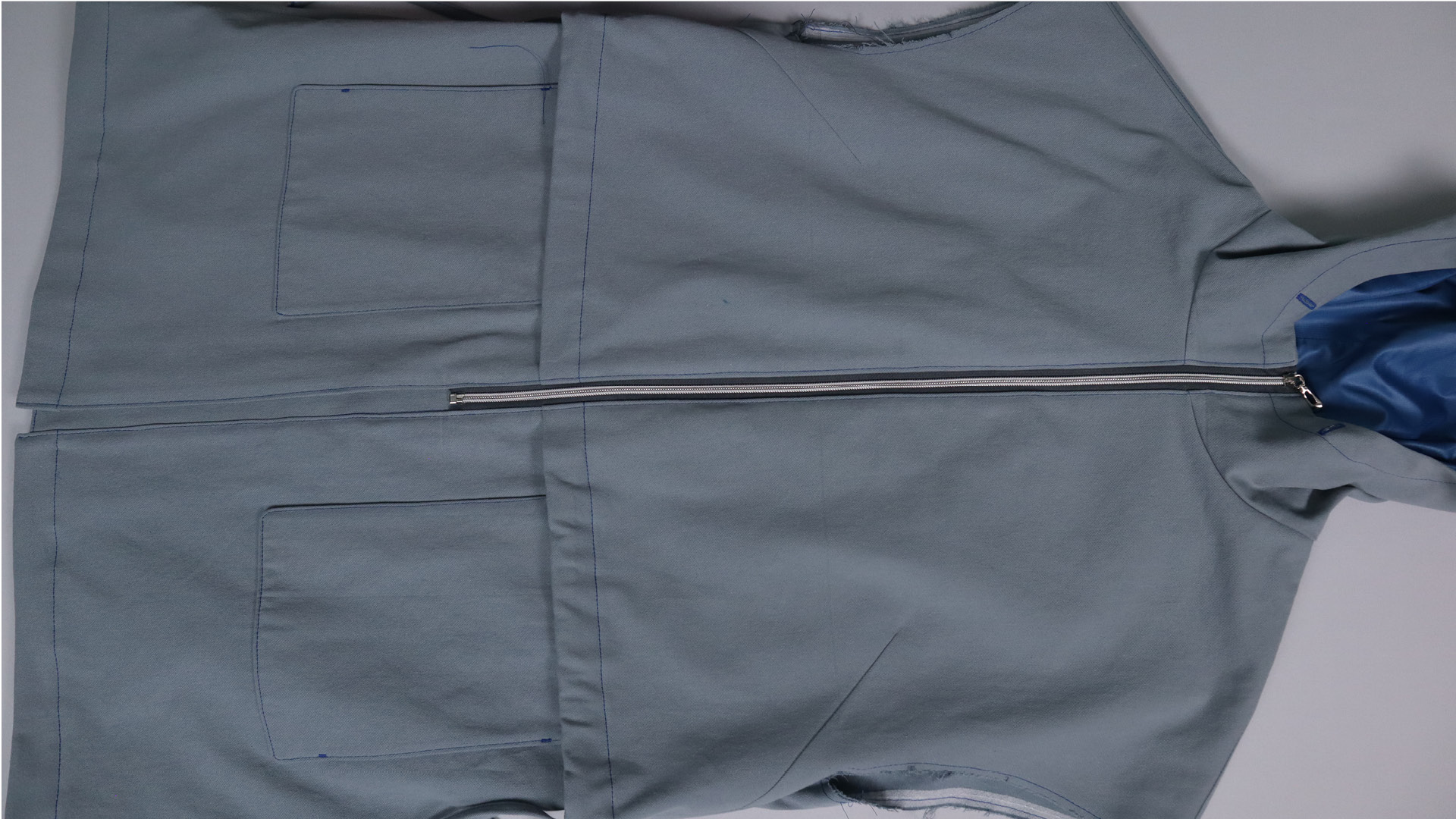 The hem and front edges are stitched.
The hem and front edges are stitched.
I topstitch the front edges just next to the zipper. I opted for a distance of approx. 2 mm here. You can also topstitch a little wider if you prefer. But it shouldn’t be more than 7 mm, otherwise you won’t catch all the seam allowances.
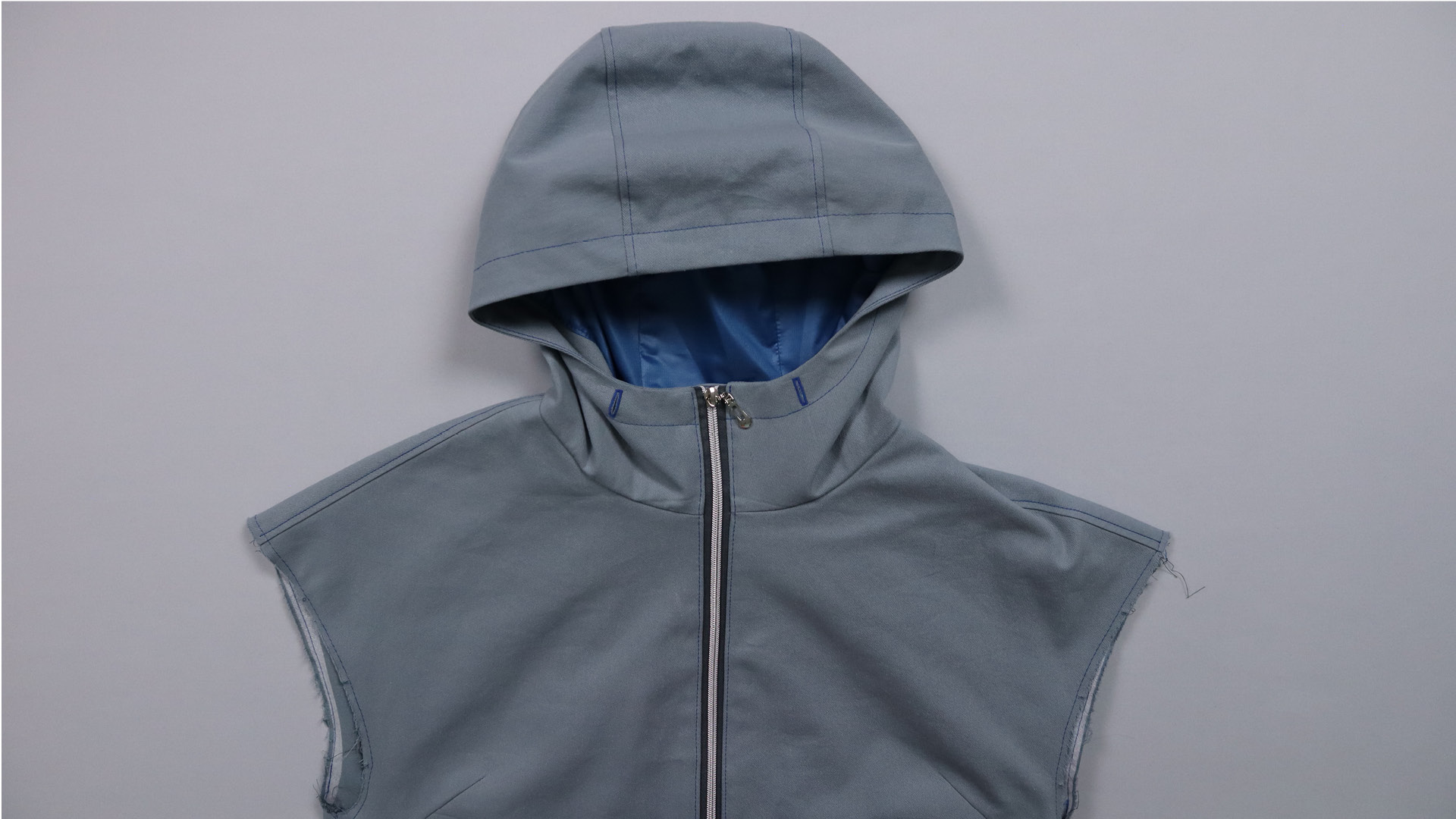
The hood tunnel, through which the cord or ribbon will later be pulled, is topstitched 25 mm from the front edge.
Sewing the overlap of the parka with hood
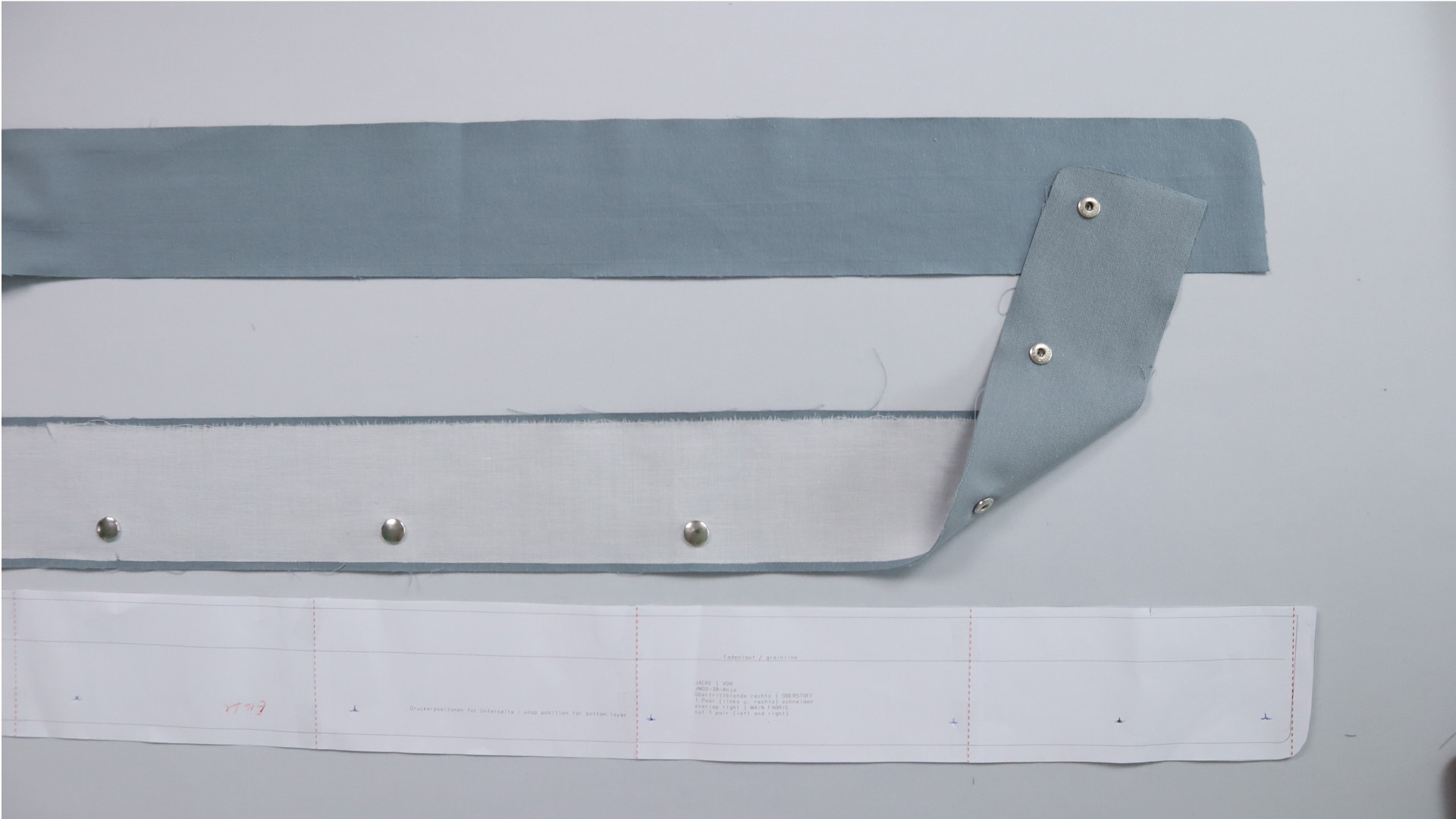 The tops of the snaps are attached to the overlap.
The tops of the snaps are attached to the overlap.
The bottom or inner side of the overlap should be fixed, as this is where the snaps will be worked in. The choice of interfacing depends on your fabric and how much stability you want the finished overlap to have.
I marked the position of the snaps using the pattern piece and inserted them before sewing the two parts of the overlap together. The heads will later be on the inside of the overlap and will no longer be visible.
You can also sew both parts together first, topstitch from the outside and then insert the snaps. This makes it easier to topstitch the overlap and you have the option of shortening or lengthening the overlap if it does not fit the front piece exactly.
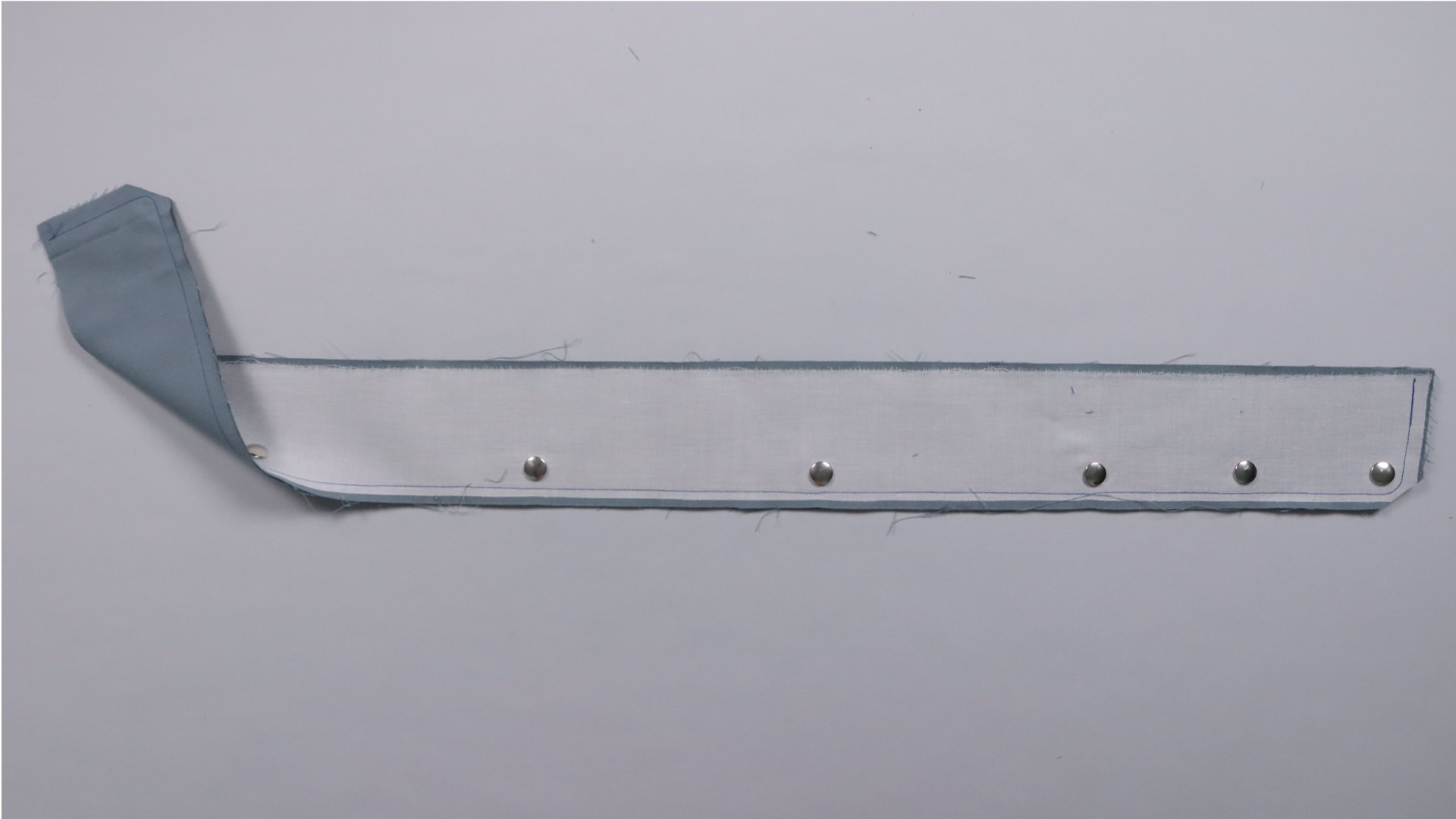
The two parts of the overlap are placed right sides together and sewn together at the short sides, the curves and the front edge. Cut back the seam allowances in the curves.
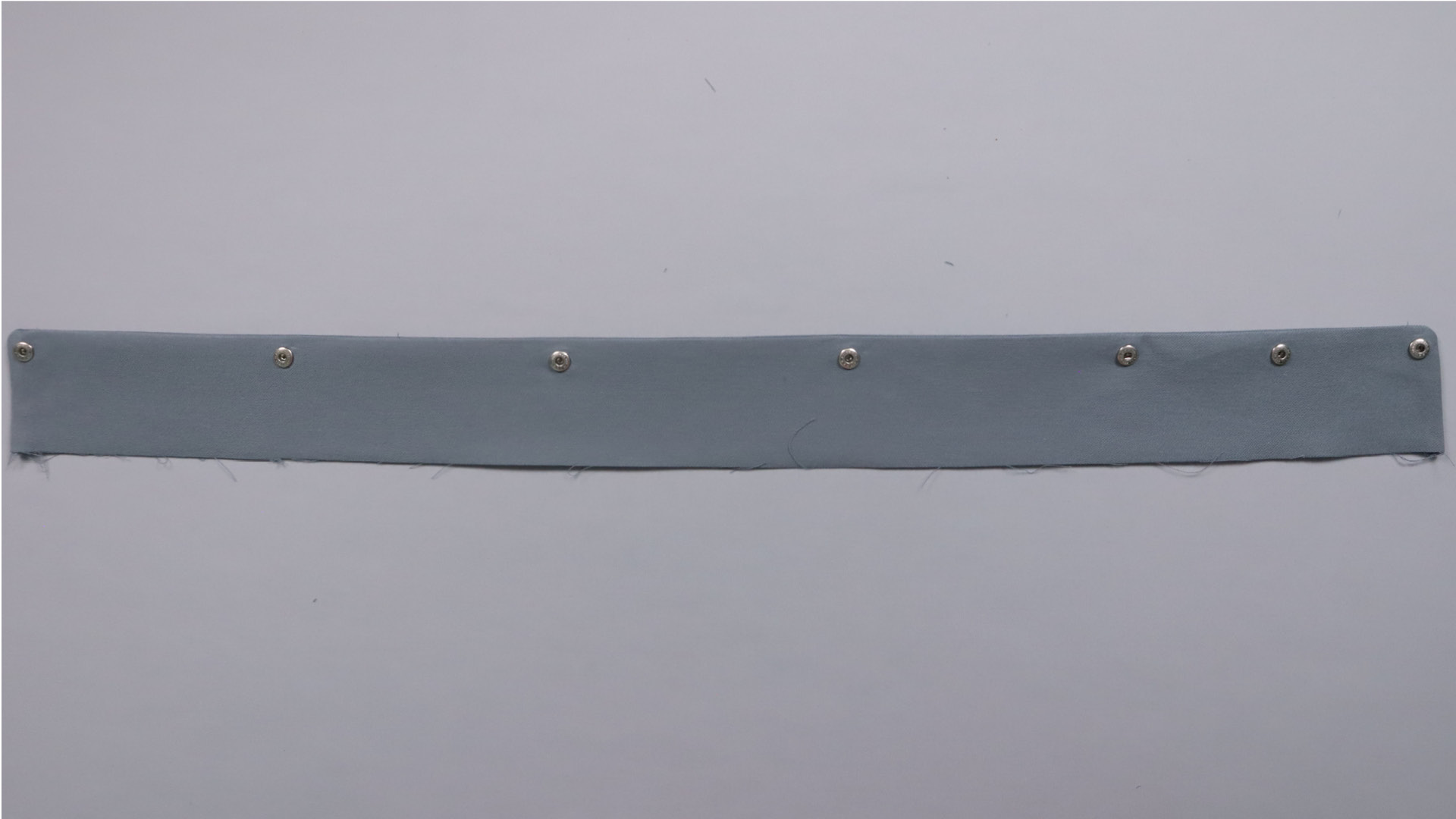
The overlap is then turned over and the seam ironed.
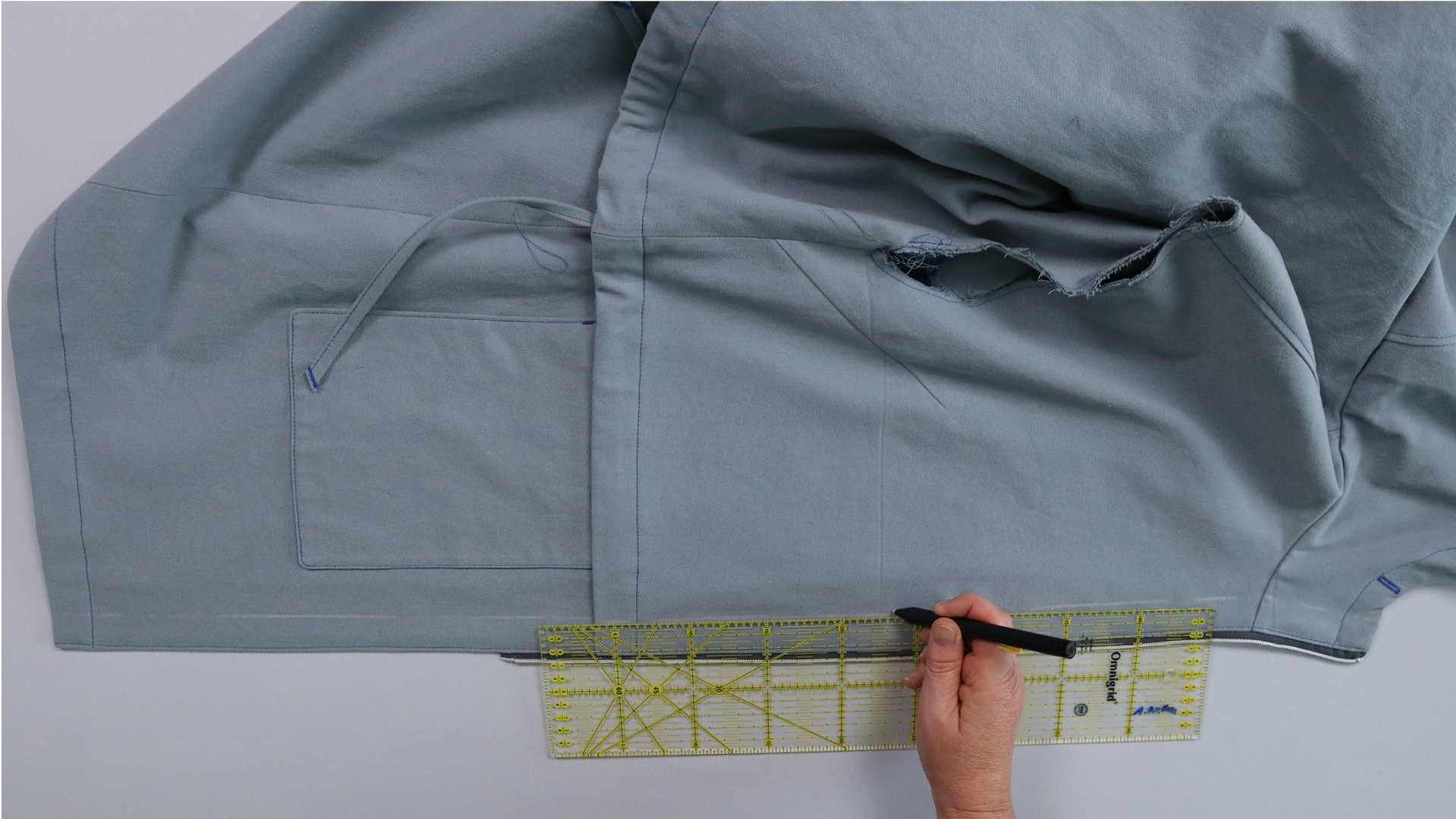
The overlap is sewn on at a distance of 3 cm from the center front. I draw the line of contact at a distance of 24 mm from the front edge.
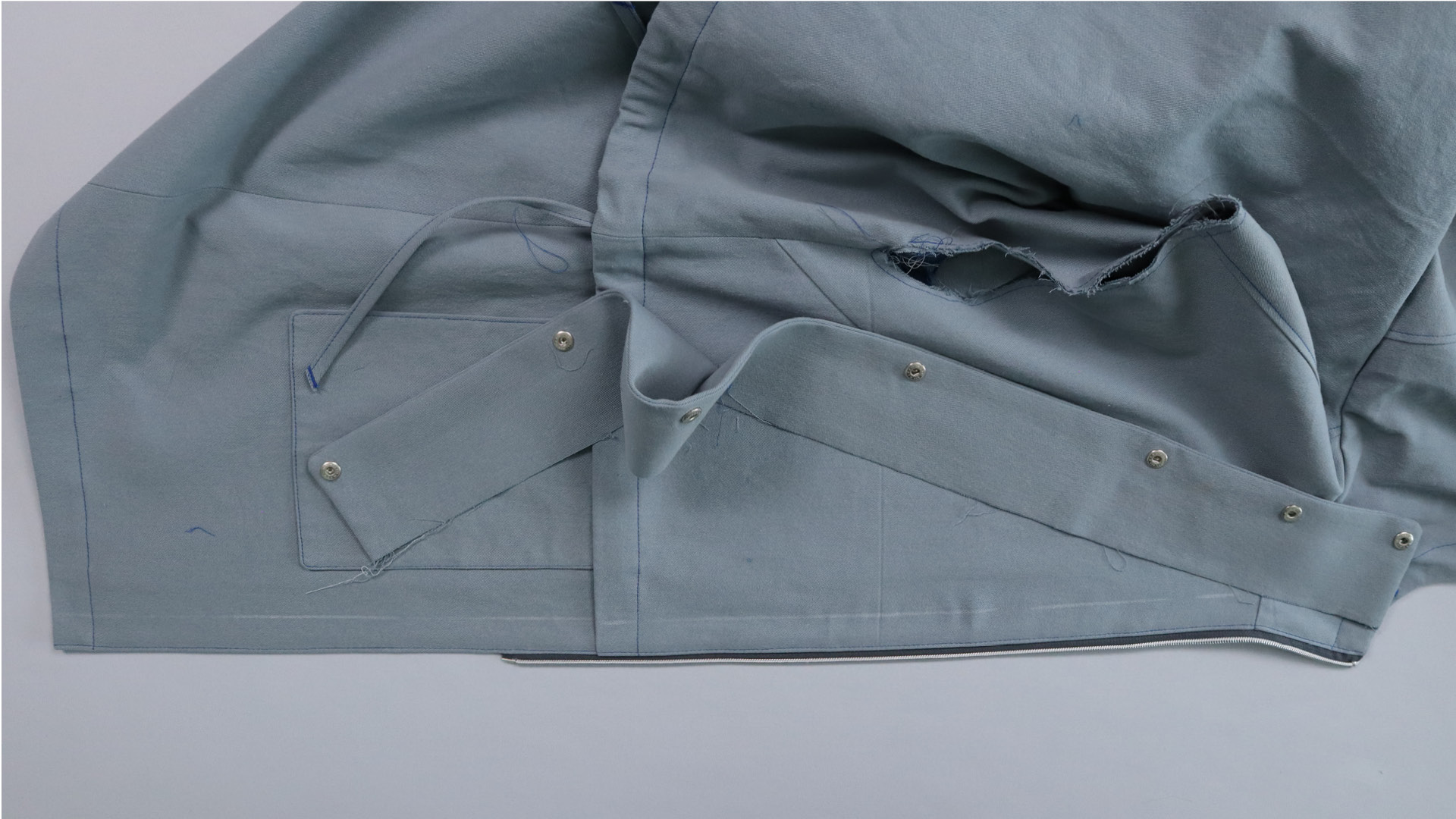
Then I place the overlap on this line, starting at the hood.

So I check again whether it is the right length.

Then I topstitch the overlap from the outside close to the edge. As the snaps are already turned in, I can no longer rest my foot on the fabric. I therefore place a scrap piece under the foot to compensate for the height.
If, as described at the beginning of this section, you haven’t yet fastened the snaps, you need to do this now. Mark the positions using the pattern piece and attach the snaps to the underside according to the manufacturer’s instructions.
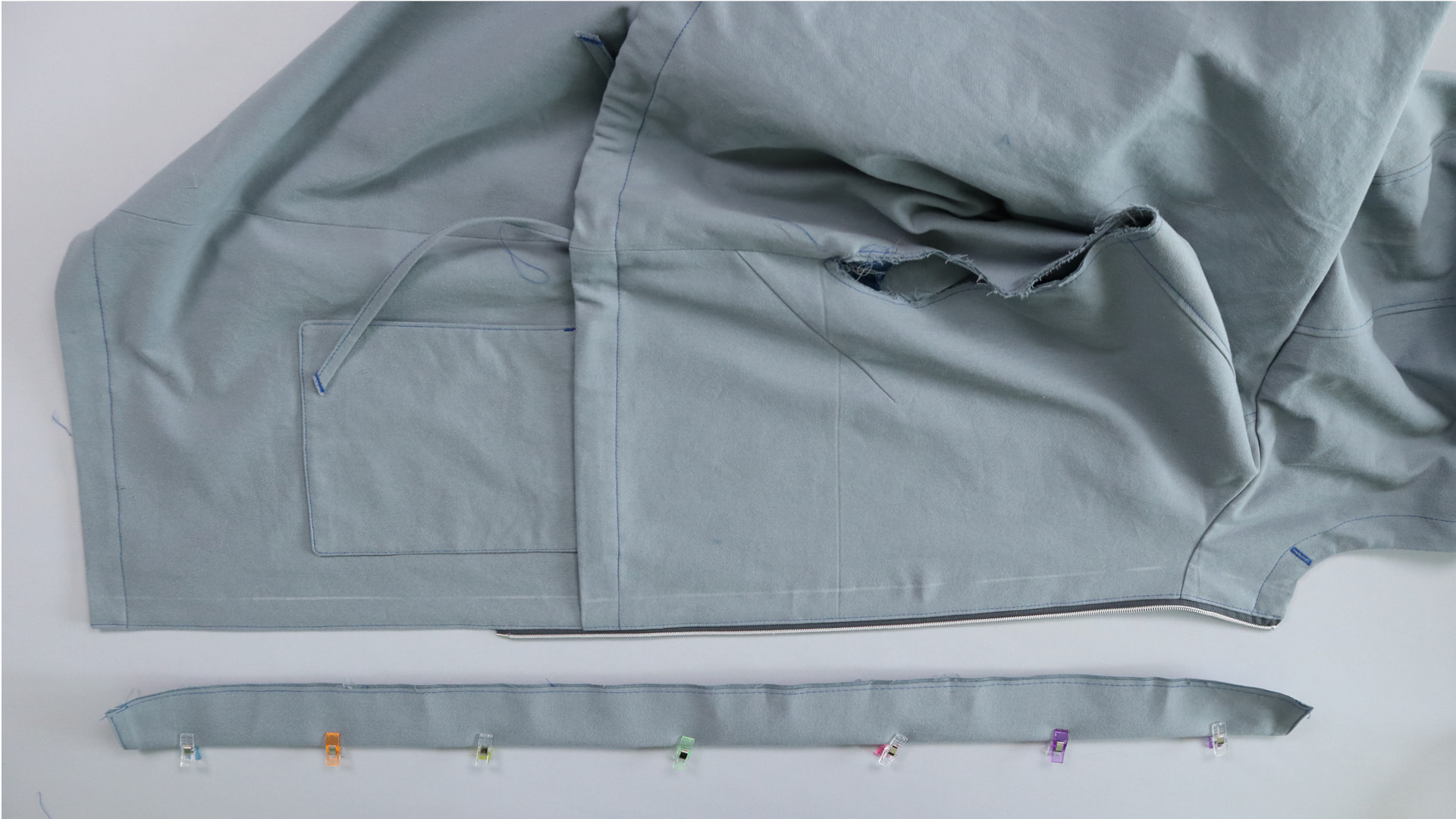
You can secure the back edge within the seam allowance with an auxiliary seam so that nothing slips when sewing on.
 The seam allowances are straightened if necessary.
The seam allowances are straightened if necessary.
Now check again that the facing, including the seam allowance, is 8.2 cm wide and cut it accordingly if necessary.

The overlap is placed right sides together on the marked line and sewn in place with a 6 mm seam allowance.
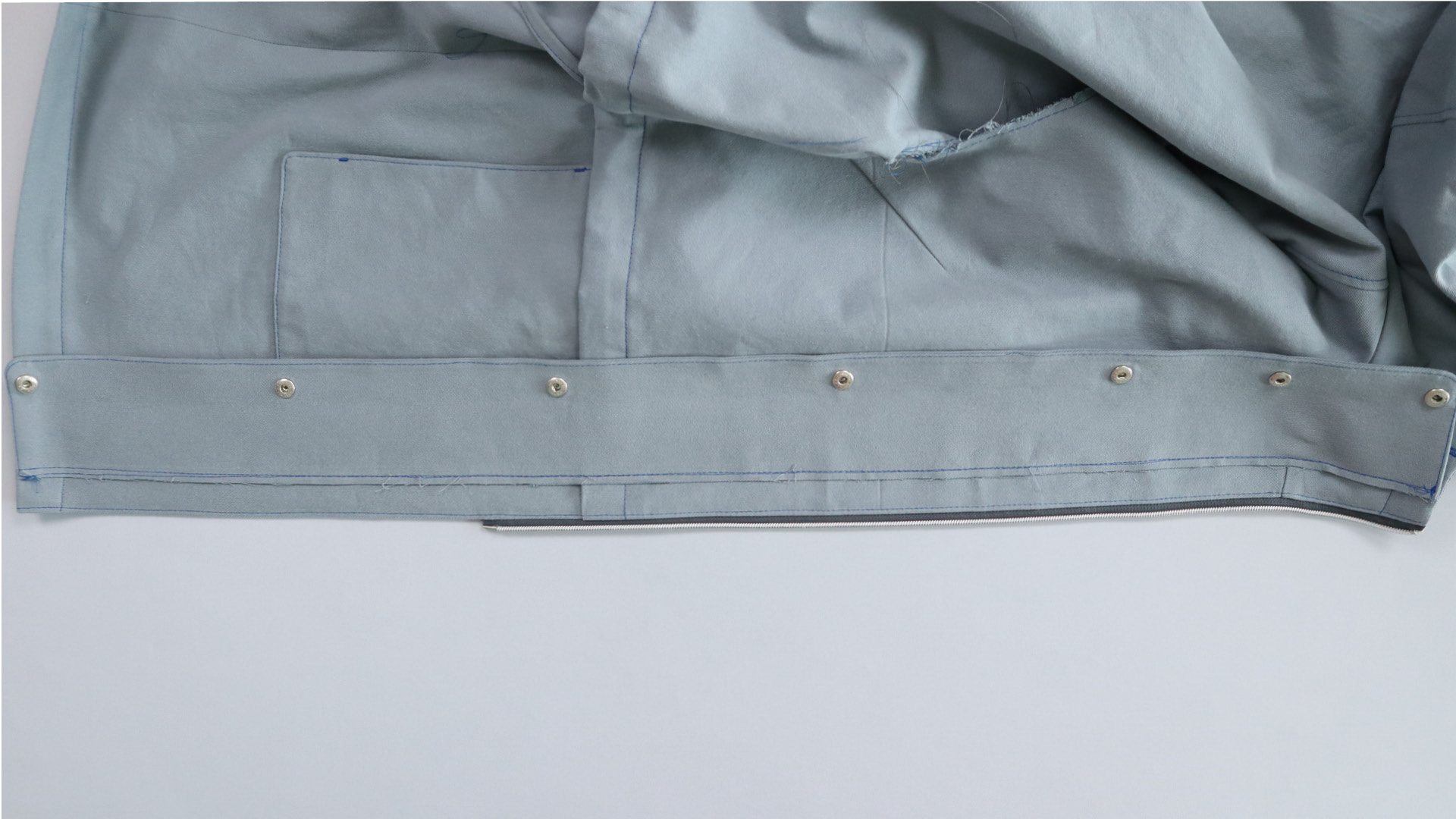
This is what it looks like when the overlap is sewn onto the right front piece.

I fold the overlap to the left side and check whether the position of the bottom parts of the snaps is far enough next to the zipper that I can insert them easily. The distance to the edge of the fabric should be approx. 1.5 cm.
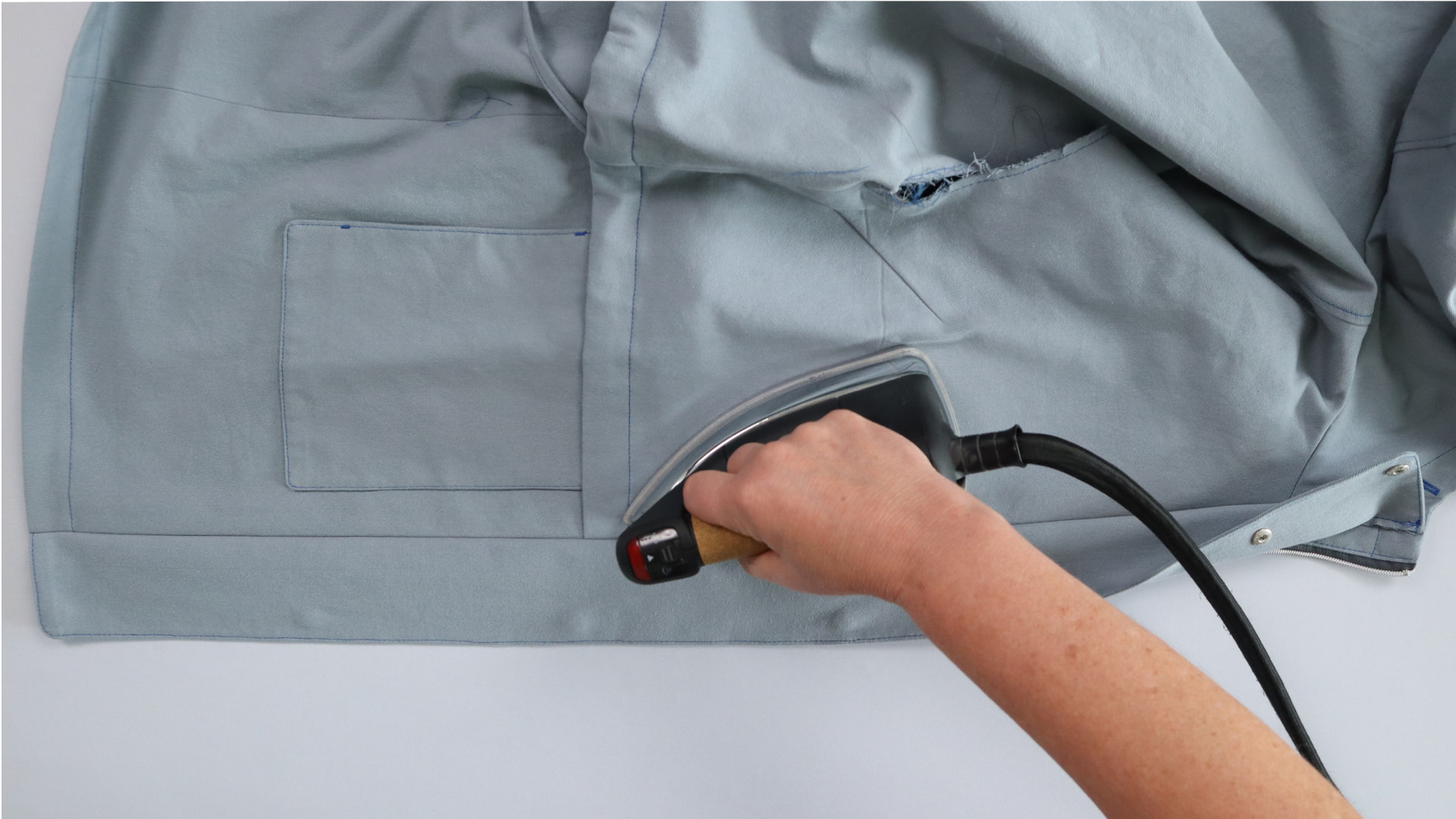
If everything fits, I iron the overlap at the seam.

Then I topstitch the seam with an 8 mm gap so that the seam allowances are not visible from the inside.
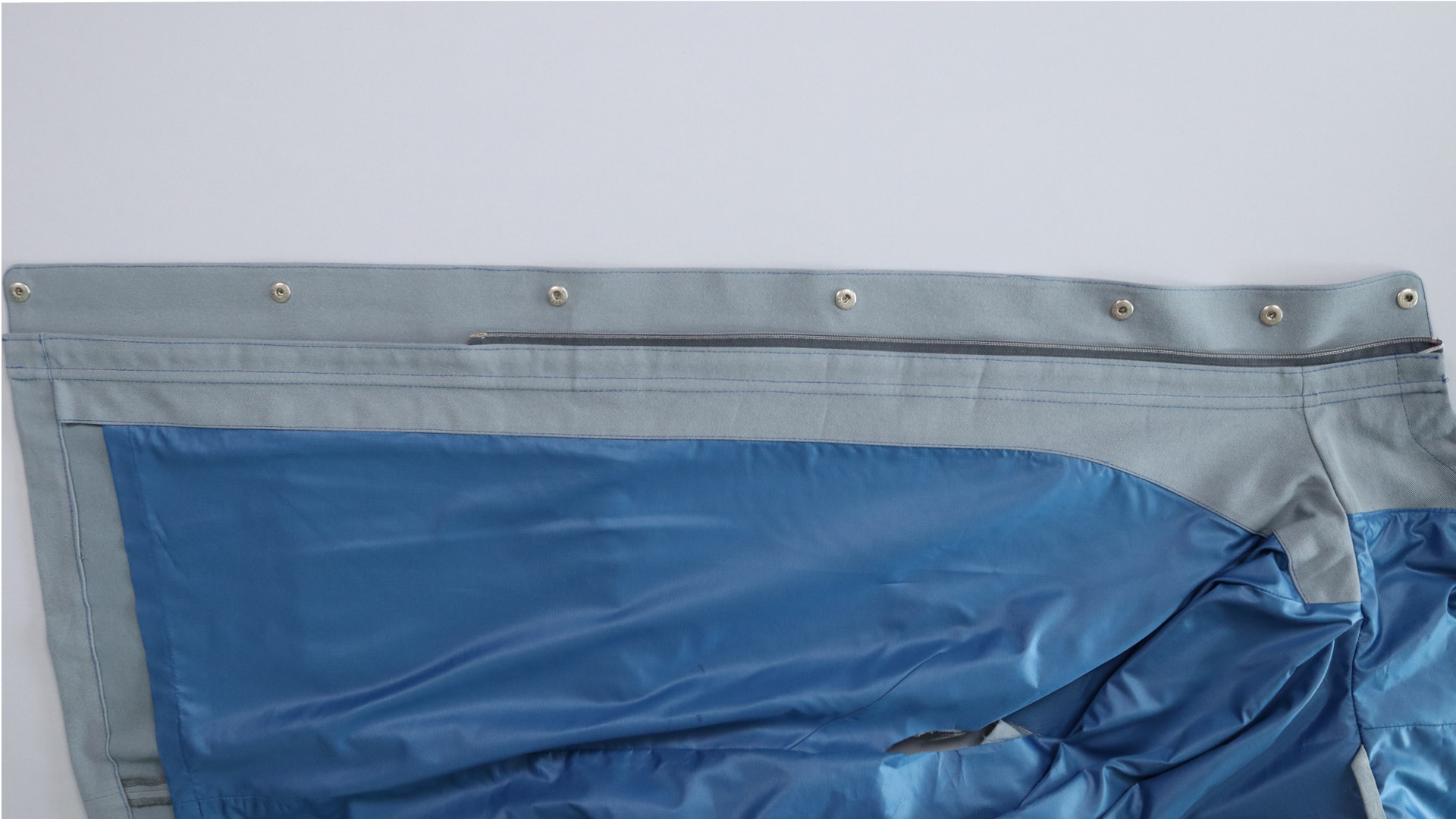
This is what the finished overlap looks like from the inside.
Attaching snap bottoms
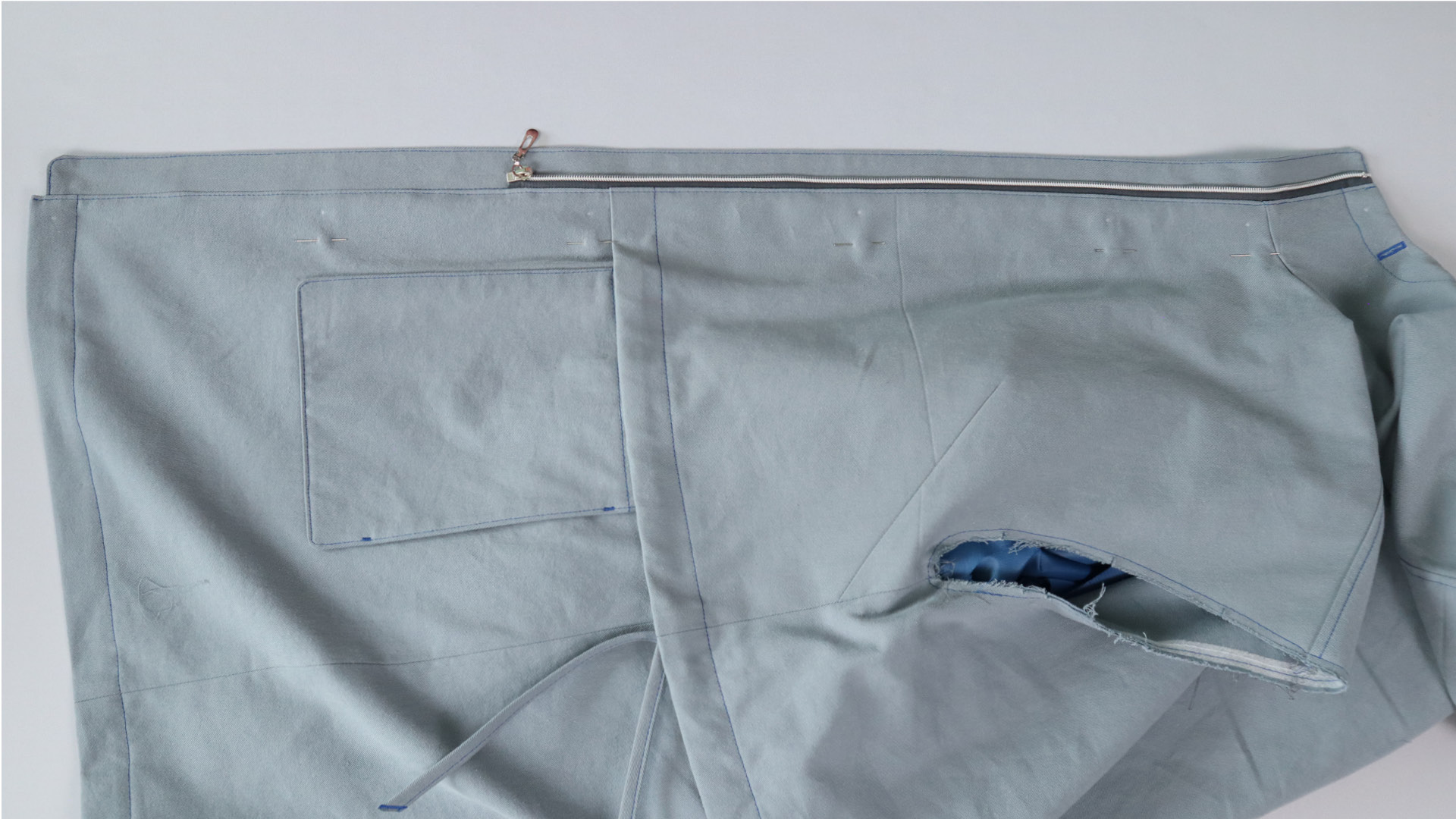
First, I pin the outer parka and facing in a few places so that nothing slips when attaching the snaps.

Then I close the zipper, fold up the overlap and mark where the snap bottoms need to be attached.

For example, you can stick a pin into the fabric at right angles to the front edge, push it so that the head is in the opening of the snap and mark this position.

The lower parts of the snaps are then also attached according to the manufacturer’s instructions.

This is what the left front section looks like with snap bottoms.
Sew sleeves and insert into the parka with hood
You can now put the body aside.
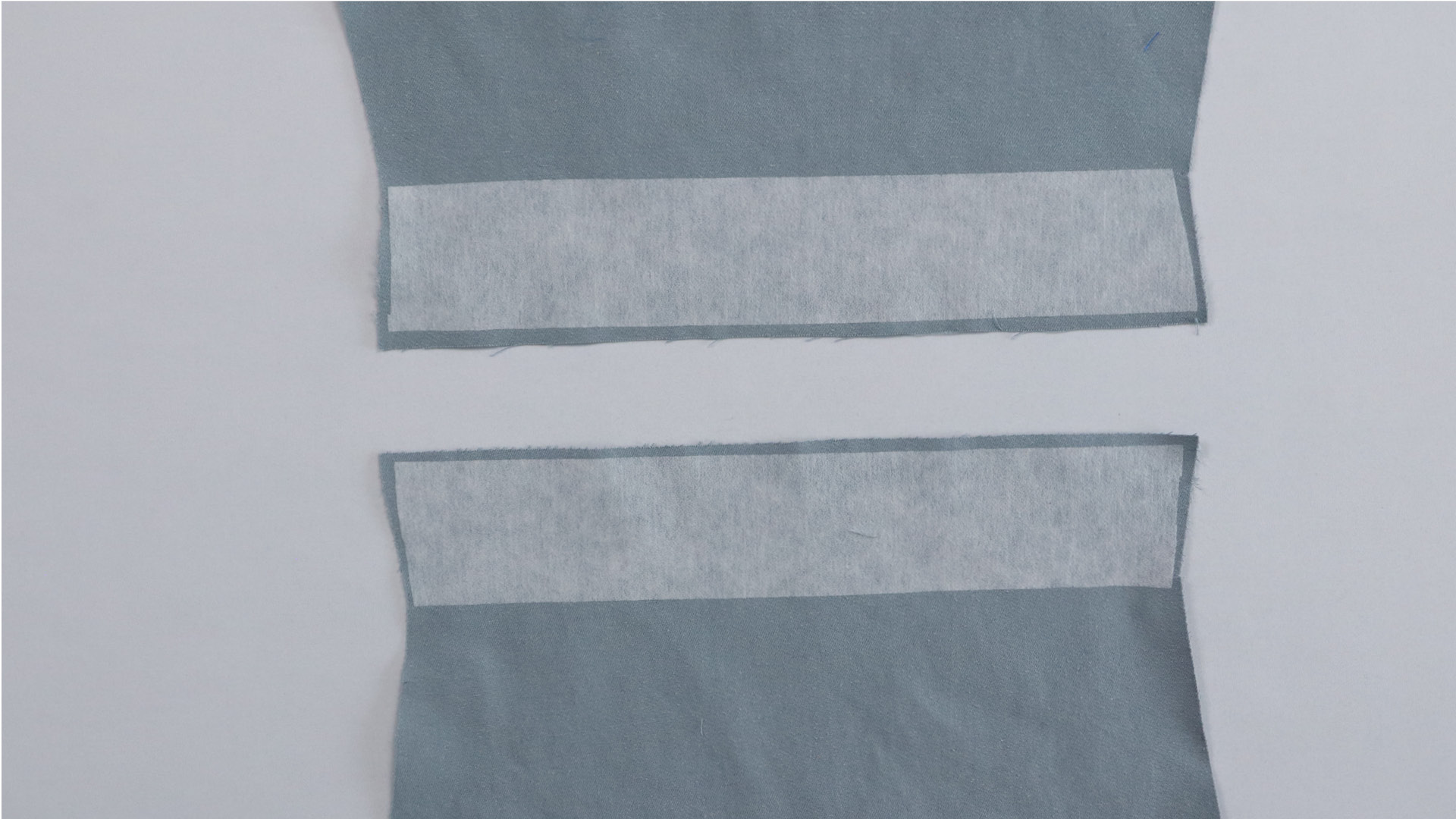
If not already done, iron the interfacing onto the sleeve hems.
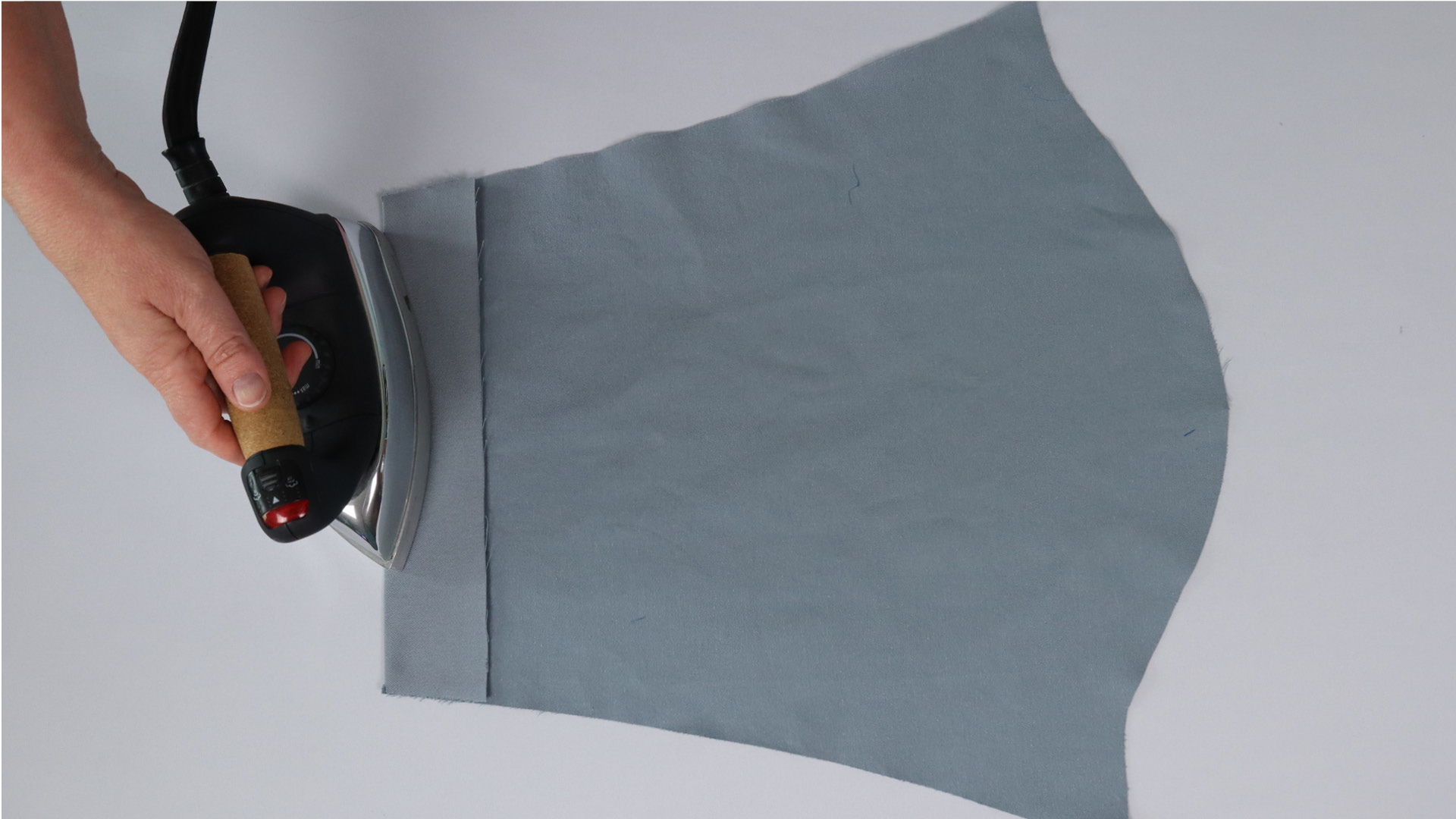
The sleeve hems are then ironed inside out at the notches, wrong sides facing.
Sew tabs

You have a total of four parts for the tabs, two of which are identical. Fasten the outer sides of the tabs, i.e. two identical parts, and mark which side is the fastened side from the outside if necessary.
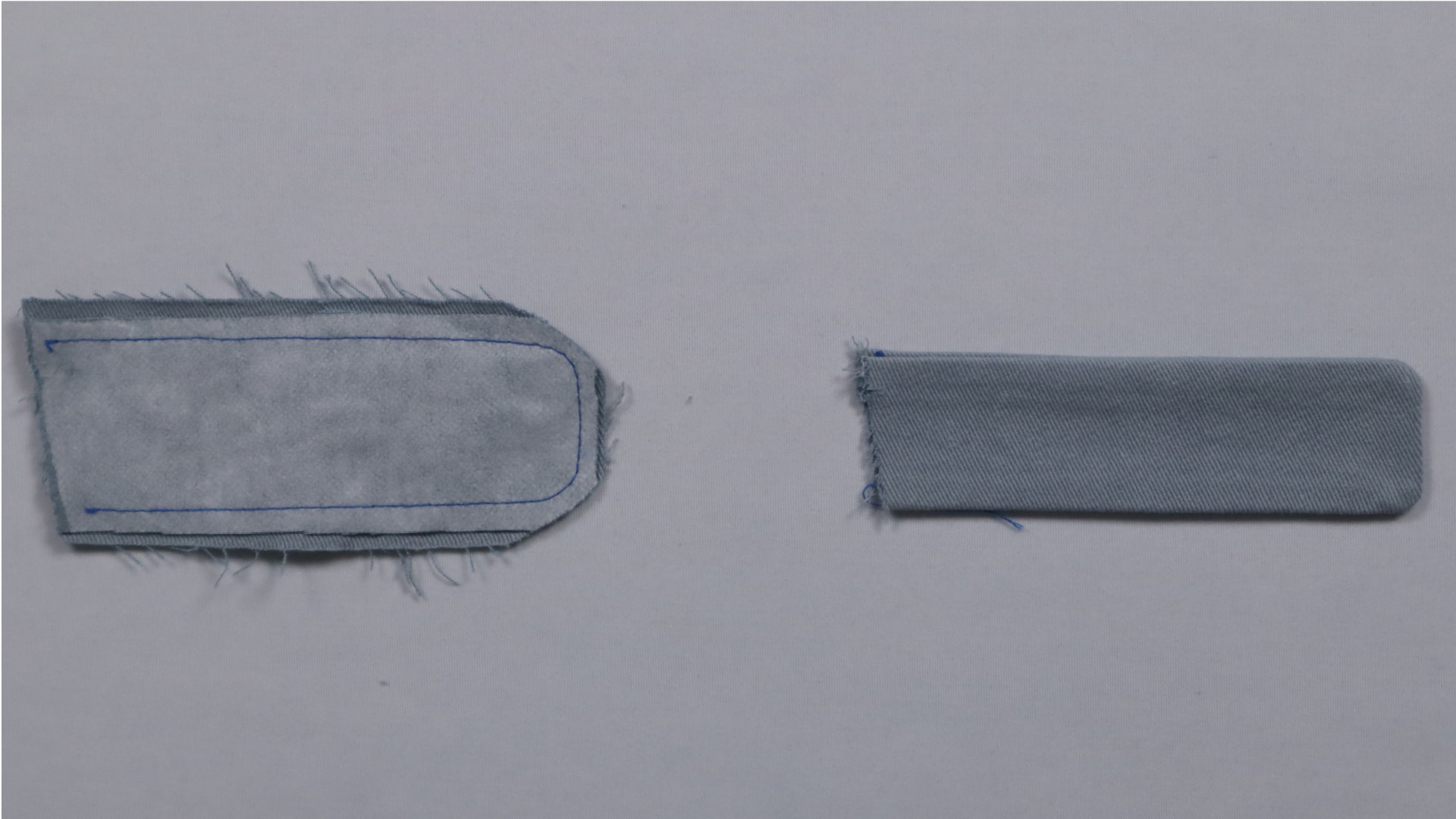 Before turning, the seam allowances of the sleeve tabs are cut back.
Before turning, the seam allowances of the sleeve tabs are cut back.
Now place two pieces – one with and one without interlining – right sides together and sew the two long sides and the rounding together. The slanted short side, which will later lie in the seam, remains open.
First press the seam allowances open and cut them back at the curve before turning the tab over and pressing again. The previously sewn edges are now topstitched close to the edge. Make sure that the side of the fabric with the interfacing is on top.
The buttonhole is then worked in. You can use the template to help you find the correct position. The length of the buttonhole depends on the diameter of your buttons.
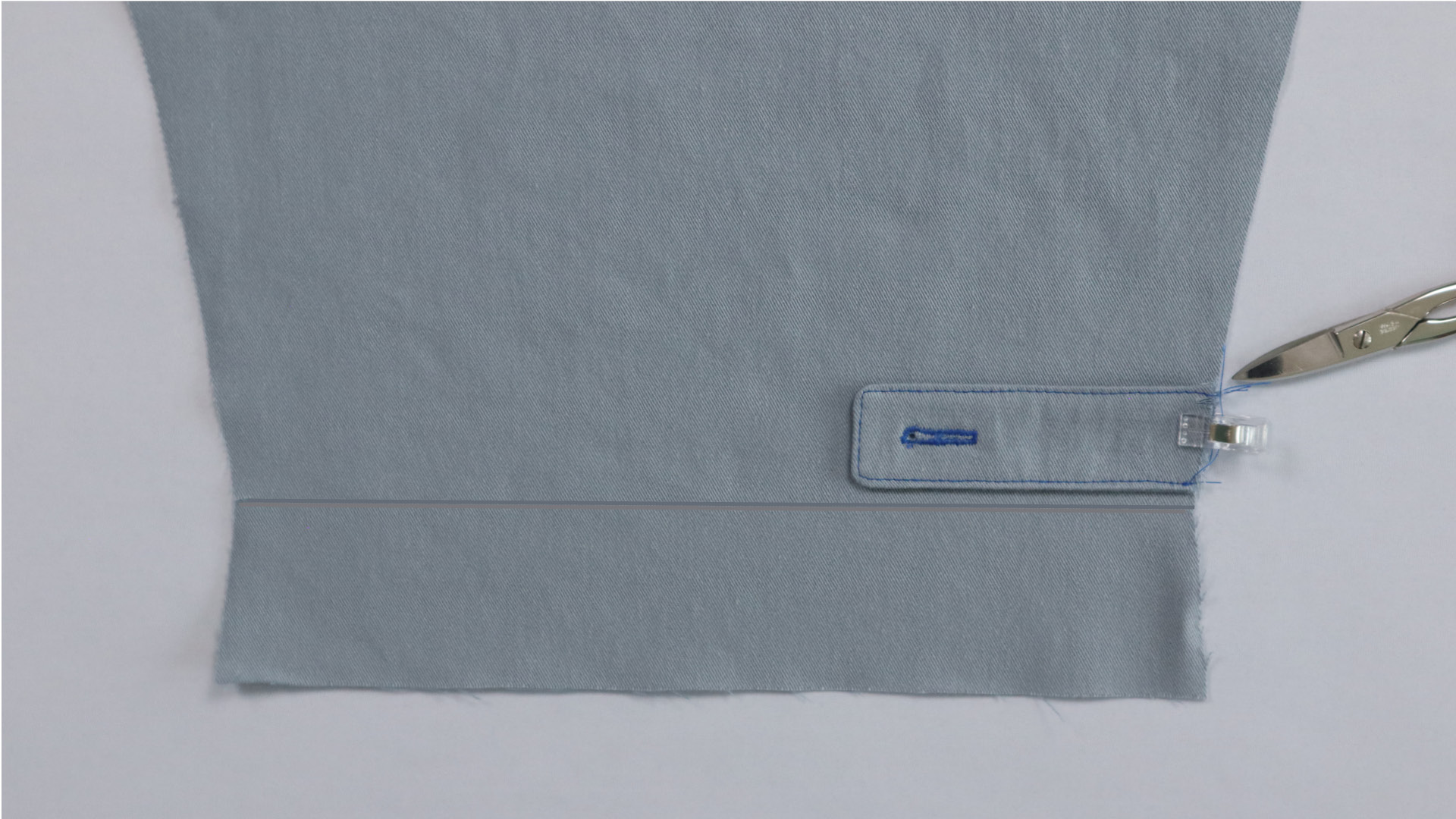
The tabs are now placed between the snaps on the back sleeve seam and sewn in place within the seam allowance with an auxiliary seam. Make sure that they are parallel to the hem edge.
Tip: If you place the tab on the sleeve so that the pretty side of the buttonhole is visible, it will go from the back to the front of the finished parka. If you place the tab on the sleeve with the beautiful buttonhole side facing downwards, it will go from the front to the back of the finished parka, just as you know it from the cuffs on blouses. In this example, the beautiful buttonhole side is visible. On the finished parka, the tab then goes from the back to the front.
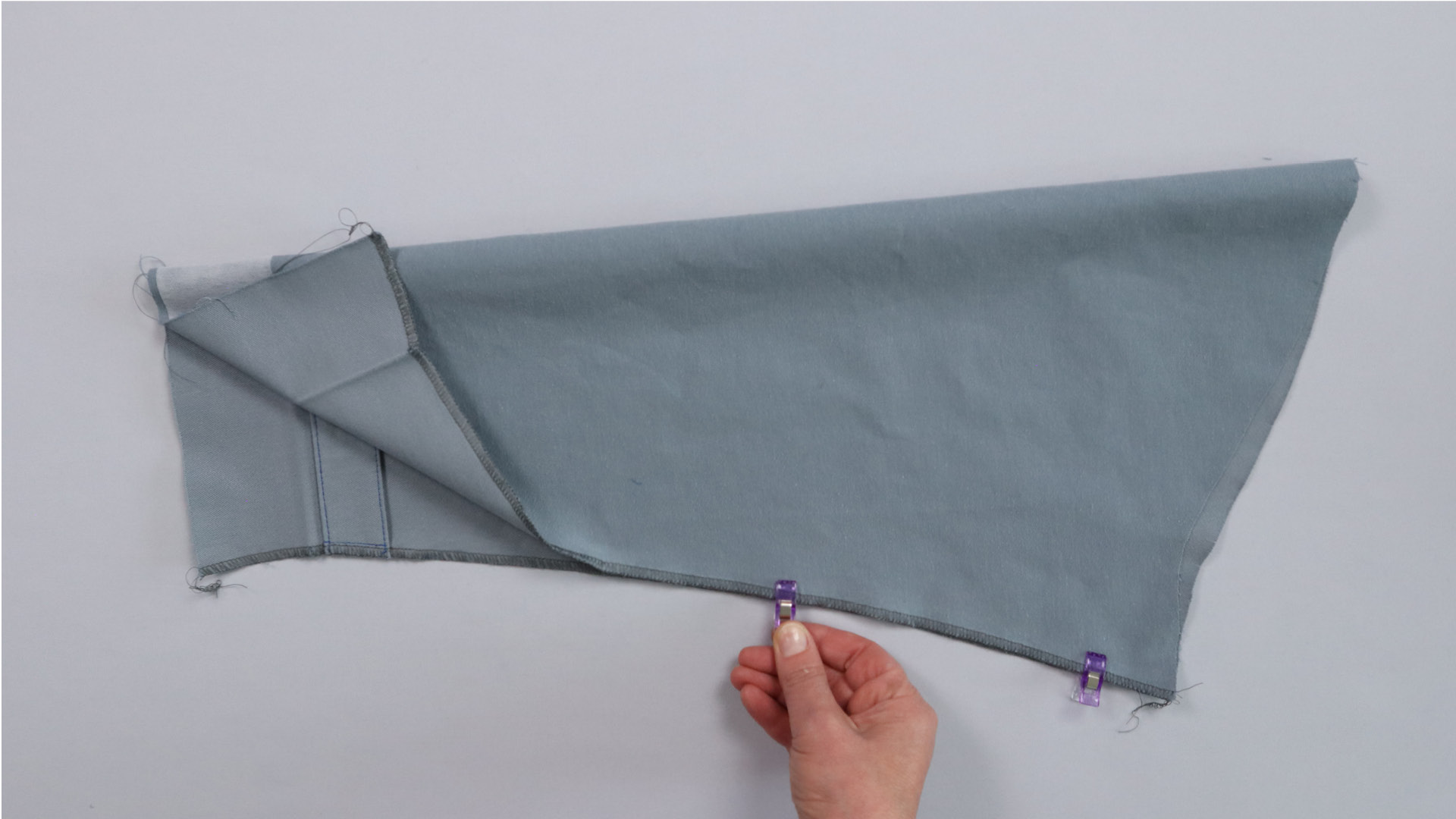
Fold the sleeves right sides together and pin the edges together flush.

Then I sew the sleeve seam.

I press the seam allowances open.
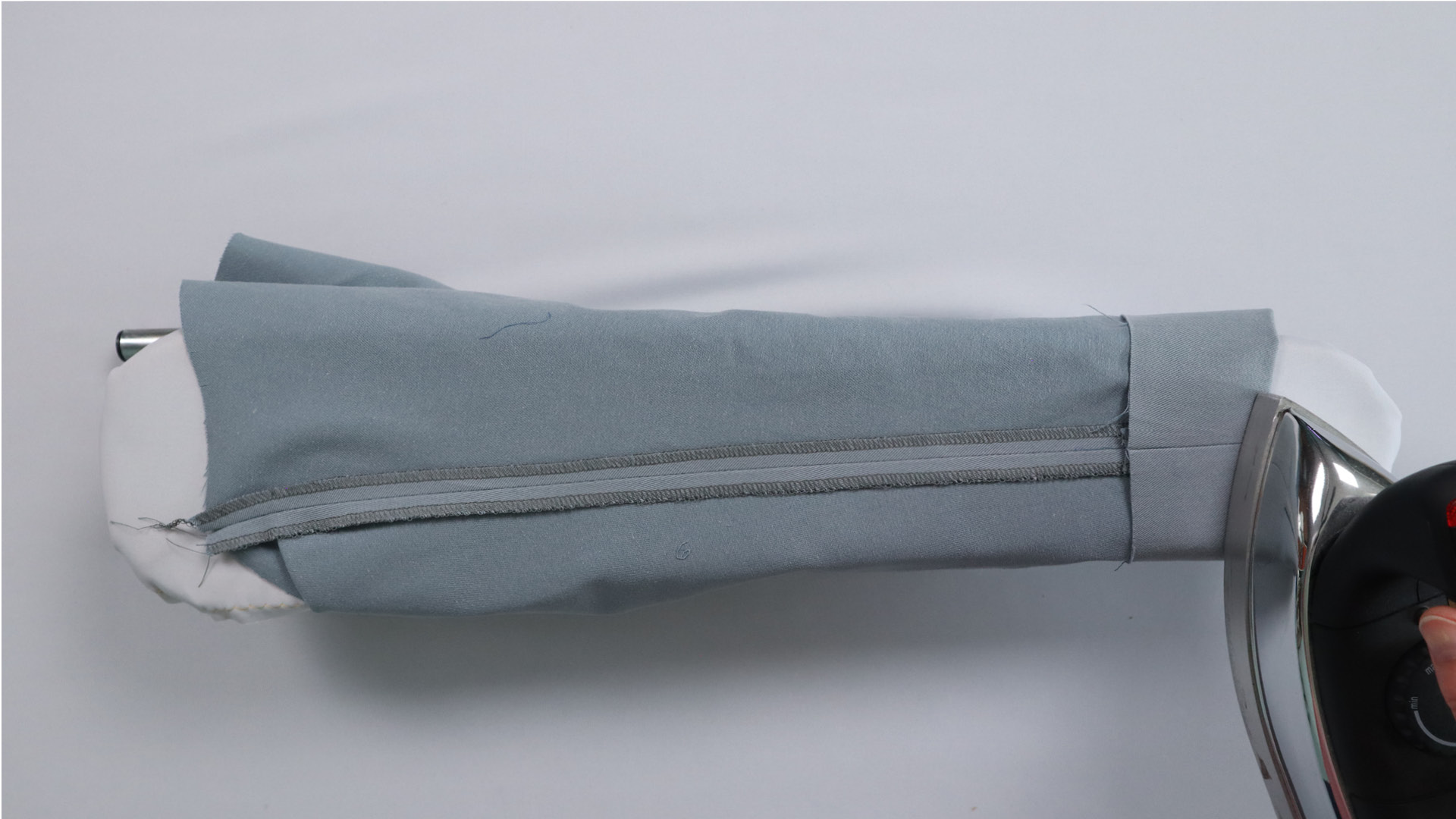
If the hem edge is no longer clear after ironing it apart, iron it again.
Sew lining sleeves and insert into the sleeve

The seam of the lining sleeves is also pinned and sewn.

Here I press the seam allowances to the back. You can tell where the back is by the two closely spaced notches in the armhole.
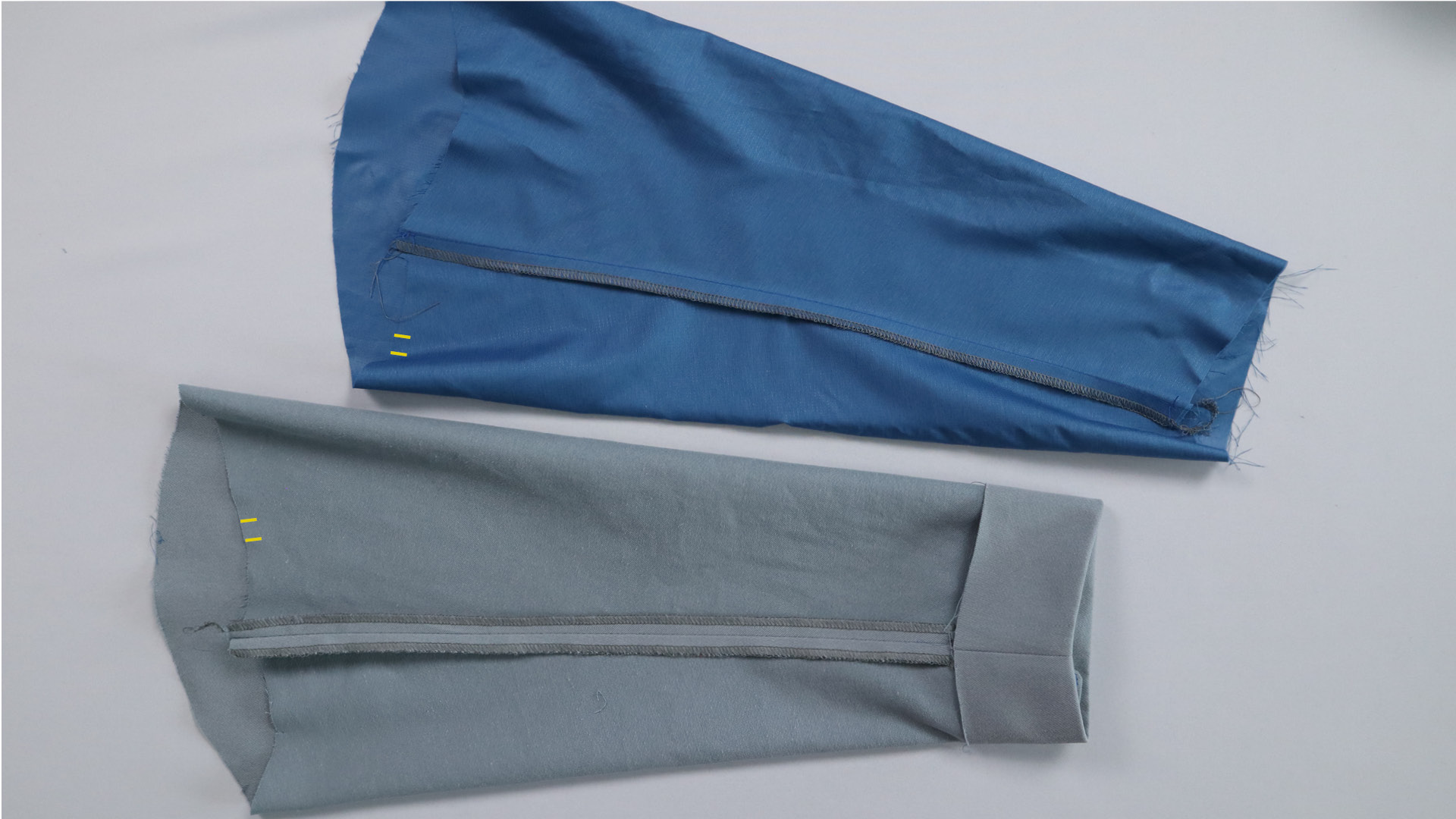
The outer and lining sleeves are now joined. Make sure that you put the right parts together. It is best to use the two notches that are close together as a guide, which must meet when the lining sleeve is inserted.
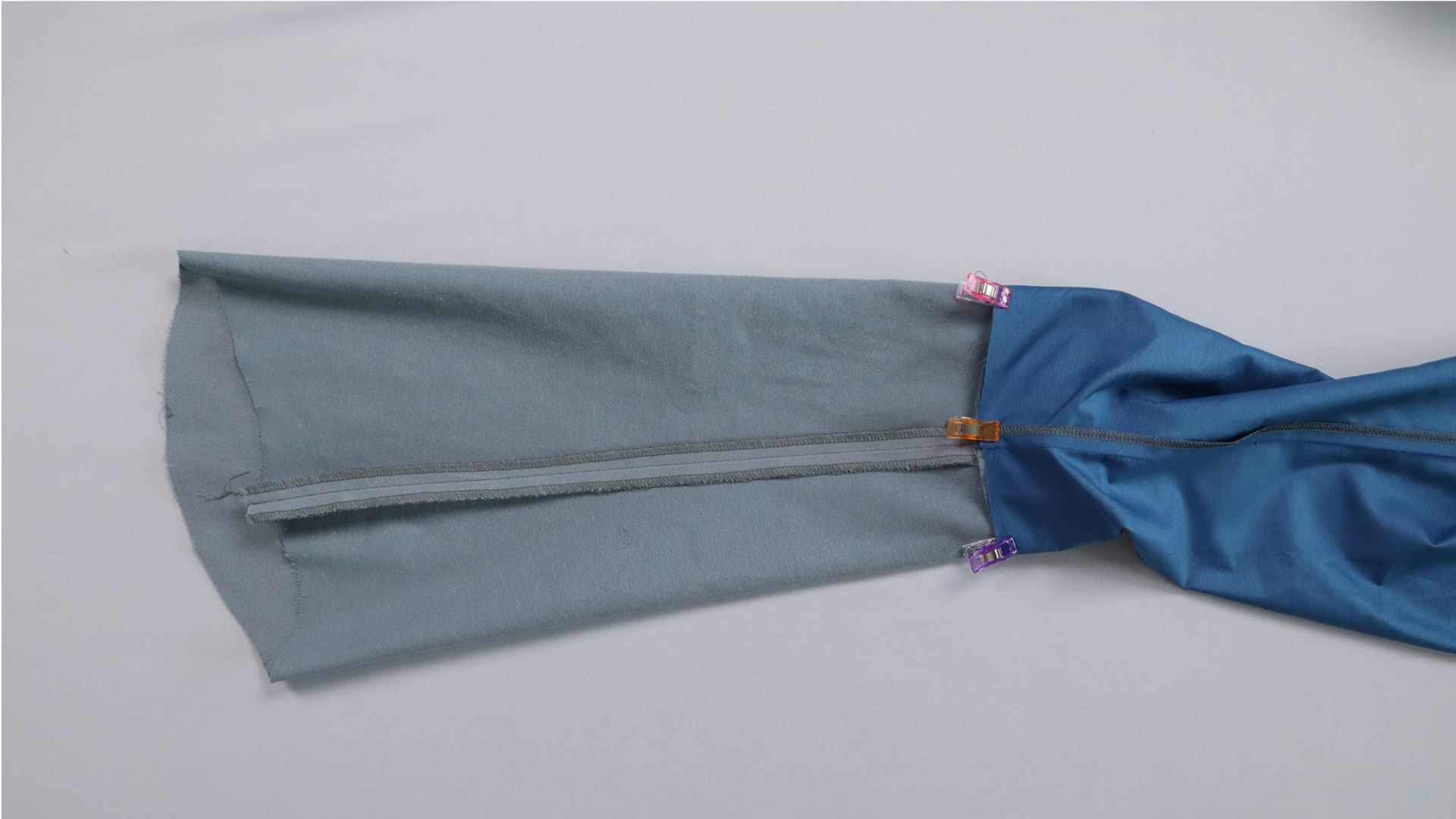
The lining sleeve is pinned to the outer sleeve right sides together at the hem and sewn on.
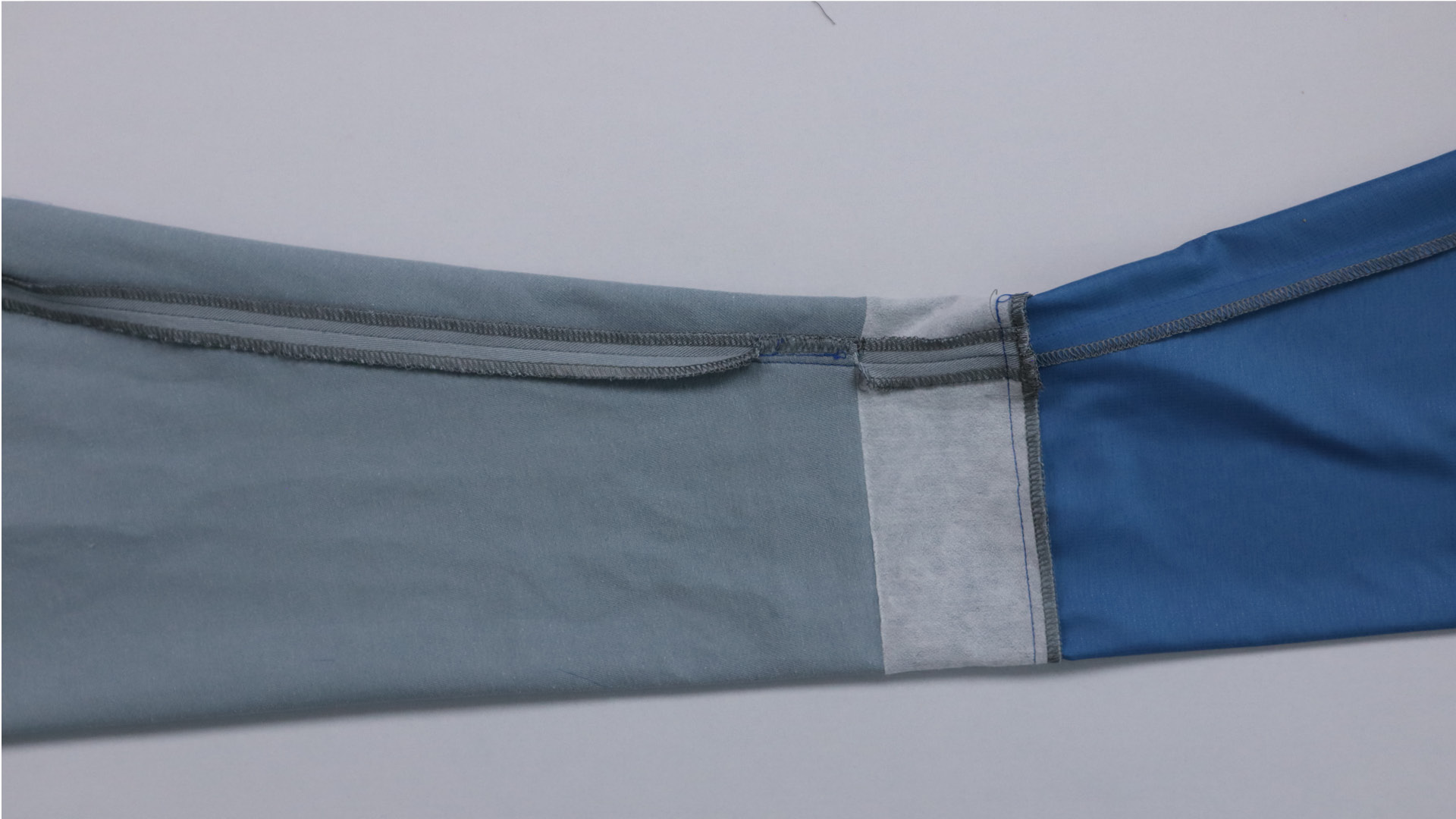
Here you can see the sewn-on lining sleeve.
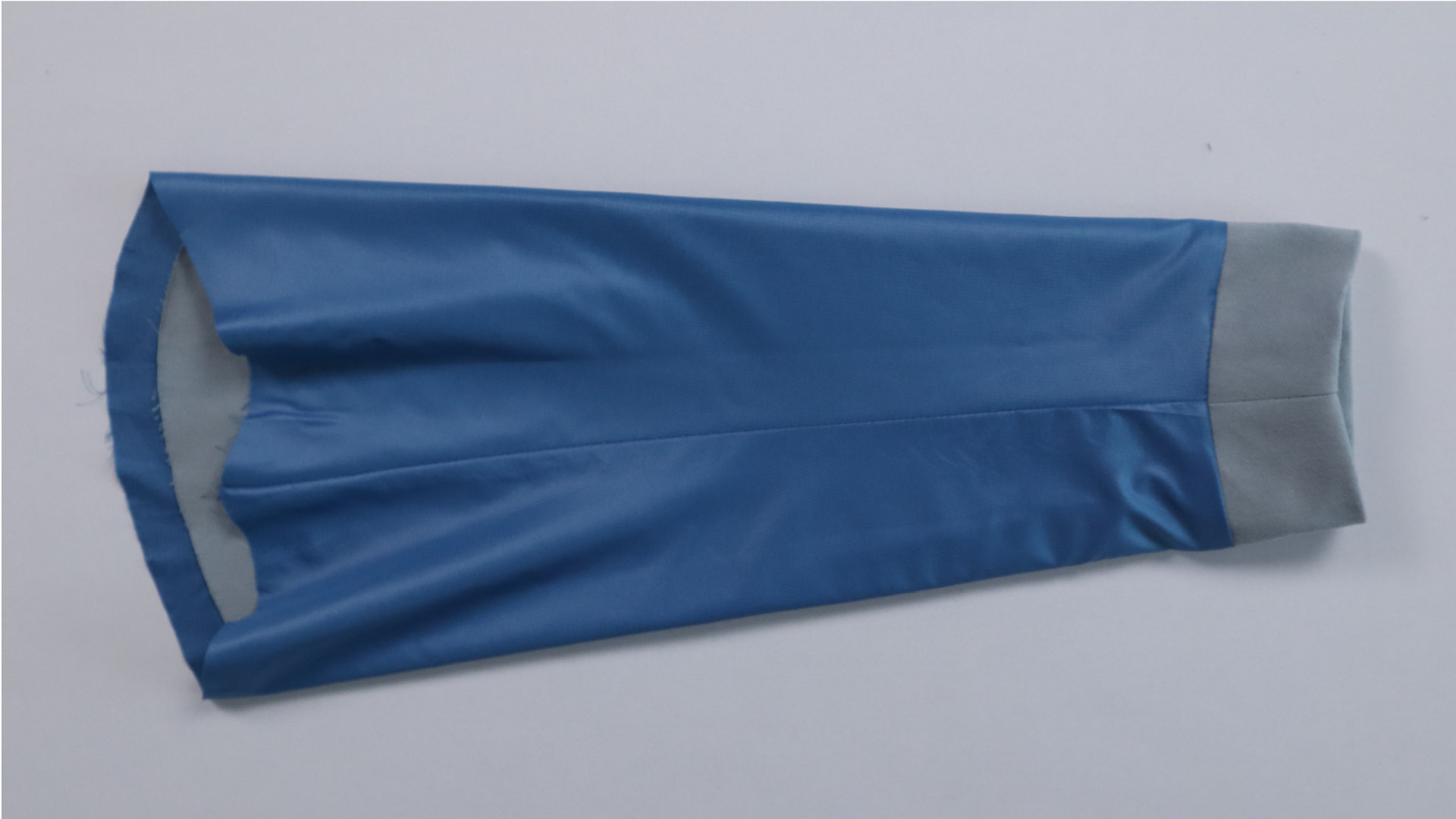
Now turn the sleeve hem inwards at the folded edge and pull the lining upwards. If necessary, pin it in place with a few pins so that you don’t accidentally catch it when stitching the hem.
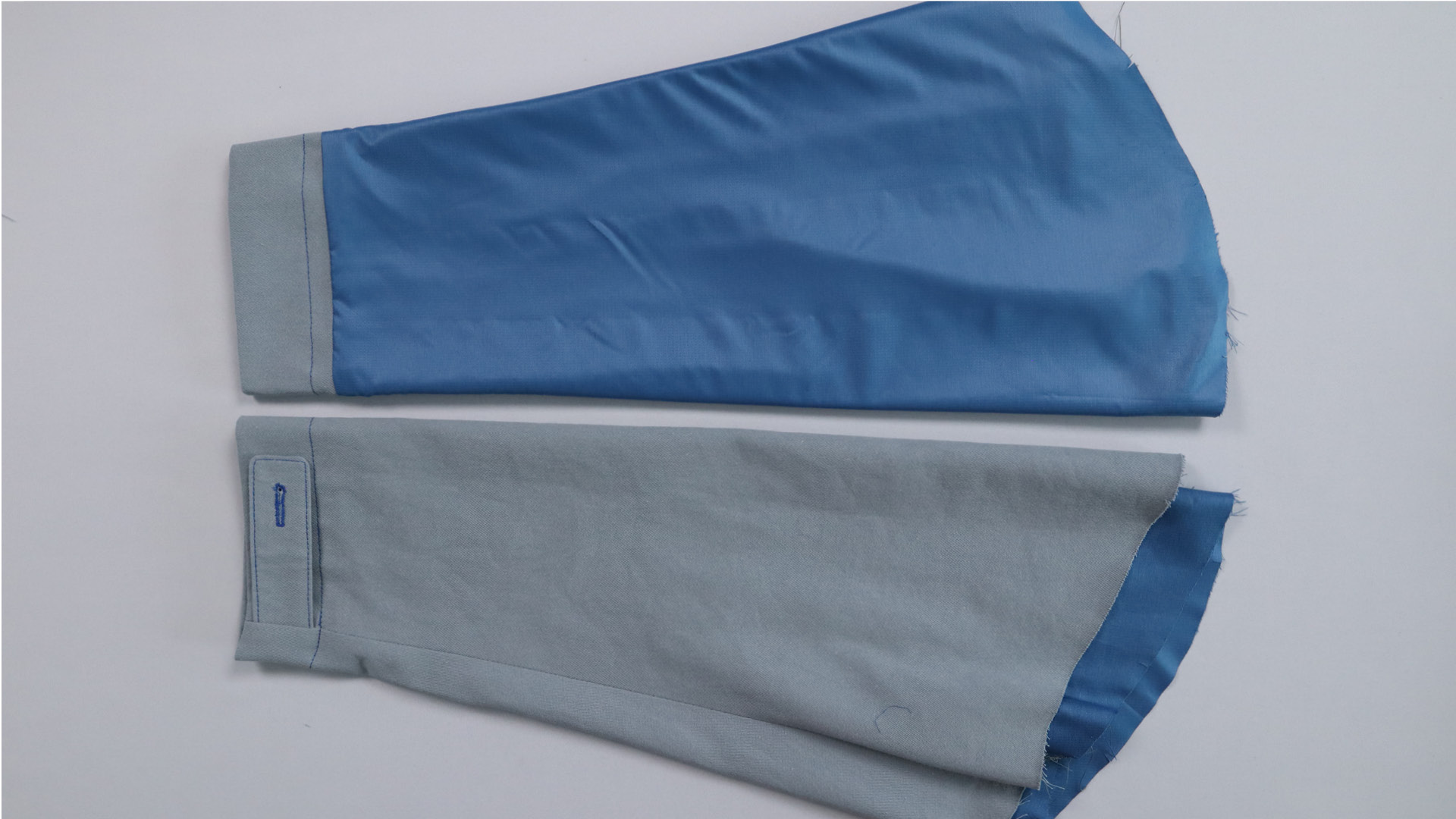
The hem is topstitched from the right side at a distance of 4 cm from the edge.
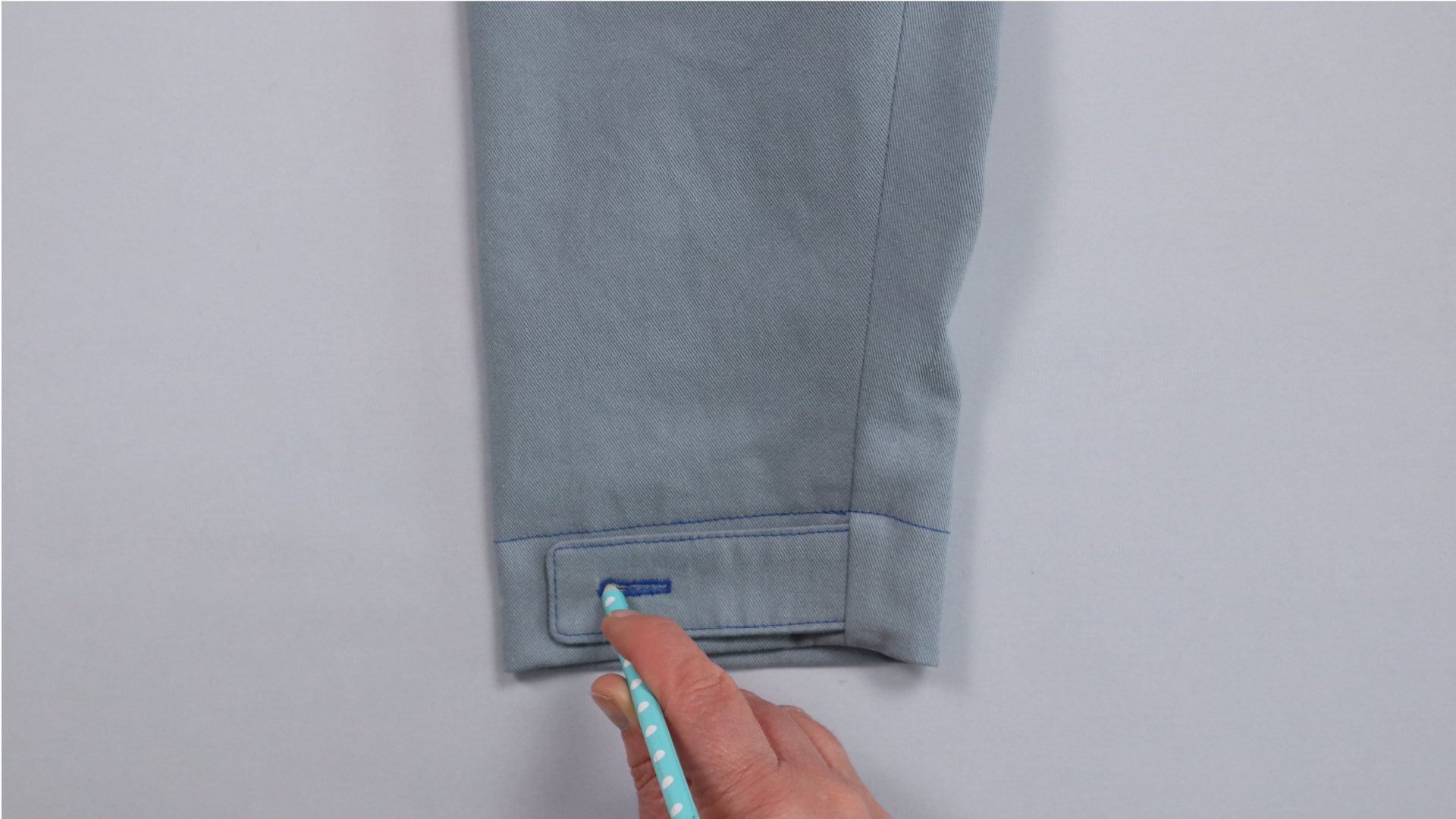
Now the buttons can be attached. I mark the position of the first button through the eye of the buttonhole.

I attach the second button 3.5 cm next to the first button. It is best to place both buttons next to each other on the sleeve hem and decide how much space should be between the two buttons. This is a matter of taste and also depends on the button size.
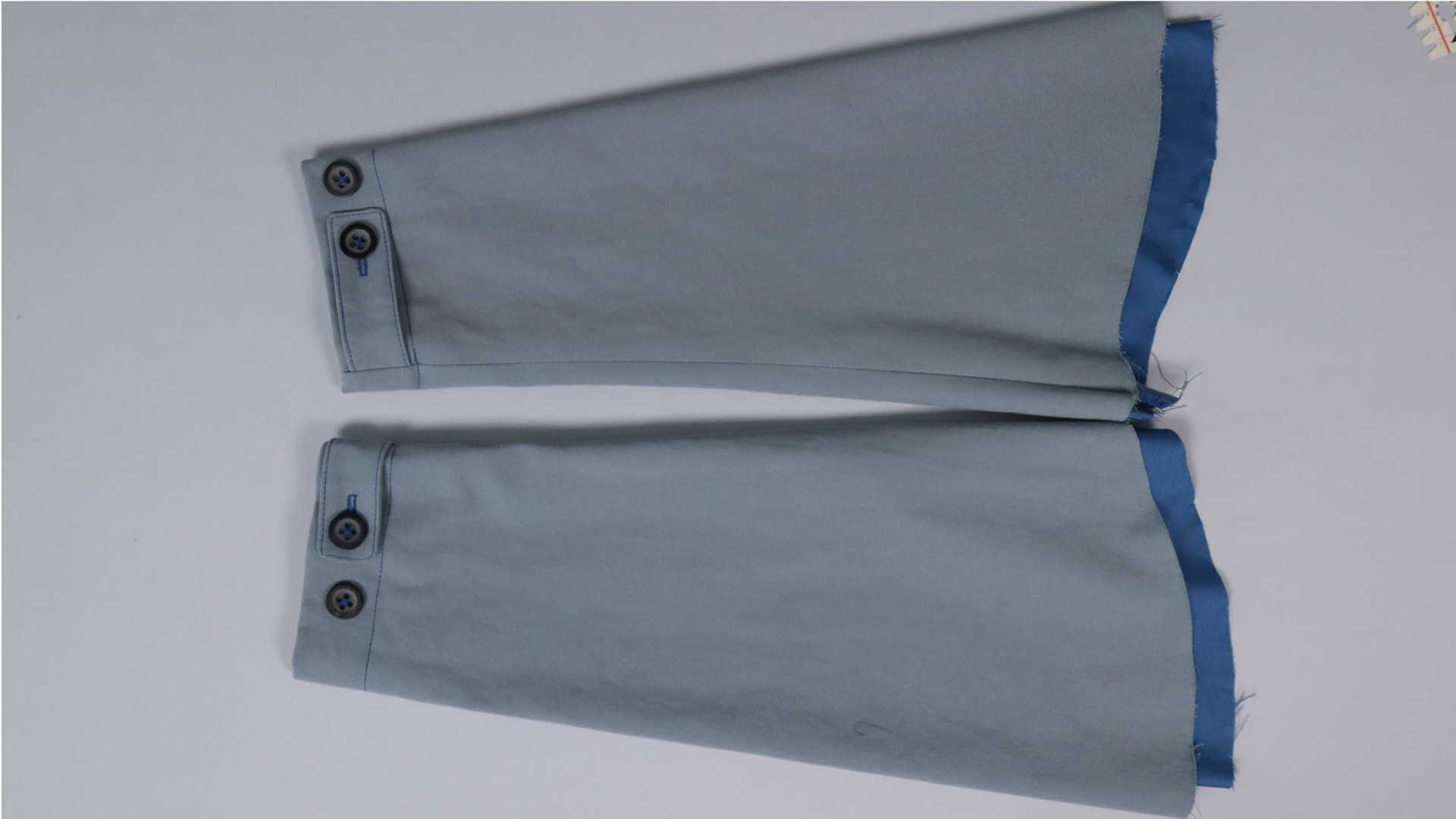
This is what the finished sleeves look like. At the top of the picture is the left sleeve, at the bottom the right one.
Insert sleeves from outer fabric

First, only the outer sleeve is sewn to the outer parka. Here you can see how the left sleeve is attached to the left armhole.
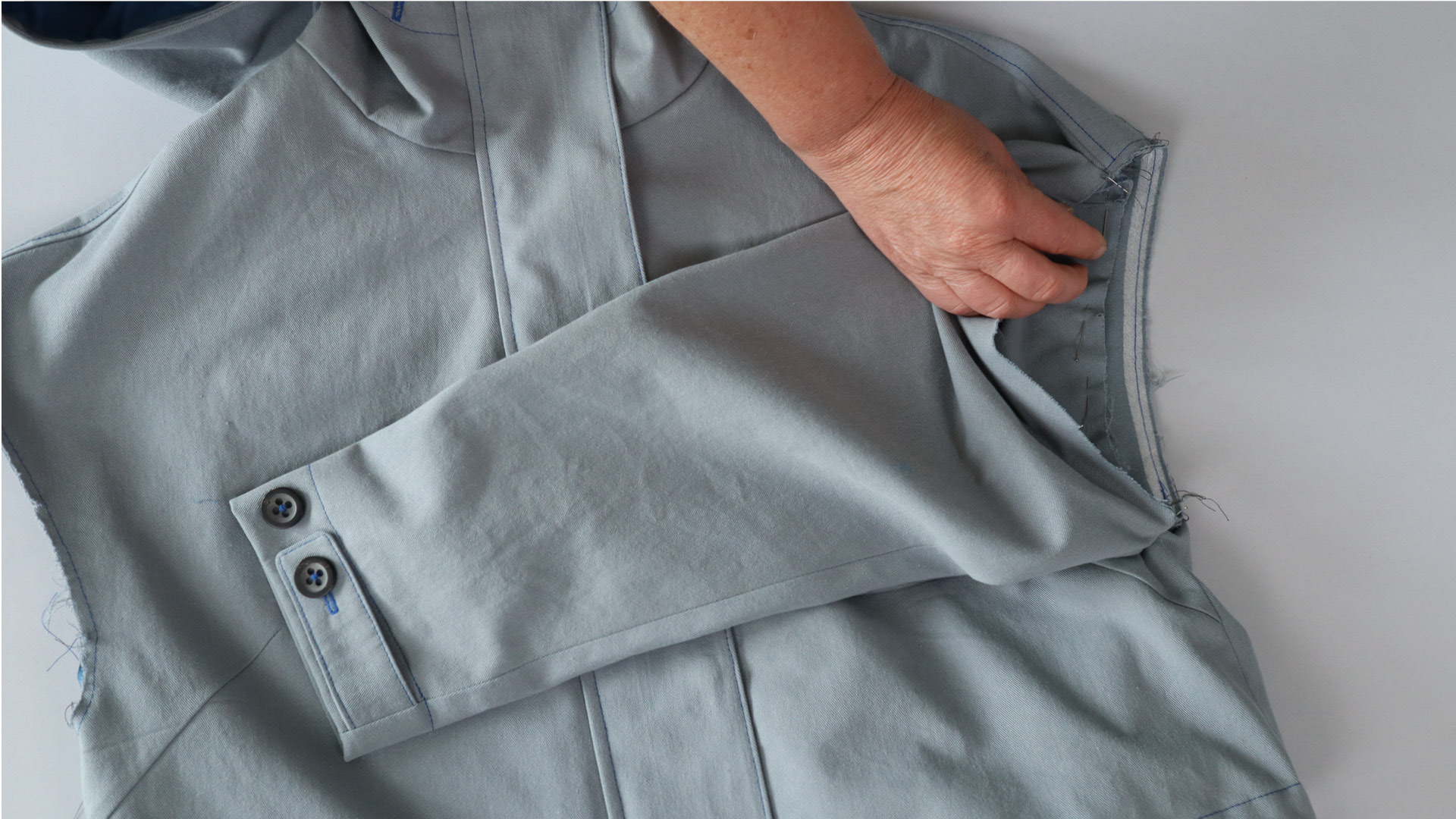
The sleeve is pinned to the armhole, right sides facing. I first pin a piece from the outside before turning the parka and pinning the rest of the sleeve.
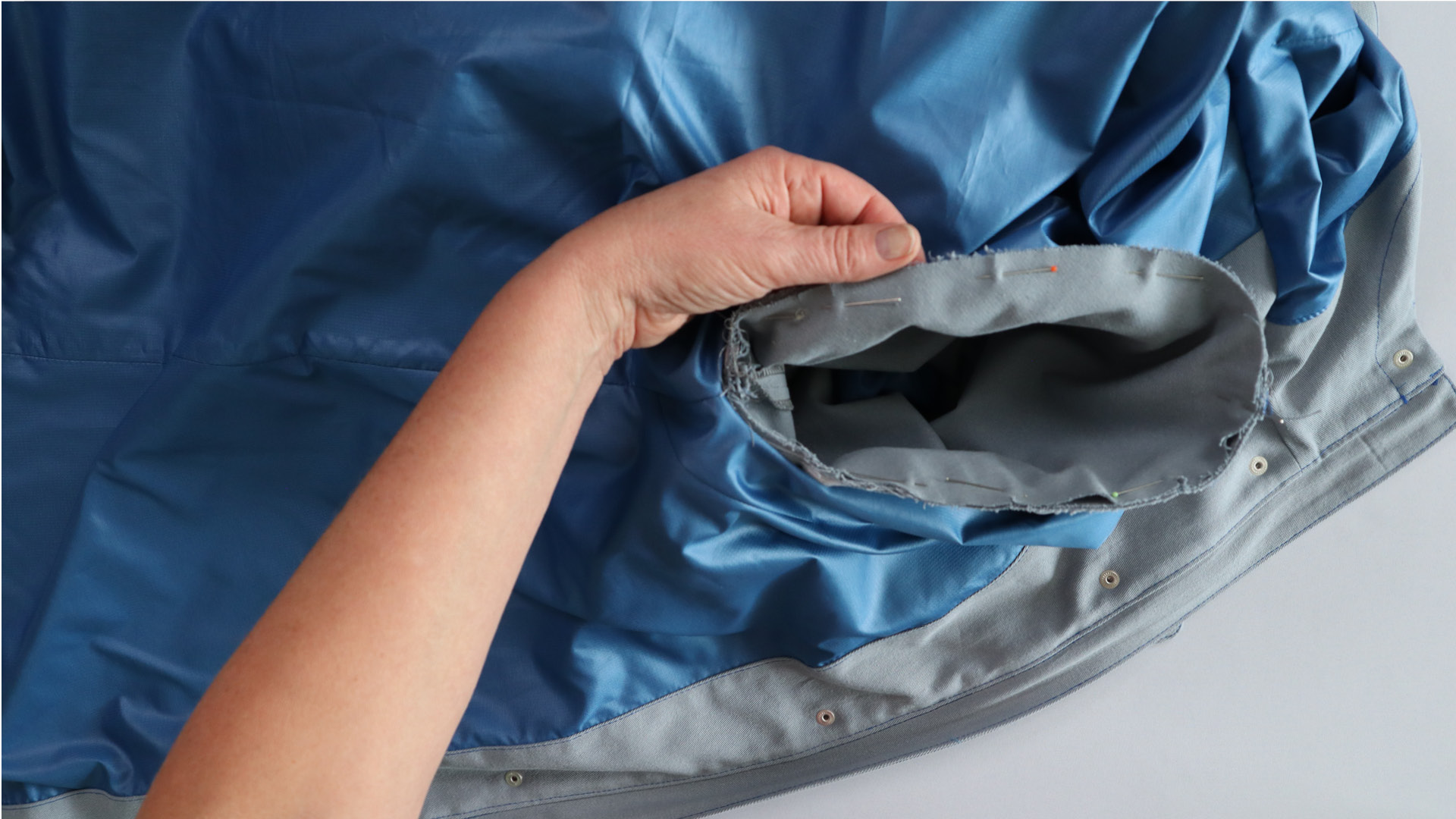 The pinned sleeve.
The pinned sleeve.
The sleeve is pinned all the way around. Make sure that the lining is not caught.
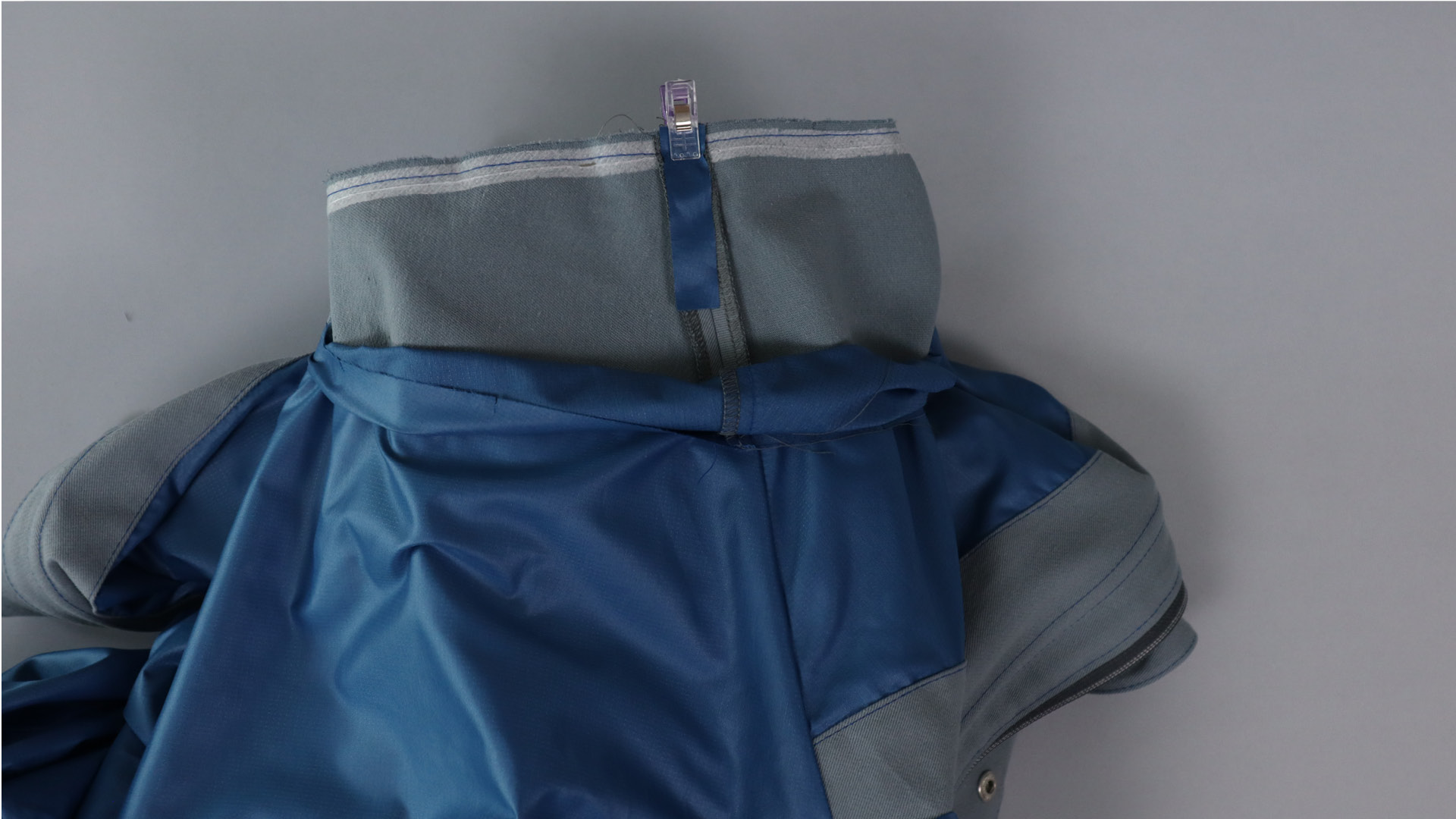 The connecting tape is placed on the shoulder seam.
The connecting tape is placed on the shoulder seam.
I pin a connecting strip exactly onto the shoulder seam.
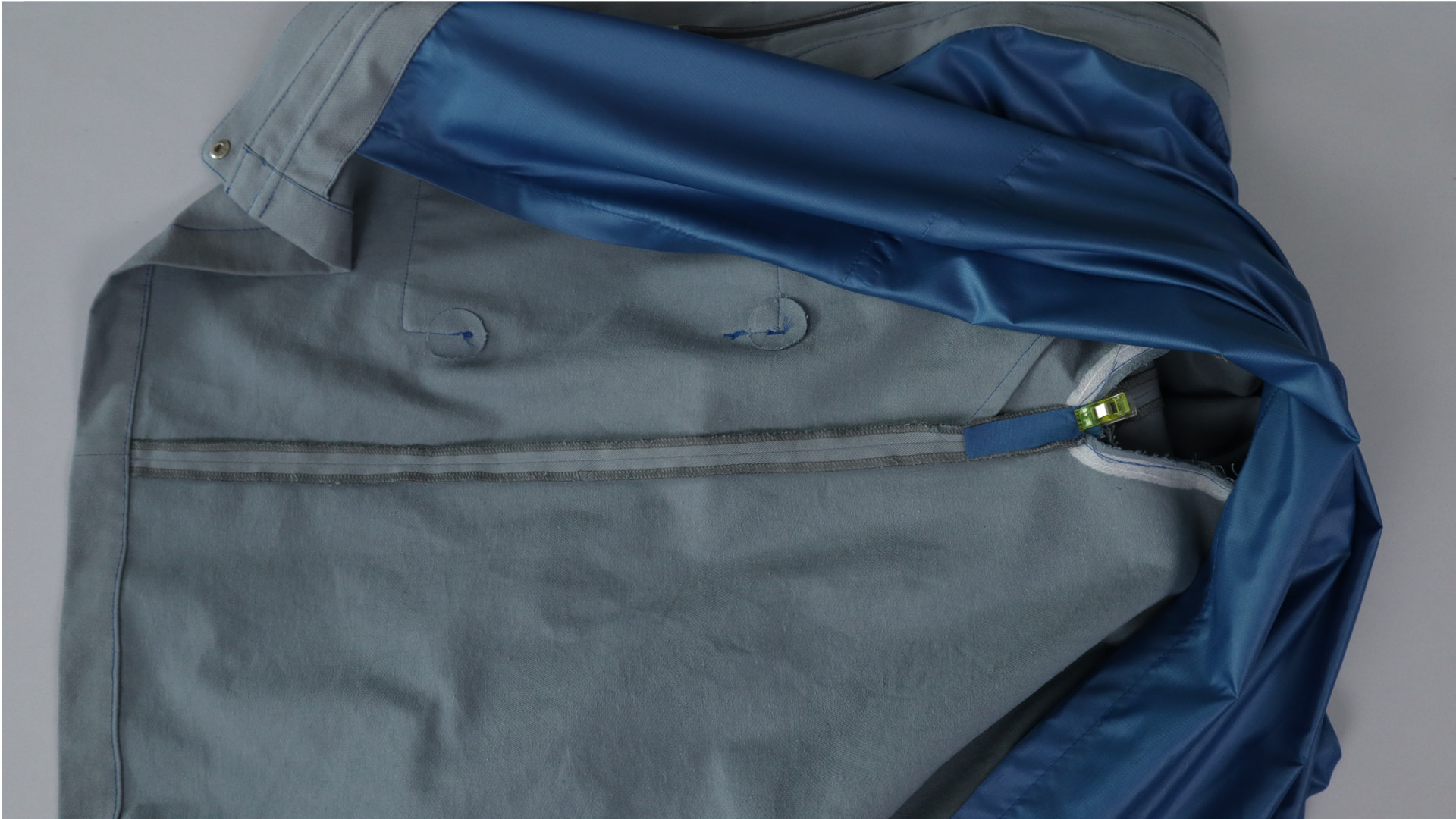
Another one is pinned exactly onto the side seam.

Once the sleeve is sewn in, I press the seam allowances to the sleeve and topstitch them close to the edge.
Sew in lining sleeves
 The lining sleeve is sewn to the lining body.
The lining sleeve is sewn to the lining body.
Now sew on the lining sleeve. First pull it out of the outer sleeve, as shown in the picture, and fold it over to the outside at the armhole.

Then pin the sleeve to the body, right sides facing, and sew it on from the sleeve side. Check again that nothing is twisted before sewing it on.
Finishing the parka with hood
Just a few last steps and your hooded parka is ready!
The connecting strips, which are attached to the outer parka, still need to be connected to the lining.
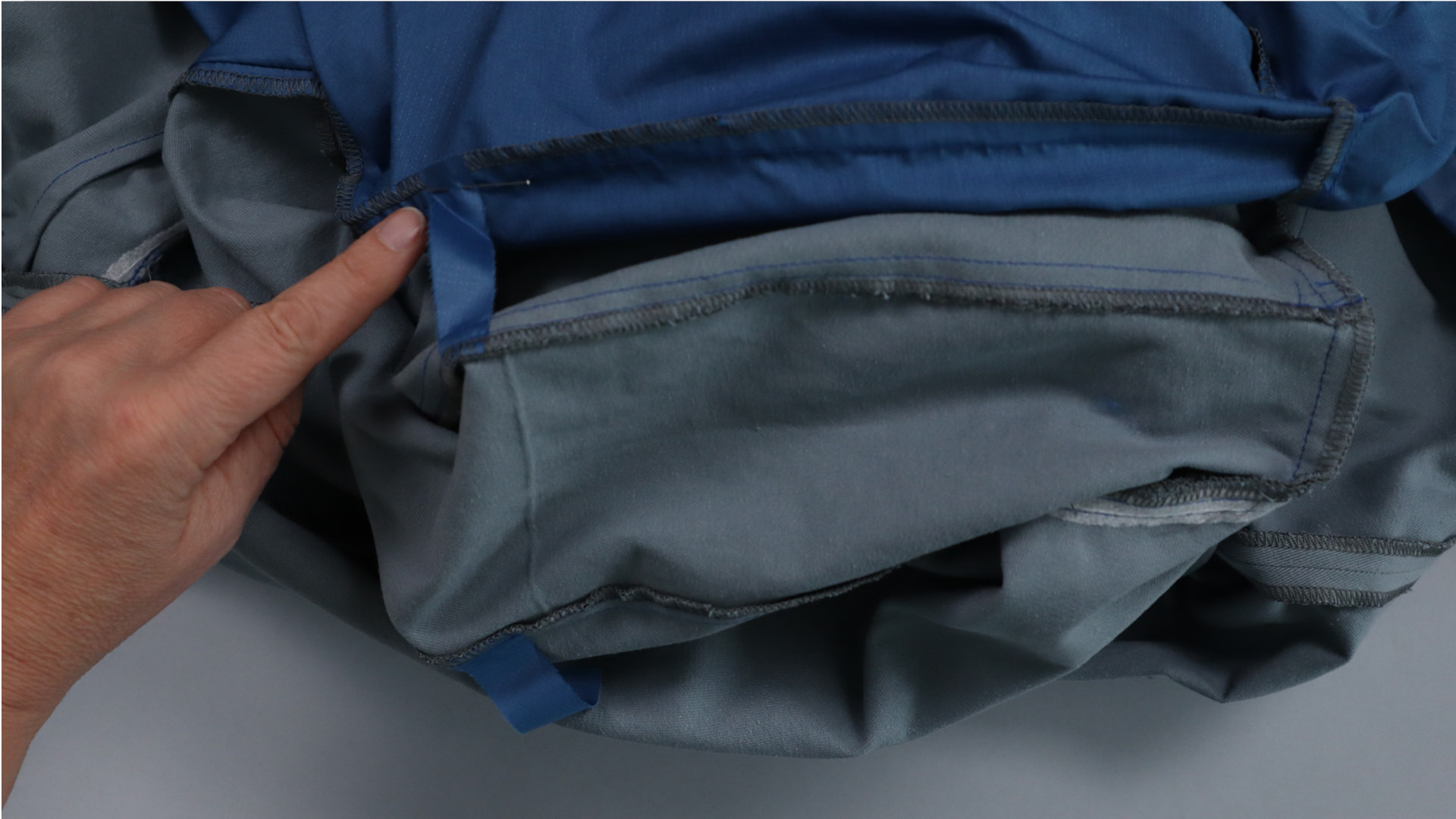
Here you can see the connecting strips on the hood, which are pinned and sewn to the lining. Make sure that the strip on the lining hood is sewn in the same position as on the hood made from the outer fabric.

I repeat this on the shoulder seams and the side seams.
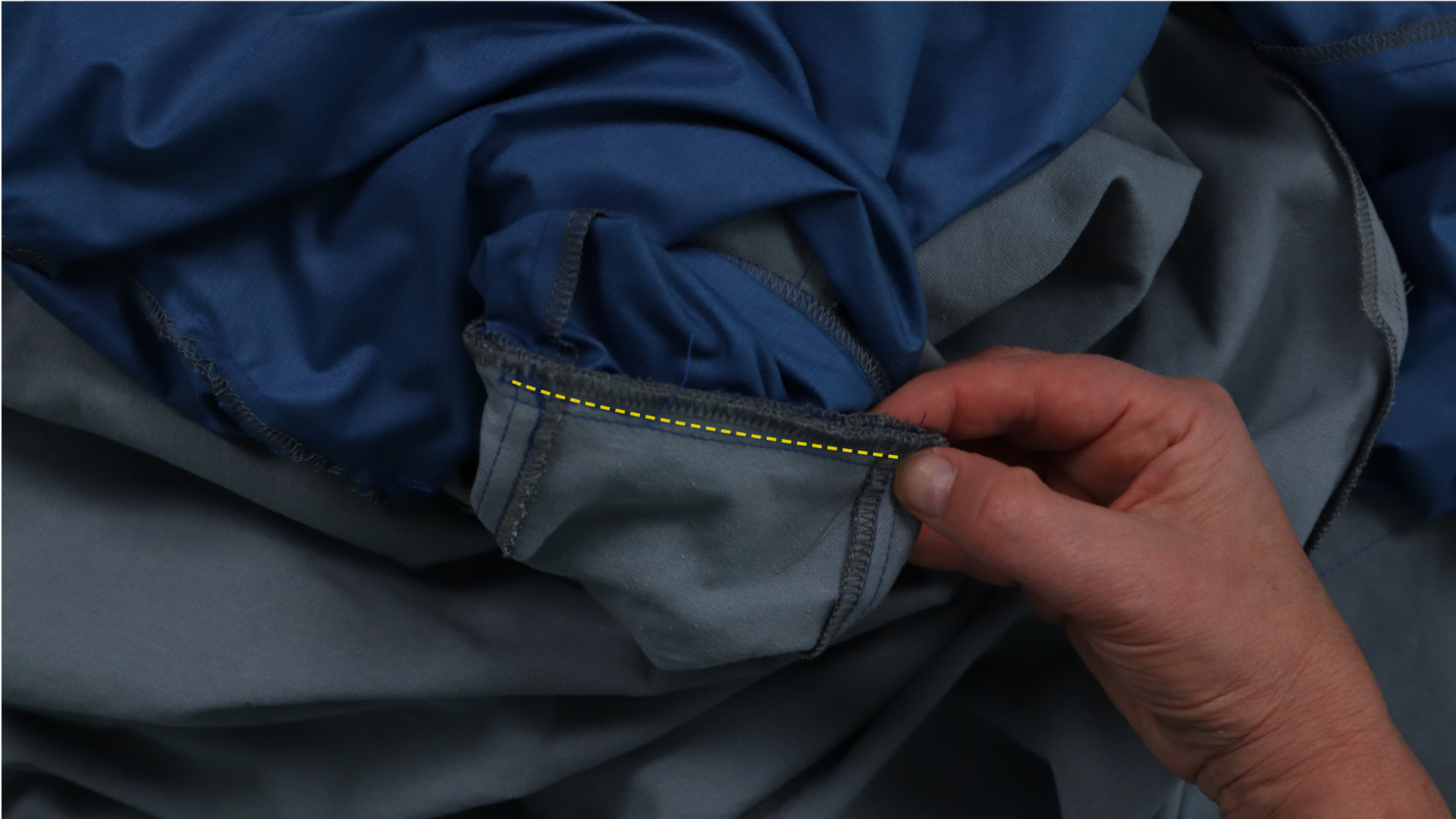
At the center back of the neck hole, I sew the two hoods together in the area of the seam allowances. Make sure you do this so that the seam allowances continue to point towards the hood and sew back and forth several times in the area of the hanger to provide additional stability.
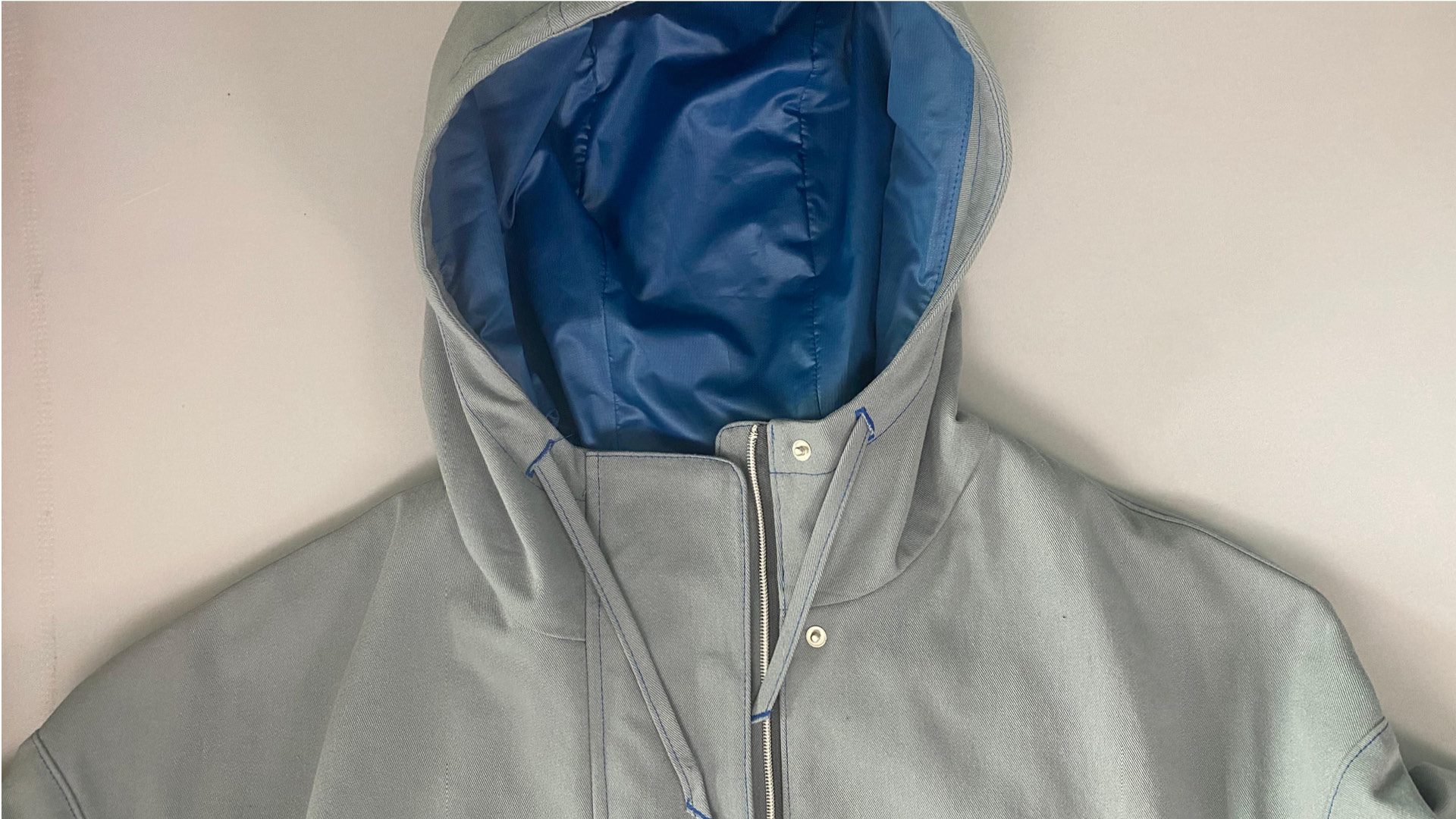 Drawstring hood.
Drawstring hood.
Now all you have to do is pull the ribbon or cord into the hood and your new hooded parka is ready!
Congratulations and have fun with it!
Show your work
We would be delighted if you showed your work in our Facebook group and/or on Instagram! Link us on Instagram with @smartpattern and use the hashtag #smartpatternparka so that we can find you.
Browse through our store and discover your next project!
-
Sale! Original price was: 14,90 €.0,00 €Current price is: 0,00 €.Incl. tax
-
Sale! Original price was: 14,90 €.0,00 €Current price is: 0,00 €.Incl. tax
-
18,90 €Incl. tax
-
Sale! Original price was: 14,90 €.0,00 €Current price is: 0,00 €.Incl. tax
Legal matters
MISUSE and COMMERCIAL USE
These sewing instructions and the pattern (including all texts, illustrations, photos and graphics) are protected by copyright. Any distribution or reproduction is not permitted. If you would like to sell a product commercially, which is sewn according to this pattern, please contact us by e-mail: lizenzen@smartpattern.de







